Italy Itinerary: How to See All of Italy’s UNESCO Sites
43 min readI’ve been lucky enough to visit Italy four times in the last decade, visiting busy cities like Milan and Rome, as well as quieter spots like Tuscany and the Amalfi...
The post Italy Itinerary: How to See All of Italy’s UNESCO Sites appeared first on Teaspoon of Adventure.
I’ve been lucky enough to visit Italy four times in the last decade, visiting busy cities like Milan and Rome, as well as quieter spots like Tuscany and the Amalfi Coast (in shoulder season!).
But I’ve always dreamed of taking a longer trip through Italy. I used to tell my husband, Colin, that I’d want to spend a month or two exploring Italy by train.
Which is how I stumbled upon the idea for this Italy itinerary.
I recently learned that Italy has the most UNESCO World Heritage Sites in the world with a whopping 59. As soon as I saw them all on a map, my inner travel planner got very excited.
How awesome would it be to plan an itinerary around Italy that visits every single one of its UNESCO World Heritage Sites?
Pretty freakin’ awesome! (Well, at least I think so. I’ll assume you agree with me if you keep reading.)
Below I’ve mapped out a complete itinerary – from Sicily to Genoa – visiting every single one of Italy’s UNESCO World Heritage Sites. I’ve included travel times, how to get from place to place and how many nights I think each stop needs.
This will probably be the most comprehensive Italy itinerary you’ll ever come across! No region is skipped and no ancient rock is unturned.
Ready to explore the very best of Italy? Let’s dive into the itinerary!
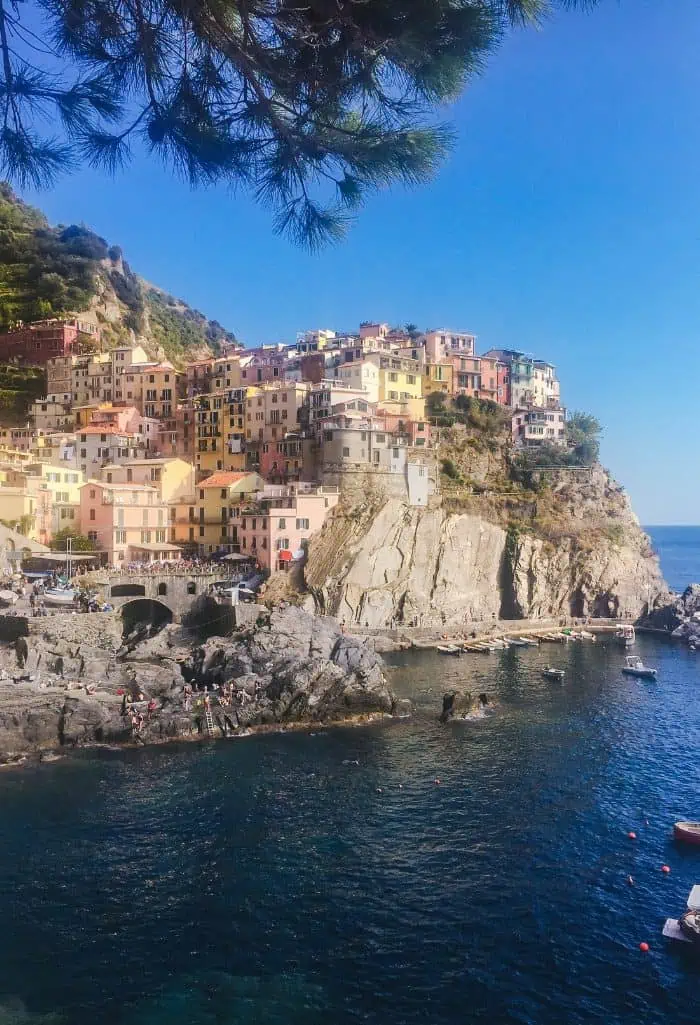
Disclosure: Some of the links below are affiliate links, meaning if you click through and make a purchase, I will earn a small commission at no additional cost to you. Thanks for your support!
But first, what’s a UNESCO World Heritage Site and why does Italy have so many?
UNESCO World Heritage Sites are sites of “cultural and natural heritage around the world considered to be of outstanding value to humanity.” They can be anything from churches and historic city centres to lakes, forests or rock carvings.
These sites are nominated by their home country, decided upon by an international committee and then protected under the UN World Heritage Program.
As of 2024, Italy has the most UNESCO World Heritage Sites with 59 (followed by China with 57, then France and Germany with 52 each).
Is that because Italy is just more culturally and naturally important than every other country in the world? Probably not.
Importance is extremely subjective and the UNESCO list definitely leans more towards the West. But even if the system is flawed, I still think Italy deserves her flowers. After all, there’s a reason we’re all obsessed with the Roman Empire, right?
Even if you don’t think Italy has the most cultural and natural points of importance in the world, it sure does have a lot. And I think they’re worth seeing!
You can check out all of Italy’s 59 world heritage sites here, or throughout my itinerary below!

What you need to know about this Italian itinerary
All right, before I dive deep into my Italy itinerary, you should know a few things:
1. This itinerary is designed to visit all of Italy’s 59 UNESCO sites. (Though you probably figured that our from the title.)
While I used the UNESCO sites as a framework, this itinerary does visit some non-UNESCO sites too. To make it clear, I’ll highlight every UNESCO site as they come up.
2. This itinerary goes from south to north. This trip starts in Sicily and wraps up in Genoa, however, you can do it in reverse. You could also just pick a point in the middle and start from there!
3. This itinerary is planned for just under 90 days. I planned it this way so us non-European citizens could see everything without overstaying our Schengen Zone allowance.
However, you don’t have to complete it all at once! If you don’t have three months to kick around Italy, you can do this trip over many years or just do your favourite parts.
If you want to see all 59 sites but only have two months, you can speed things up. If you’re planning a year long trek through Italy (can I come?), feel free to take things slow.
4. This itinerary is 2/3 train rides and 1/3 rental cars. There’s also a couple of flights and a ferry thrown in there.
If you don’t drive (I don’t, but thankfully my husband does), I’ll include alternative transit options when I list rental cars.
Italy UNESCO itinerary map
Itinerary breakdown
59 UNESCO World Heritage Sites, 87 days and ONE EPIC ITINERARY!
Here’s the breakdown of your UNESCO route through Italy:
- Day 1-13: Sicily (7 UNESCO sites)
- Day 14-18: Puglia (3 UNESCO sites)
- Day 19-25: Naples & the Amalfi Coast (5 UNESCO sites)
- Day 25-29: Rome (4 UNESCO sites)
- Day 30-33: Sardinia (1 UNESCO site)
- Day 34-50: Tuscany, Umbria & Marche (12 UNESCO sites)
- Day 51-65: Emilia Romagna & Veneto (14 UNESCO sites)
- Day 66-73: Northeast Italy (4 UNESCO sites)
- Day 74-79: Lombardy (5 UNESCO sites)
- Day 80-87: Piedmont & Liguria (4 UNESCO sites)
Don’t have 87 days to spend in Italy? Don’t panic!
Like I said above, you don’t have to complete this itinerary all in one trip. Spend a week or two seeing the UNESCO sites in a few areas, and then come back for more on your next trip!
And remember, each UNESCO site will be highlighted like this!
Day 1-13: Sicily
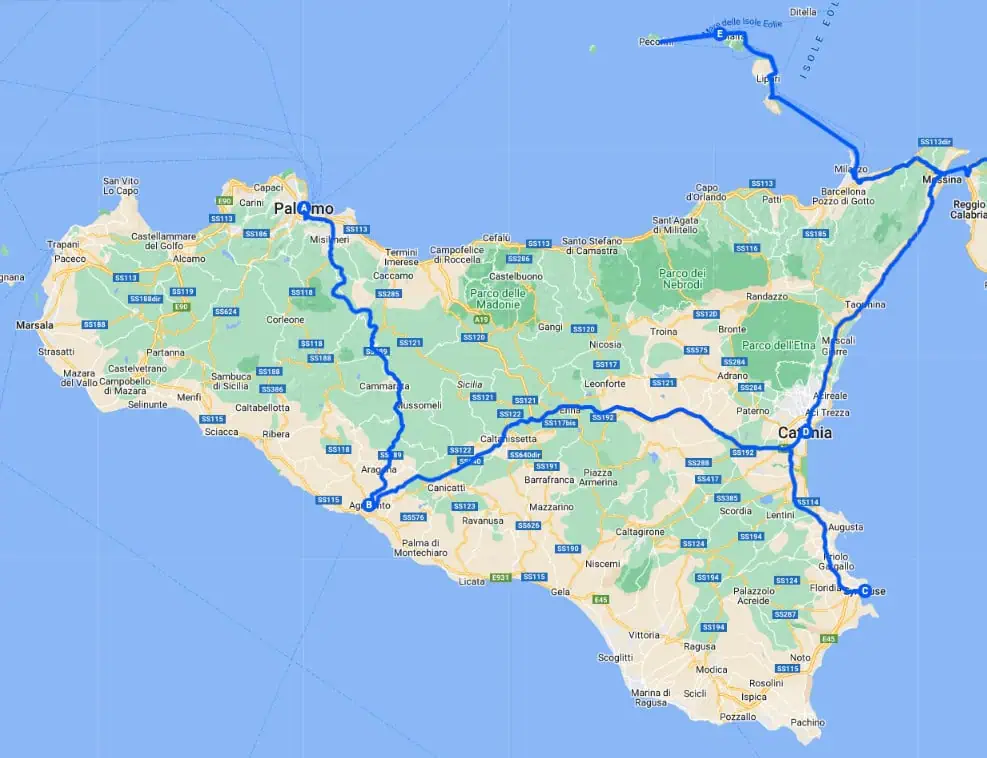
We’ll start our itinerary in southern Italy, down off the toe of the boot in Sicily. Sicily is known for its rich history, stunning coastlines, sweltering summer temperatures and slightly seedy mafia ties.
But even if you’re scared to sunburn (me) or didn’t watch The Godfather (also me), there’s plenty for you to enjoy in Sicily. Personally, I’m looking forward to the gorgeous architecture and trying cannoli in its birthplace!
Stops in Sicily:
- Palermo (3 nights)
- Agrigento (1 night)
- Syracuse (3 nights)
- Catania (2 nights)
- Aeolian Islands (3 nights)
- Catania (1 night)
7 UNESCO Sites: Arab-Norman Palermo and the Cathedral Churches of Cefalù and Monreale, Archaeological Area of Agrigento, Villa Romana del Casale, Syracuse and the Rocky Necropolis of Pantalica, Late Baroque Towns of the Val di Noto, Mount Etna, Isole Eolie (Aeolian Islands)
Palermo (3 nights)
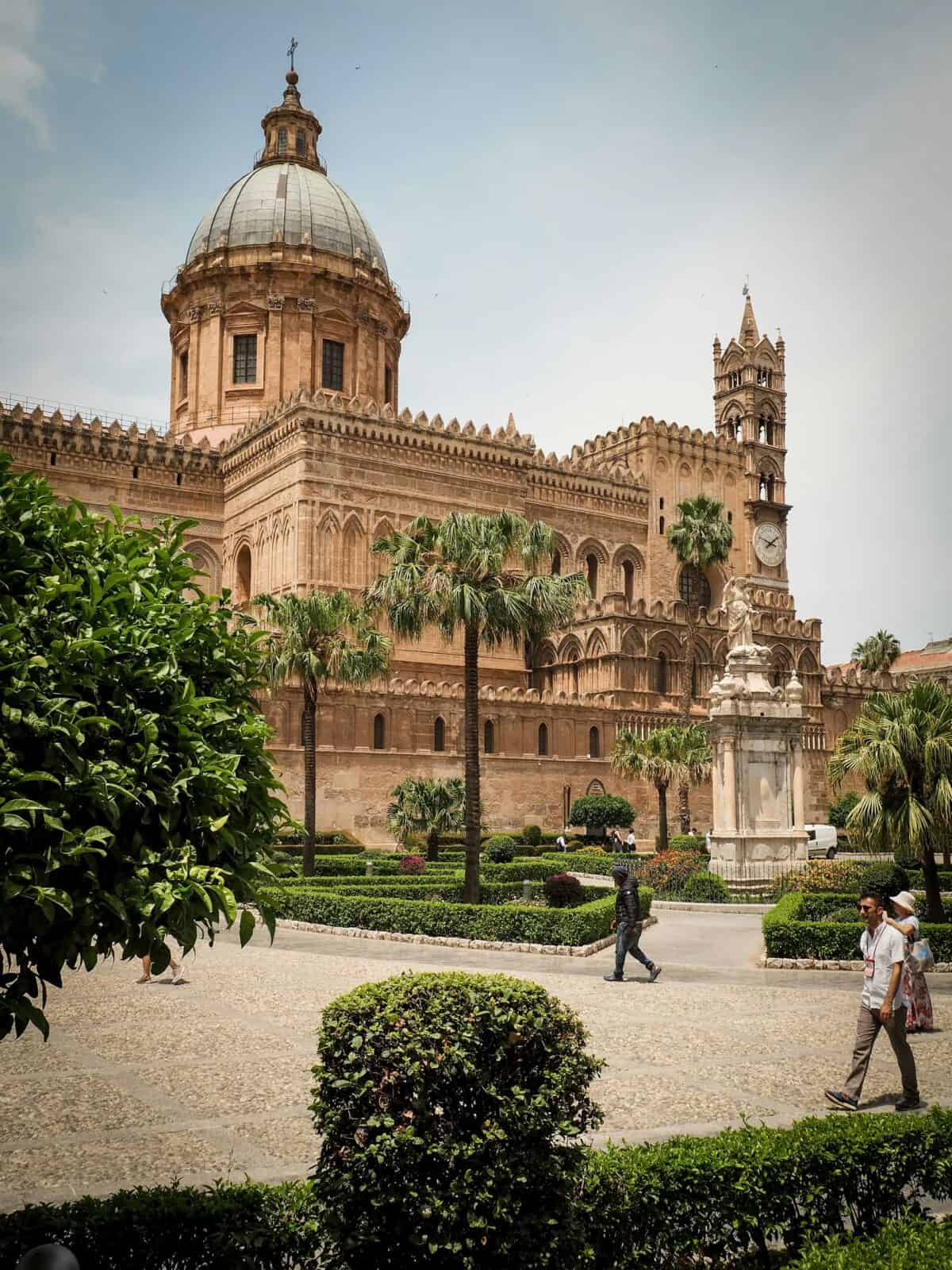
Fly into Palermo where you can spend time getting your bearings, getting over jet lag and getting excited for the big trip ahead of you!
On day two, head into the city centre to explore the nine structures that make up Arab-Norman Palermo (and the Cathedral Churches of Cefalú and Monreale). While you’re there, enjoy some of Palermo’s famous street food too.
On day three, you can continue exploring Palermo – perhaps take a food tour, visit the Norman Palace or see a show at Teatro Massimo. Or you can get extra credit on your UNESCO homework by heading to Cefalu or Monreale to see their cathedrals.
Or go on a day trip to the Temple of Segesta, which isn’t a UNESCO Site, but really should be!
Agrigento (1 night)
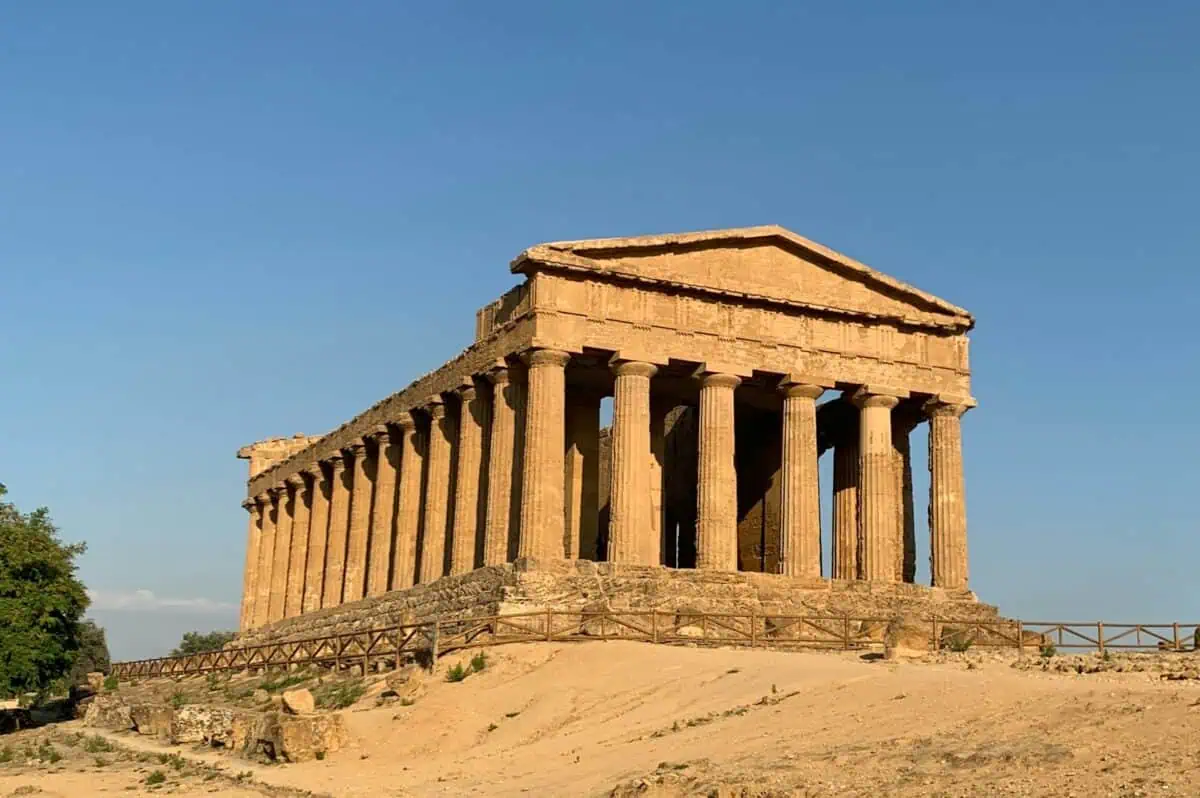
If you’re willing and able to rent a car, pick one up from Palermo this morning. You’ll have this car for most of your time in Sicily, so make sure you pick a good one!
Drive from Palermo to Agrigento (2 hours) and head to the Archaeological Area of Agrigento, aka the Valley of the Temples. Check out the impressive temples and structures dating back to Agrigento’s founding as a 6th Century BCE Greek colony.
Don’t want to drive? Go on this Valley of the Temples and Villa Romana del Casale day tour from Palermo. You get to see two UNESCO sites, you don’t have to rent a car & you can stay based in Palermo!
Syracuse (3 nights)
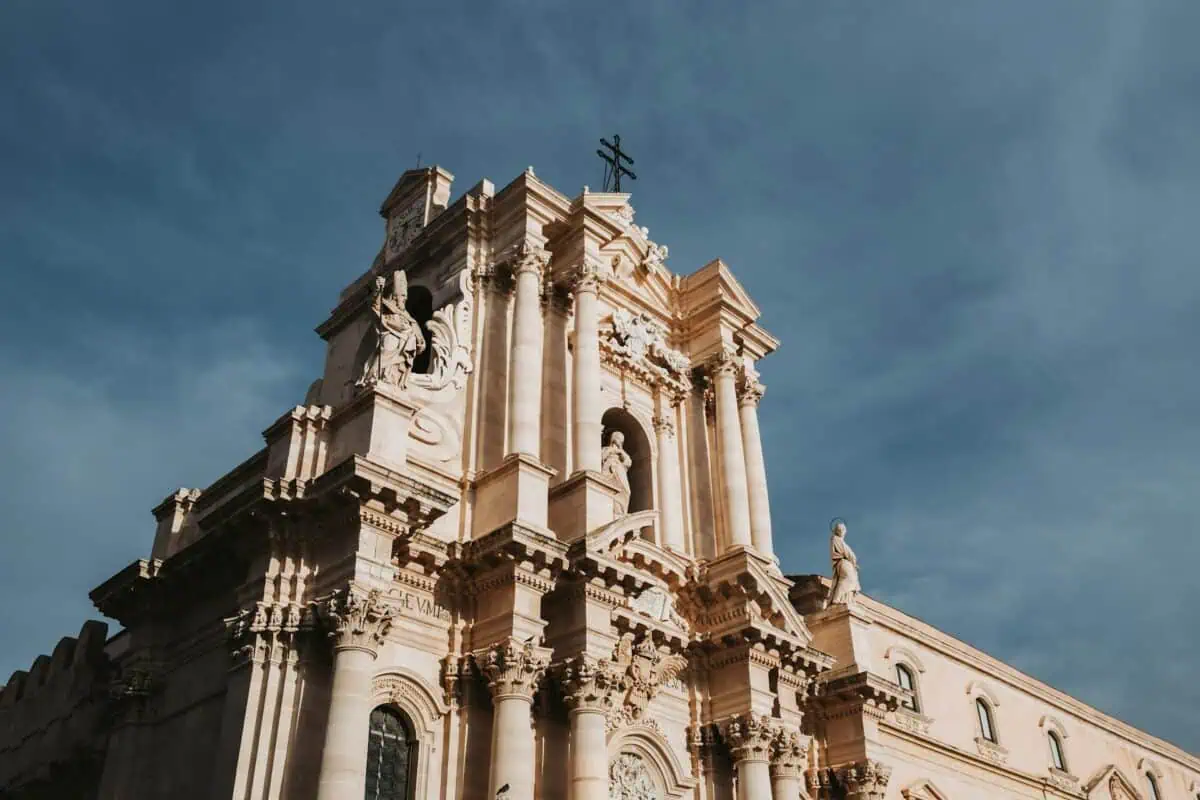
After your night in Agrigento, drive to Villa Romana del Casale (80 mins) where you’ll explore this luxurious Roman villa, complete with stunning mosaics in every room.
From there, you’ll continue driving onto your next base, Syracuse (2 hours). In my research on Sicily, Syracuse is the city I’m most excited about.
Not driving? The best option is to see the Valley of the Temples and Villa Romana del Casale on this day tour from Palermo. Then, you can bus from Palermo to Syracuse (3.5-4 hours, direct or 1 change) on Day 5.
Once you arrive in Syracuse – either by car or by bus – you’ll wake up the next morning and explore Ortigia, the historic centre of the city. This is where you’ll find the Syracuse Cathedral, Temple of Apollo, Fountain of Diana and other impressive Greek landmarks.
Those Greek landmarks make up one half of your next UNESCO site: Syracuse and the Rocky Necropolis of Pantalica.
If you’d like bonus marks, you can see the other half on your third day in Syracuse by driving out to the Rocky Necropolis (45 mins) or visiting on a private walking tour.
Catania (2 nights)
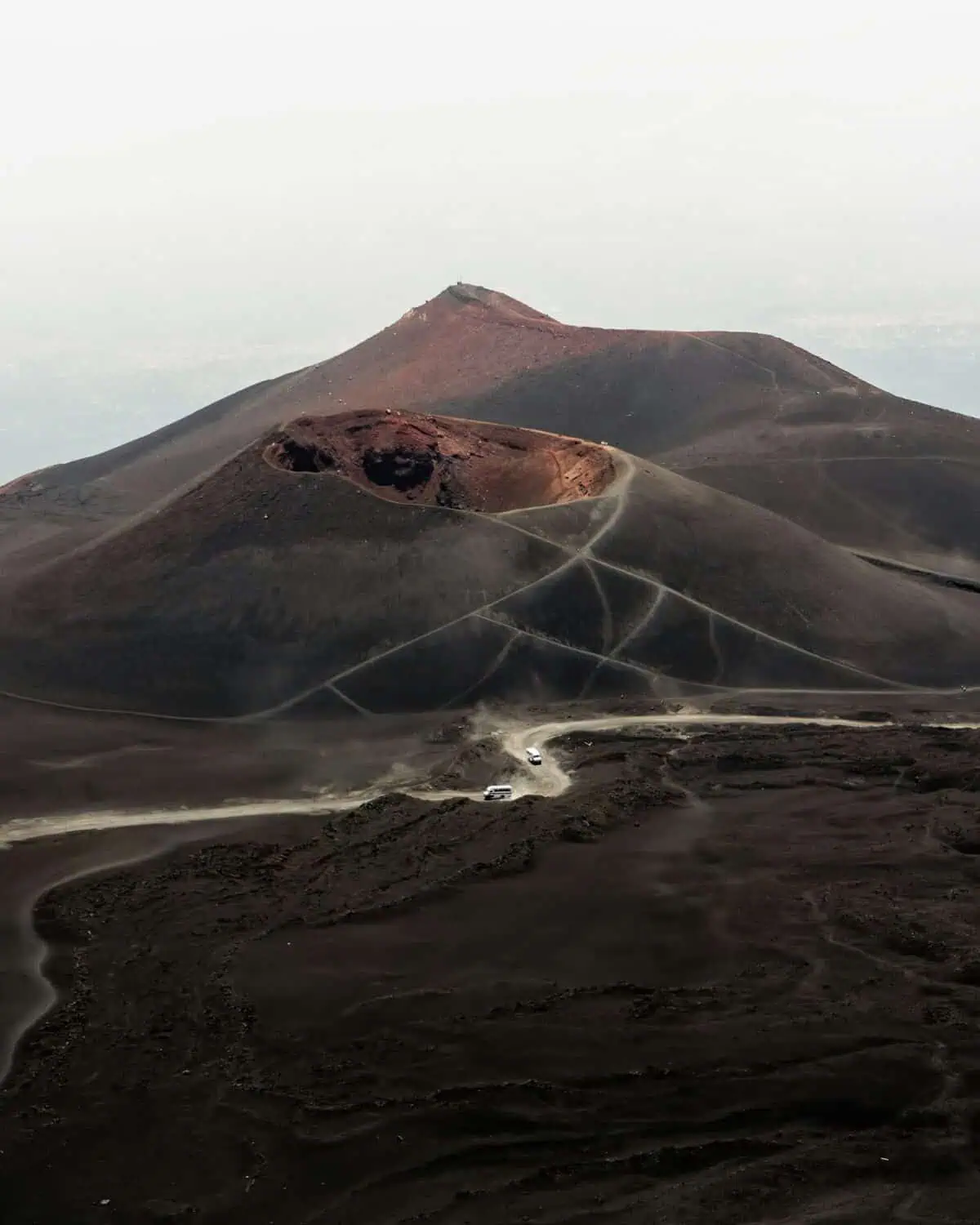
Wake up early on Day 8 because it’s time for some volcanic exploration!
First, you’ll drive one hour from Syracuse to Catania. Catania is the industrial and commercial centre of Sicily. It’s also one of the Late Baroque Towns of the Val di Noto, thanks to its architecture change after the 1693 earthquake.
Split today between exploring Catania and driving to Mt Etna (1 hour), the famous (and active!) stratovolcano on Sicily’s east coast. If you’d prefer not to drive yourself, you can take a tour to Mt Etna from Catania instead, or an early morning bus.
Once at Mt Etna, you can go on a guided hike and cable car ride or check out the sunset via jeep.
The next morning, drive to Taormina (1 hour), known as the Pearl of the Ionian Sea. Check out Teatro Antico di Taormina, see the water views from Isola Bella, and enjoy people watching and dining in Piazza IX Aprile.
While not a UNESCO site, I think Taormina definitely looks worth stopping in for the day. After your full day here, drive back to Catania for the night and return your rental car.
Not driving? Take a direct bus from Syracuse to Catania (55 mins). From there, you can take a day tour to Mt Etna on your first day and a bus (55 mins) or day tour to Taormina on your second.
Or combine them both on this Etna & Taormina tour from Catania!
Aeolian Islands (3 nights)
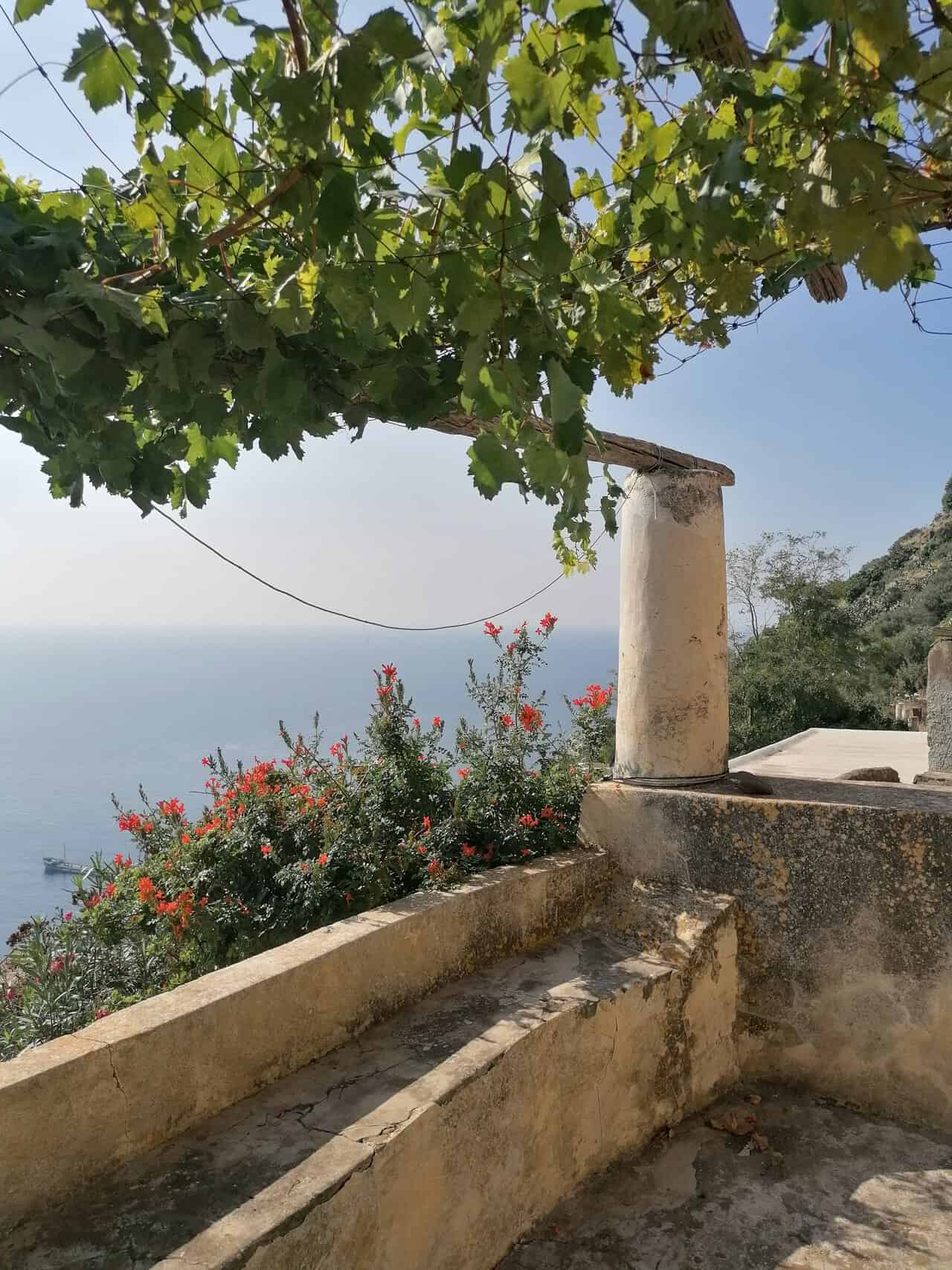
Your final itinerary stop in Sicily, and final UNESCO site, is the Aeolian Islands. They made the UNESCO list thanks to their ongoing ability to “enrich the field of vulcanology” but to me, they just look beautiful!
From Catania, you’ll take a shuttle to the ferry port in Milazzo (1.5-2 hours) and board a ferry for the island of your choosing. Check out this awesome guide to decide which island to stay on.
You won’t need your car while on the islands, and it’s pretty pricy to bring one over on the ferry anyway, which is why I recommend returning your car in Catania and taking a public or private transfer to the ferry port.
Then you’re free to enjoy three days of island hopping, beach chilling, volcano climbing, view appreciating and granita eating good times!
Catania (1 night)
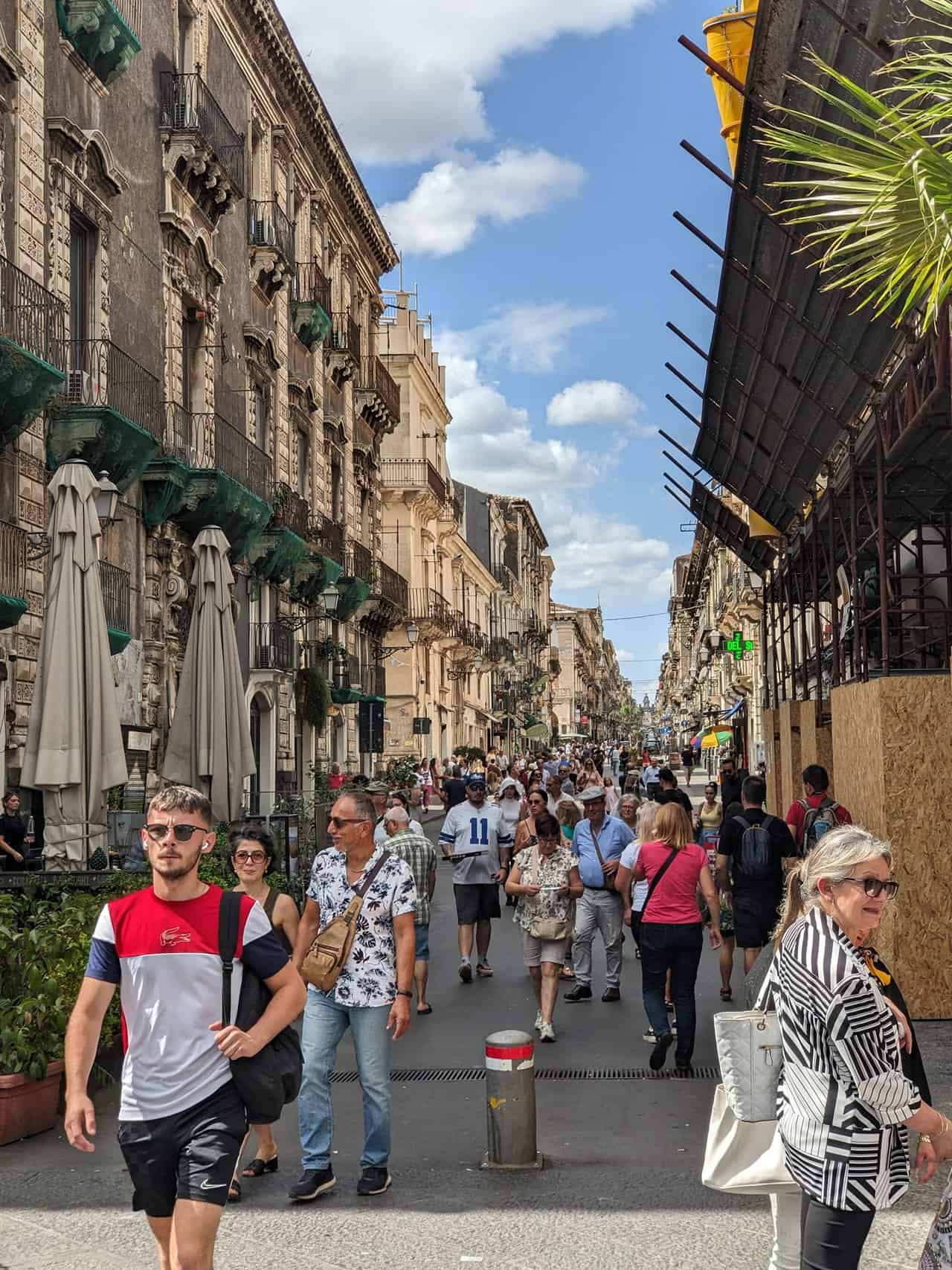
After your time on the Aeolian Islands, reverse your ferry (30-90 mins) and shuttle journey (1.5-2 hours) to return to Catania.
I don’t know about you, but travel days totally exhaust me. Rather than forcing you to move onto your next Italian region today, I’m suggesting you spend one more night in Catania.
Check into a hotel by the airport and sleep off your day of ferries and shuttle buses. Because tomorrow, we’re flying to Puglia!
Day 14-18: Puglia
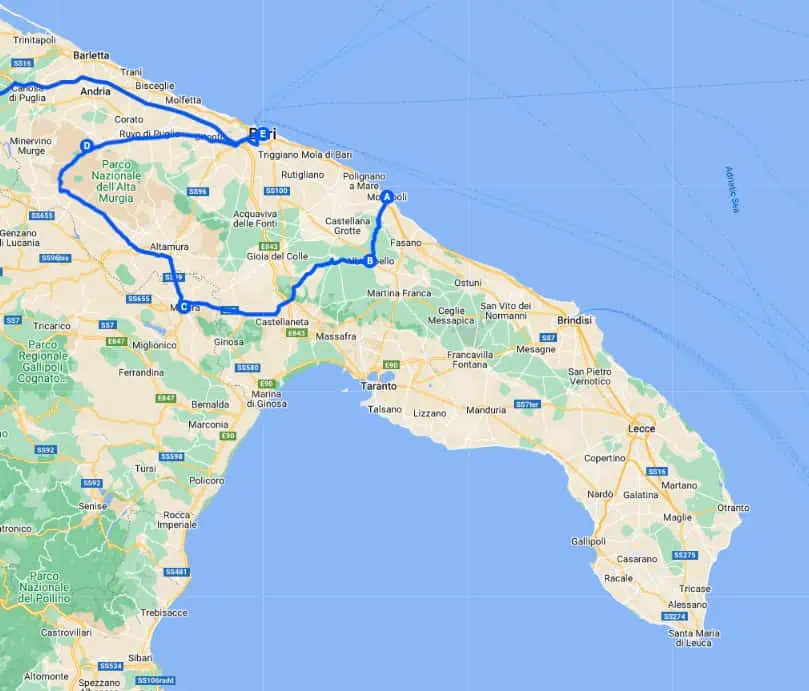
From Sicily, we’re crossing over to the east side to visit Italy’s heel, Puglia.
Puglia is another region of Italy that calls my name. I love the look of all the tiny white-washed towns, choppy coastlines and famous ear-shaped pasta.
While not as famous as its counterpart on the west, the Amalfi Coast, Puglia has a lot to offer. Plus, being less famous also means Puglia is less crowded and less expensive, which we love.
Stops in Puglia:
- Monopoli (4 nights)
- Bari (1 night)
4 UNESCO Sites: The Trulli of Alberobello, The Sassi and the Park of the Rupestrian Churches of Matera, Castel del Monte
Monopoli (4 nights)
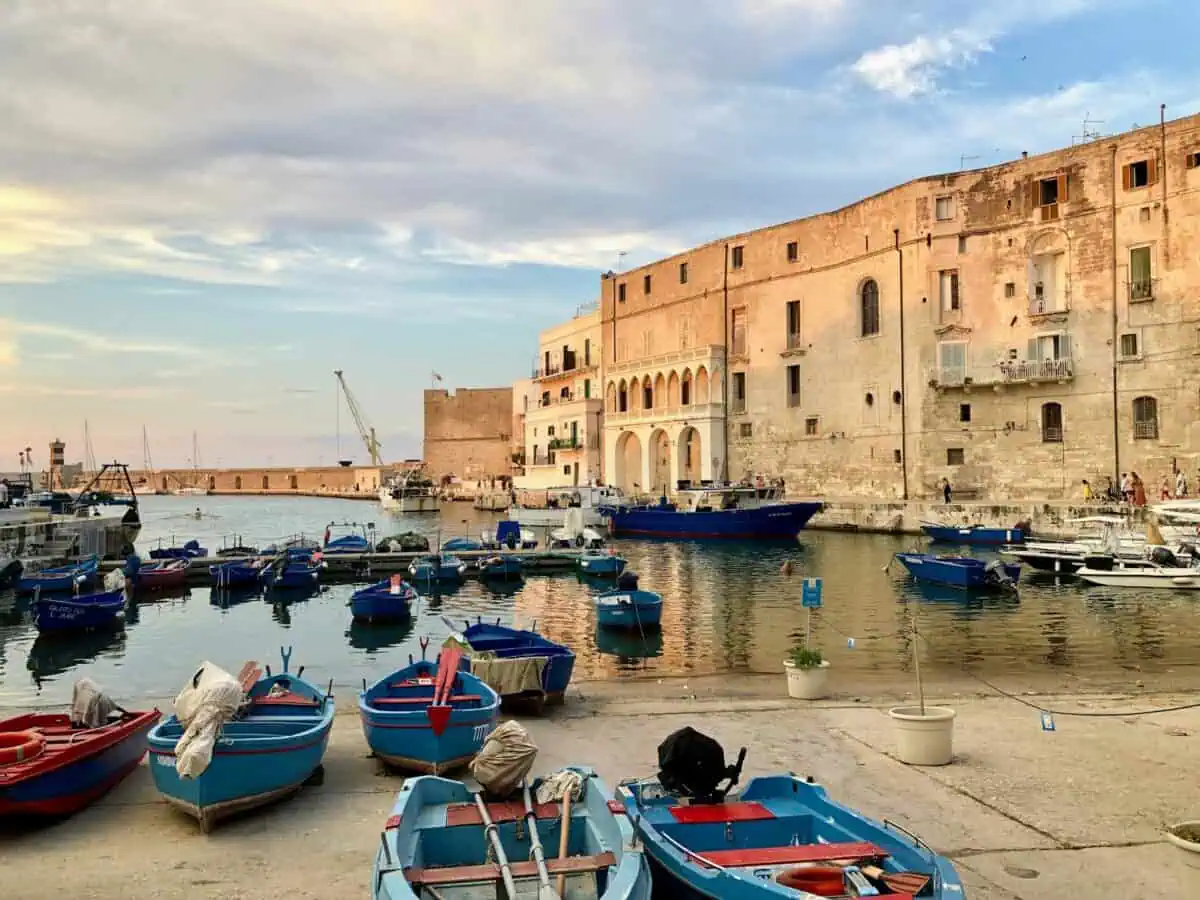
Head to Catania Airport and take a 70 minute direct flight to Bari. From Bari, it’s a quick 30 minute train ride to Monopoli, your first base in Puglia.
After much research, I’ve decided that Monopoli is the perfect base in Puglia. It’s beautiful, low-key, centrally located and not as crowded as Polignano a Mare or as industrial as the big city of Bari.
On your first full day in Monopoli, I recommend you take it easy. Wander around the old town, pop into churches and stores, sit and watch the catch of the day come in, and sip an Aperol Spritz.
If you’re feeling more ambitious, you could jump on a boat tour and visit Polignano a Mare next door.
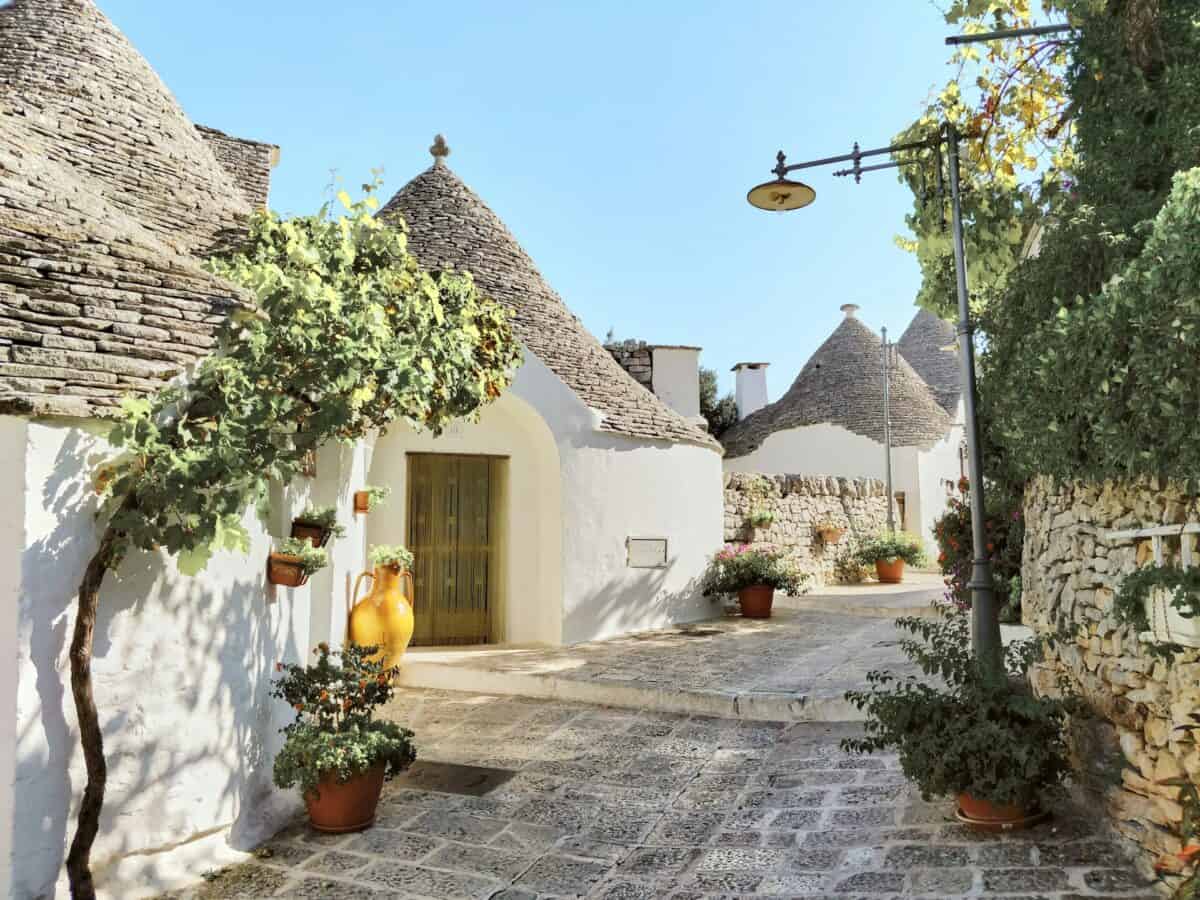
The next day, pick up a rental car and drive to Alberobello (25 mins) where you’ll see The Trulli of Alberobello. Trulli are mortarless limestone dwellings with conical roofs. They look like little bells popping out of the ground!
PS: You may be better off renting your car in Bari, just 30 mins from Monopoli by train, as that’s where you’ll return the car. That way, you can avoid a one-way fee.
While Trulli can be spotted all around Puglia, they’re most concentrated in Alberobello. Enjoy wandering in and around them, then stop at one of these cute towns nearby before returning to Monopoli for the night: Cisternino, Locorotondo or Martina Franca.
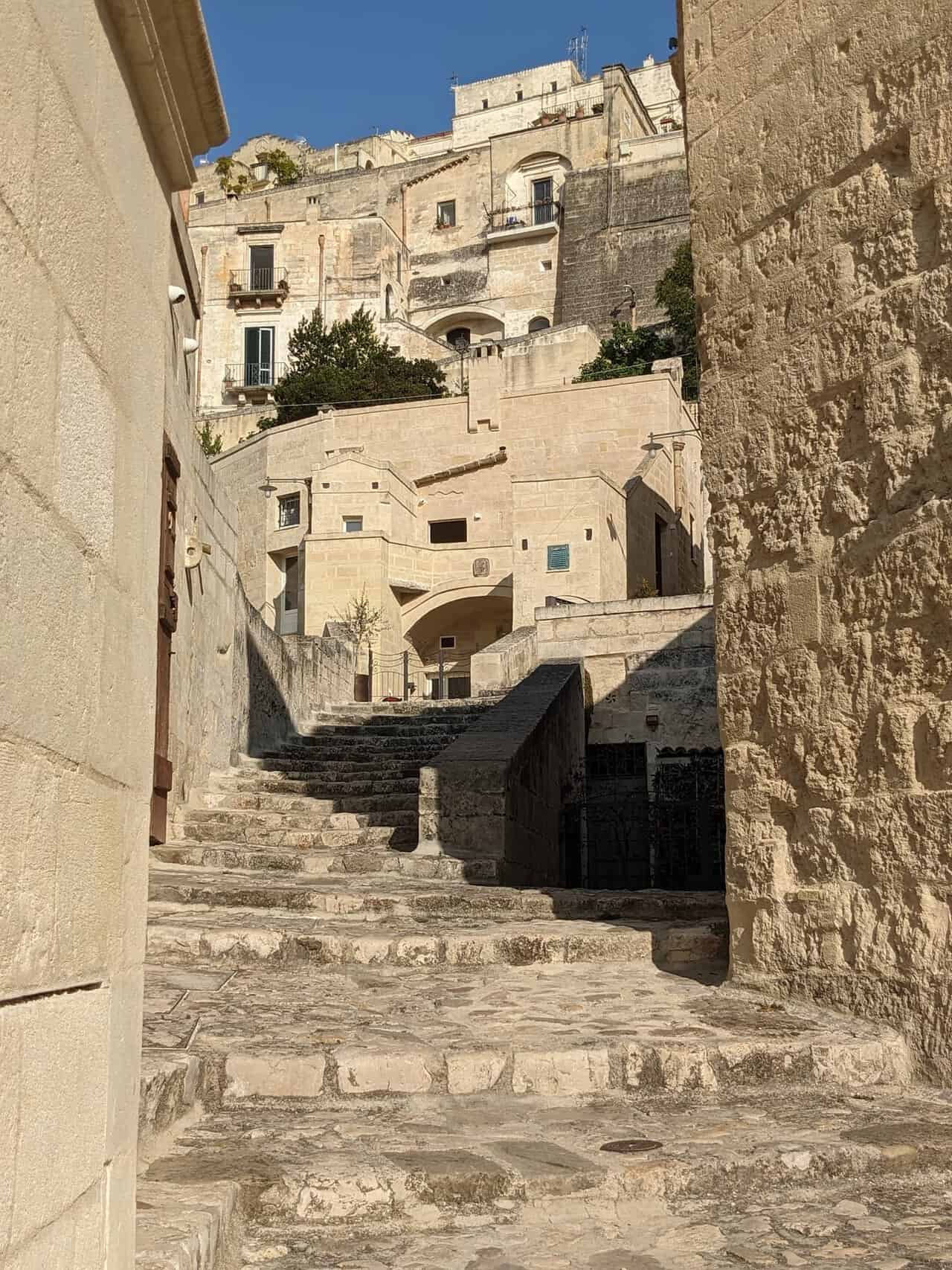
On your final Monopoli day, you’ll head out on another day trip driving 75 minutes to The Sassi and the Park of the Rupestrian Churches of Matera. The Sassi are a series of houses, churches and monasteries built into Matera’s caves.
Beyond the impressive Sassi, spend some time getting lost around Matera’s winding streets and stop to appreciate the city from a viewpoint before you leave. My mom visited Matera in 2023 and raved about it – I can’t wait to see it for myself!
Not driving? You may be better off basing in Bari, as all public transport options from Monopoli to Alberobello and Matera require you to return to Bari. From Bari, it’s a 2+ hour journey to Matera and a 70 minute journey to Alberobello.
As both of those transit journeys are pretty long, you may prefer to take a day tour from Bari to Matera and a day tour from Bari to Alberobello. Or combine them with this day tour to both!
Bari (1 night)
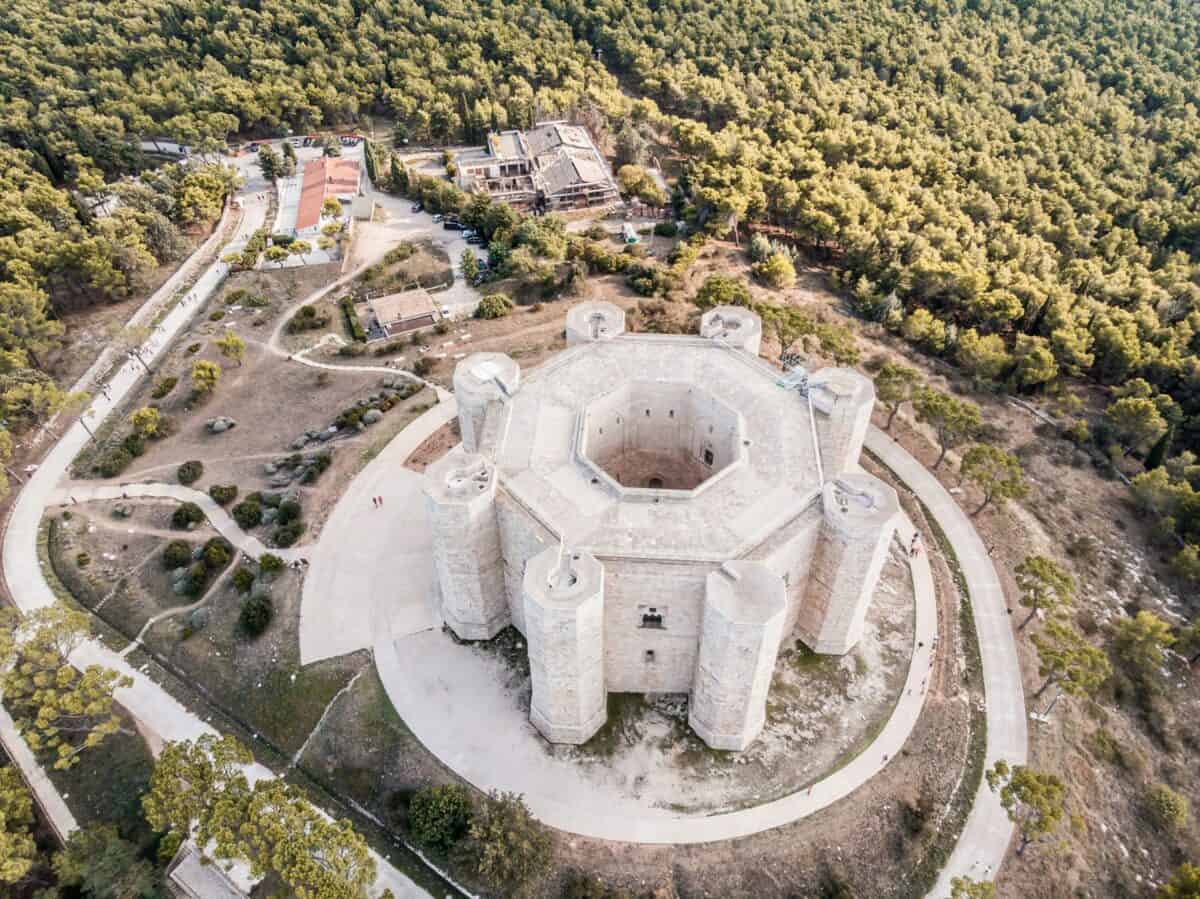
On your final day in Puglia, you’ll check out of your Monopoli accommodation and head to Castel del Monte (75 mins), a 13th Century castle known for its mathematical and astronomical precision.
After spending your day at the castle, rather than coming back to Monopoli, head to Bari (50 mins), as it’s closer to Castel del Monte and tomorrow’s destination. Return you car and enjoy your last night in Puglia before tomorrow’s big train journey.
Not driving? From Bari, it’s about 2.5 hours on transit to Castel del Monte. If you’d rather avoid that, you can take a day tour from Bari to Castel del Monte and Trani.
Day 19-25: Naples & the Amalfi Coast
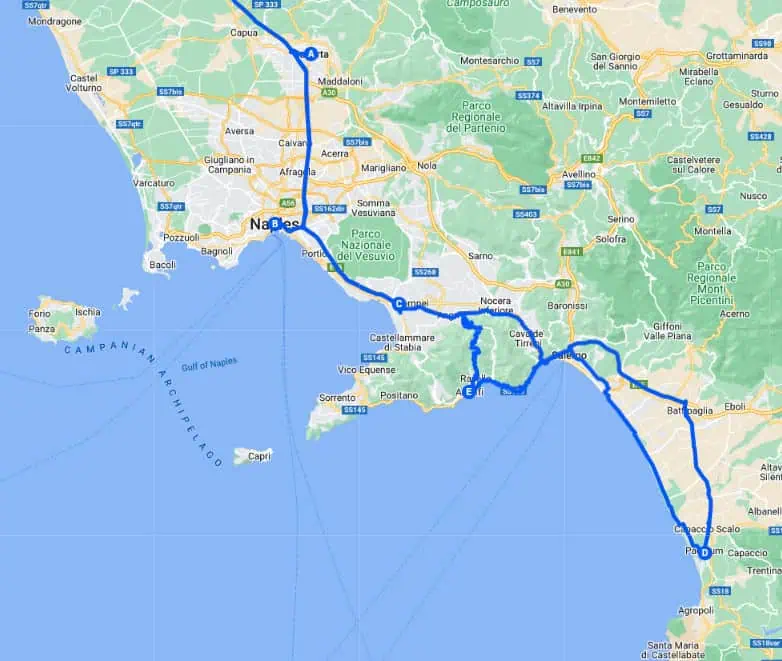
We went east and now we’re heading back west for the next leg of your Italy itinerary. This part of Italy is more familiar to me; I first visited Naples and the Amalfi Coast in 2014 and again in 2019.
This section of the trip is full of contrasts: historic ruins next to modern transportation, gritty cities around the corner from luxury celebrity hot spots, and stormy volcanoes by bright blue seas.
But I think that’s the magic of Campania, the region where Naples and the Amalfi Coast lay. Getting that contrast and diversity of experience is what keeps people coming back.
Stops in Campania:
- Naples (4 nights)
- Amalfi Coast (3 nights)
5 UNESCO Sites: 18th-Century Royal Palace at Caserta with the Park, the Aqueduct of Vanvitelli, and the San Leucio Complex; Historic Centre of Naples; Archaeological Areas of Pompei, Herculaneum and Torre Annunziata; Cilento and Vallo di Diano National Park with the Archeological Sites of Paestum and Velia, and the Certosa di Padula; Costiera Amalfitana
Naples (4 nights)
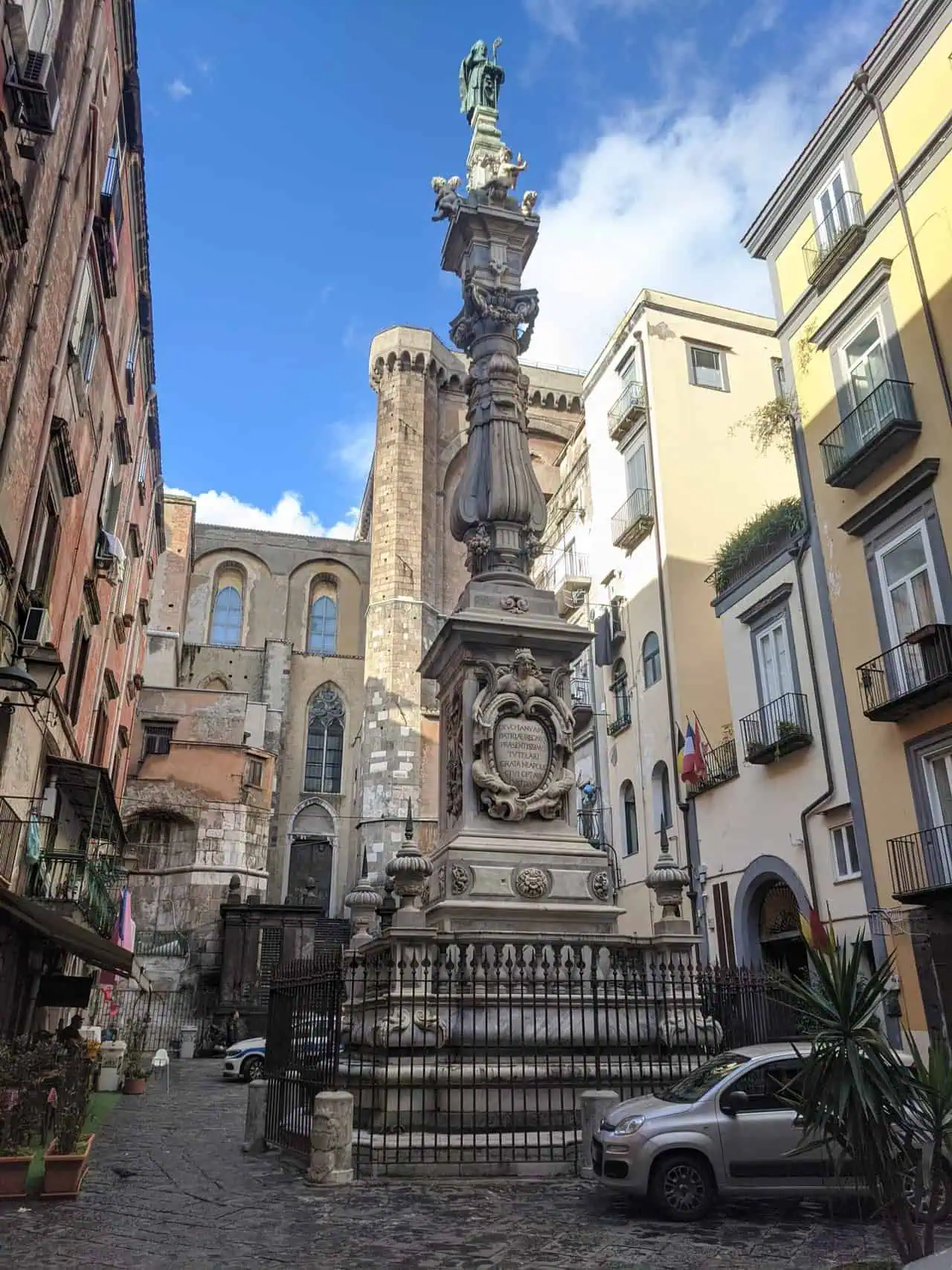
From Bari, you’ll take a direct train to Caserta (3 hours) where you’ll find the 18th-Century Royal Palace at Caserta with the Park, the Aqueduct of Vanvitelli, and the San Leucio Complex.
This royal castle complex was built in the 18th Century to rival Versailles, so colour me intrigued!
After enjoying the castle, hop on a quick 40 minute direct train into Naples. After your big day of trains and castles, you should have just enough time to grab some incredible pizza before hitting the hay.
The next day, you’ll explore the Historic Centre of Naples. Check out the Church of Santa Chiara and Castel Nuovo, plus spend some more time eating delicious food in Naples. Seriously, I still dream about some of the pizza I had on our last trip.
Day 21 and it’s time for a day trip! From Naples, you can easily take the train to Pompeii or Herculaneum, both part of the Archaeological Areas of Pompei, Herculaneum and Torre Annunziata.
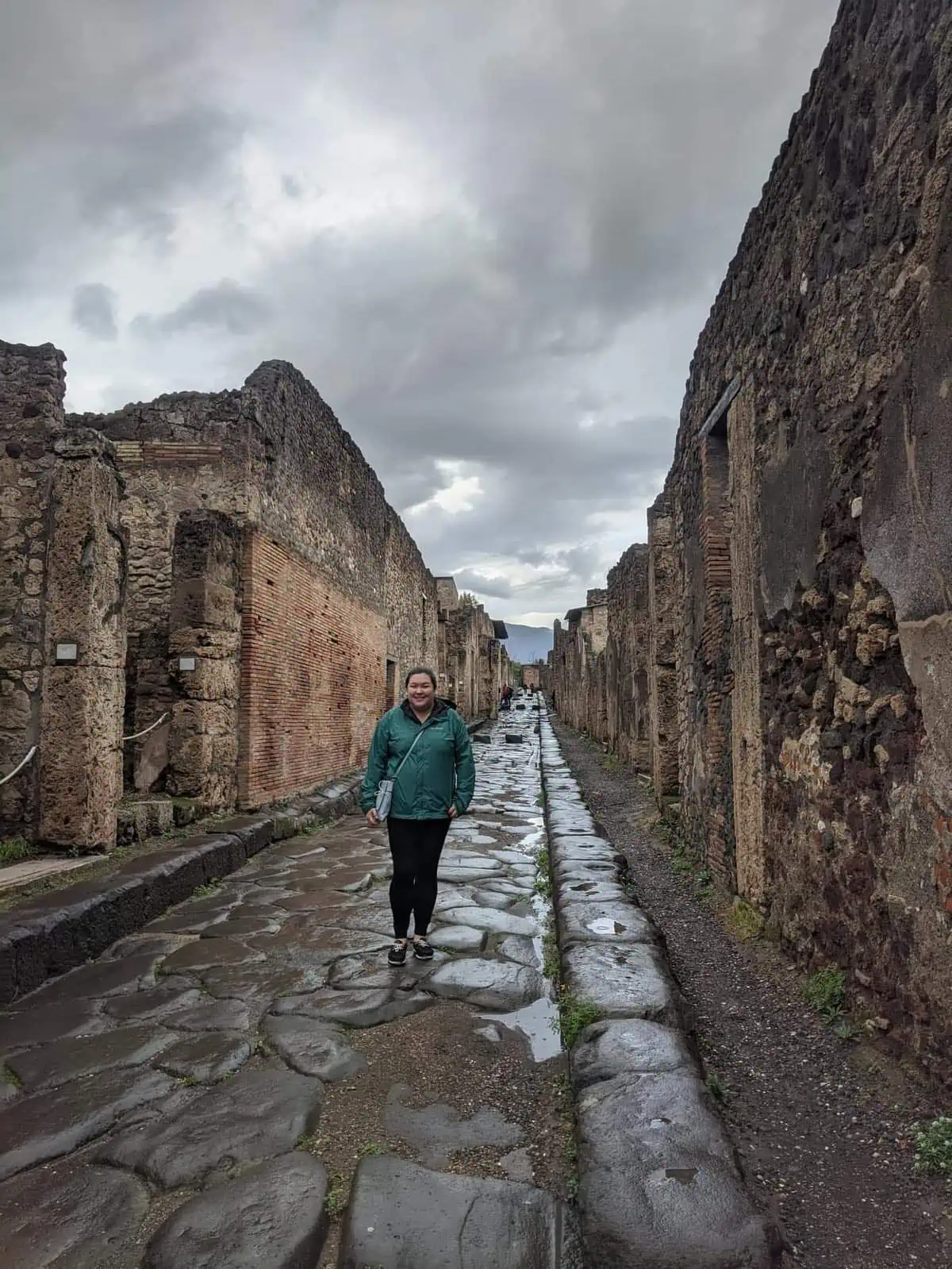
Both sites are within 30 minutes of Naples by train/transit and both offer awesome opportunities to see what happened to Ancient Roman towns when Vesuvius erupted in 79 AD.
Pompeii is larger and more popular, while Herculaneum is better preserved, but there isn’t as much to see. If you can, I’d recommend seeing both Herculaneum and Pompeii. Colin and I visited both in 2019 and really enjoyed both sites.
You can take a guided tour of Pompeii with an archeologist or guided tour of Herculaneum with an archeologist if you want to see the highlights and better understand the history. Or combine them both into one tour!
On your final day in Naples, you’ll head out on one last day trip by train to Paestum (75 min), part of Cilento and Vallo di Diano National Park with the Archeological Sites of Paestum and Velia, and the Certosa di Padula.
Paestum was once the Greek city of Poseidonia in the 7th Century. Today it’s an archeological site for you to discover before you head back to Naples for your last night in the city.
Amalfi Coast (3 nights)
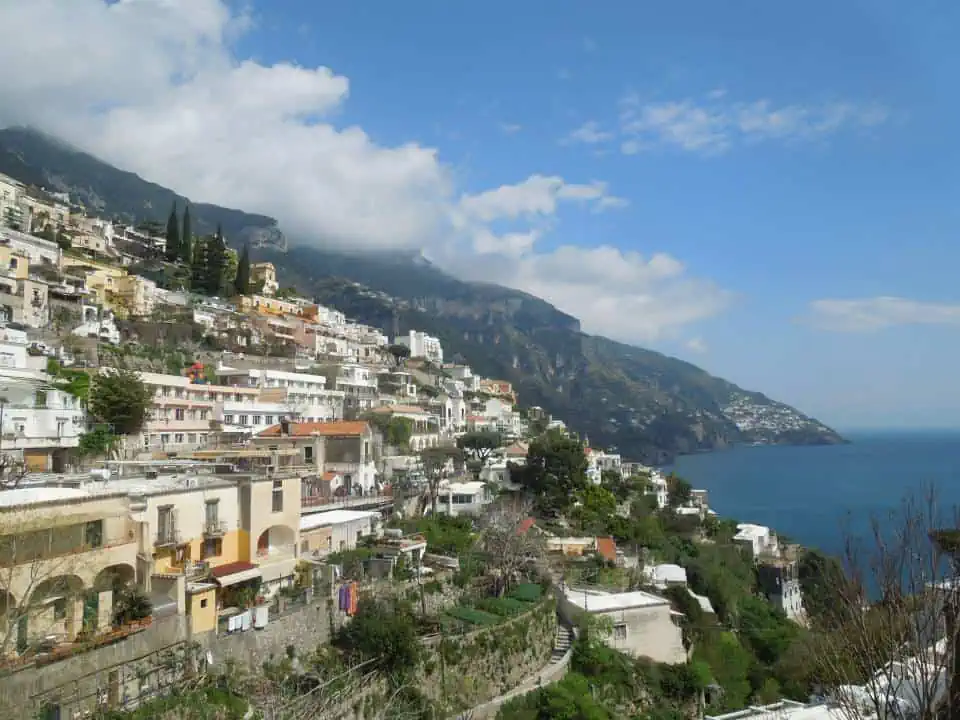
After all that history in Naples, it’s time for a little nature and relaxing on the Amalfi Coast!
The entire Costiera Amalfitana (aka Amalfi Coast) is a UNESCO World Heritage Site, so you can take your pick of where you want to base and what you want to do.
When I visited the Amalfi Coast way back in 2014, I stayed in Positano and it was magical. In April (and in 2014…) the beautiful coastal town wasn’t crowded. I spent leisurely days walking down to the beach, popping into little shops and sampling limencello.
I also visited the Island of Capri and enjoyed a day down by the water and up top in Anacapri taking in the views (plus paying for the most overpriced drink of my life).
From Naples, it’ll take you 1-2 hours to get to your base on the Amalfi Coast by train, bus and/or ferry. Spend three nights here hiking, swimming, boating, eating and enjoying the good life!
Day 25-29: Rome
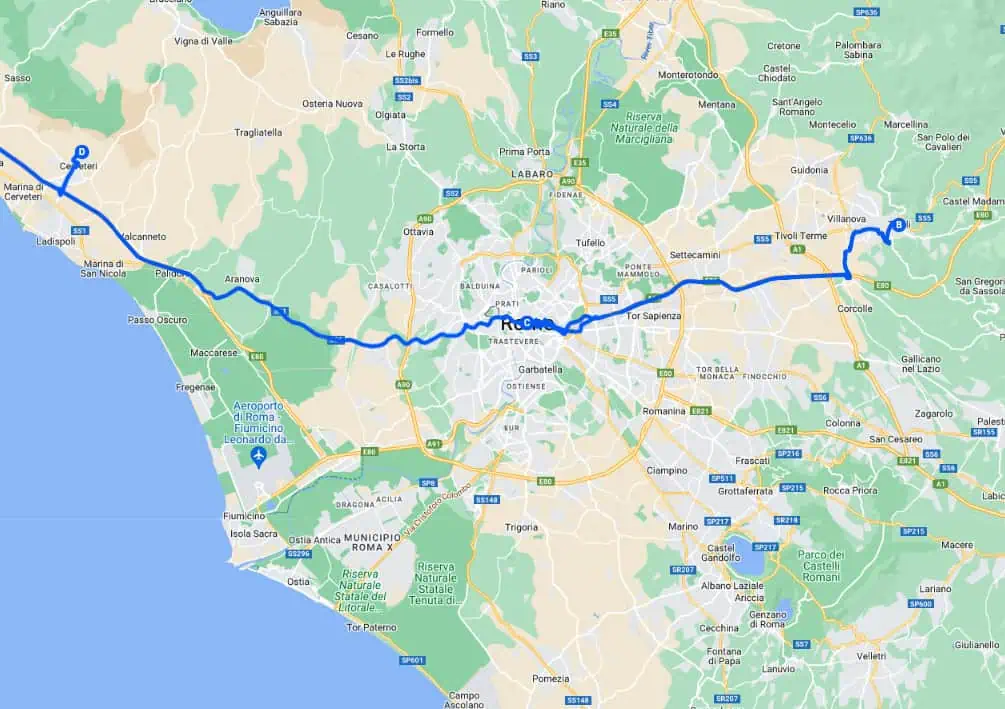
Can you believe you’re 3+ weeks into this itinerary and we’re only now getting to Rome? The Eternal City is obviously a must-visit on any Italy itinerary, so we’ll now be giving Rome its time to shine.
As most of the UNESCO sites in Lazio (Rome’s region) are in or around Rome, it makes the most sense to just base yourself in Rome for this stretch of the trip.
4 UNESCO sites: Historic Centre of Rome, the Properties of the Holy See in that City Enjoying Extraterritorial Rights and San Paolo Fuori le Mura; Villa Adriana; Villa d’Este; Etruscan Necropolises of Cerveteri and Tarquinia
Rome (4 nights)
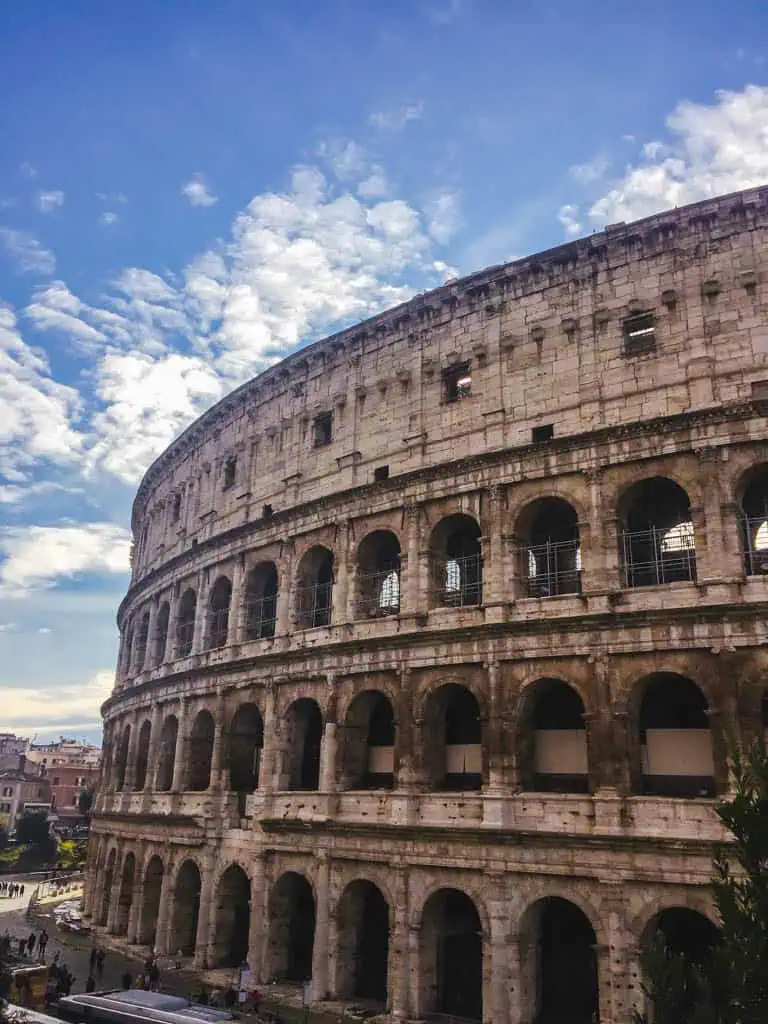
From the Amalfi Coast, it’ll take you about 2-3 hours to get to Rome by train, with a change in Naples. Use the rest of this day to settle into your new accommodation and enjoy a first delicious dinner in Rome.
The next day, you’ll be exploring the Historic Centre of Rome. This UNESCO site includes the Colosseum, the Pantheon and the Roman Forum. And since you’re in the neighbourhood, you might as well walk the Spanish Steps and toss a coin in the Trevi Fountain.
Of course, you may also want to visit the Vatican Museums and famous Sistine Chapel while in Rome. I’ve done the tour twice now and while it’s a lot of art, it is extremely impressive!
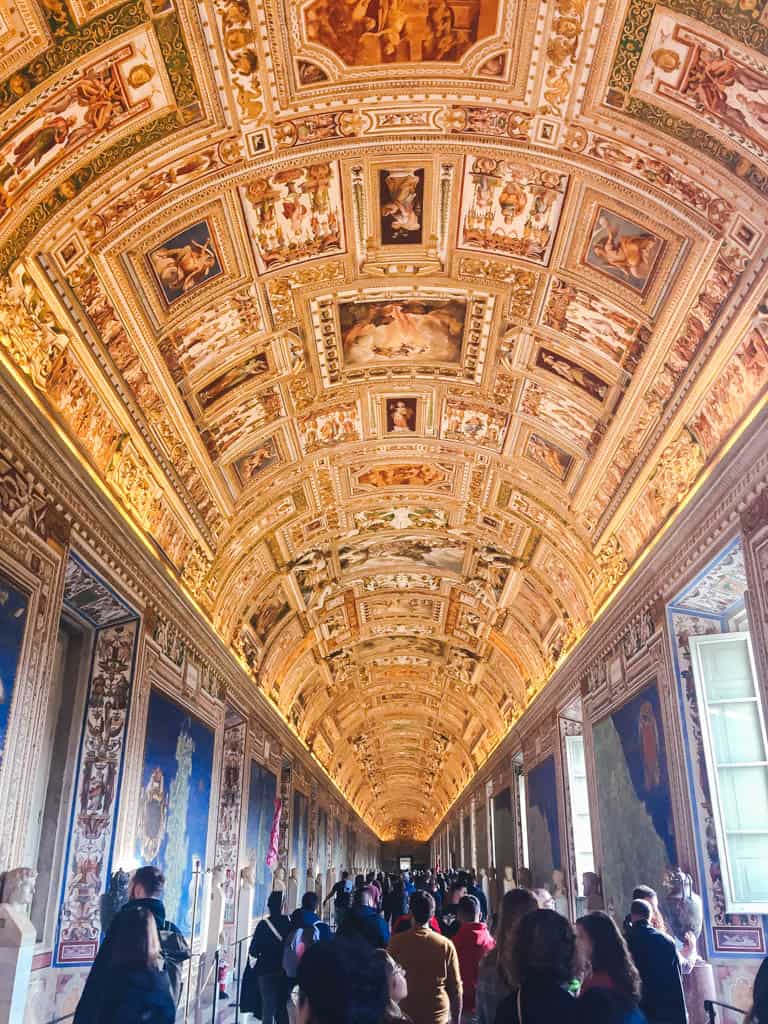
I highly recommend downloading a Rick Steves audio tour while you’re in Rome for a guided (and free!) introduction to the city. He has lots of options for Rome and will take you, step by step, through the city.
My husband, Colin, and I used his guides for the Roman Forum and Heart of Rome and thought they were fantastic!
The day after, head to Roma Termini station to train to Tivoli where you’ll explore the famous Villia Adriana (aka Hadrian’s Villa) and Villa d’Este. Both of these villas and their gardens are stunning, so expect to come back from your day trip with way too many photos.
On your final day in Rome, you’ll take another day trip by train out to the Etruscan Necropolis of Cerveteri (75 mins). Here you’ll get to see what 9th Century BC burial practices looked like!
Day 30-33: Sardinia
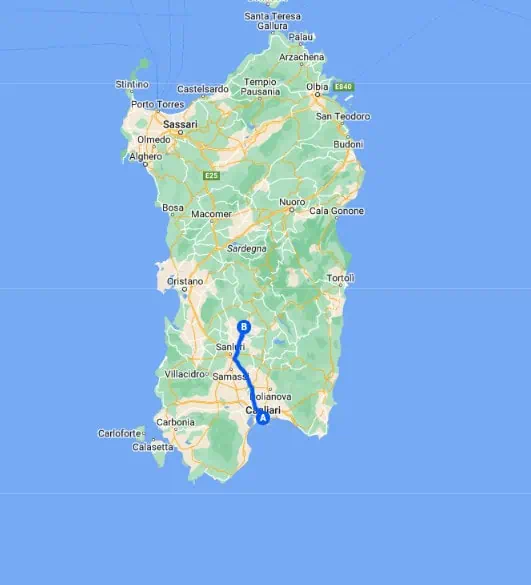
Sardinia is one of the lesser-discovered and lesser-known regions of Italy. In fact, it’s not even on the boot, but out in the middle of the Mediterranean Sea.
Despite not being as popular as the mainland, the island of Sardinia has a lot to offer, especially if you’re a nature fan. You can escape some of the crowds and enjoy exploring rocky coasts, national parks, local restaurants and the island’s sole UNESCO site.
Stops in Sardinia:
- Cagliari (4 nights)
1 UNESCO site: Su Nuraxi di Barumini
Cagliari (4 nights)
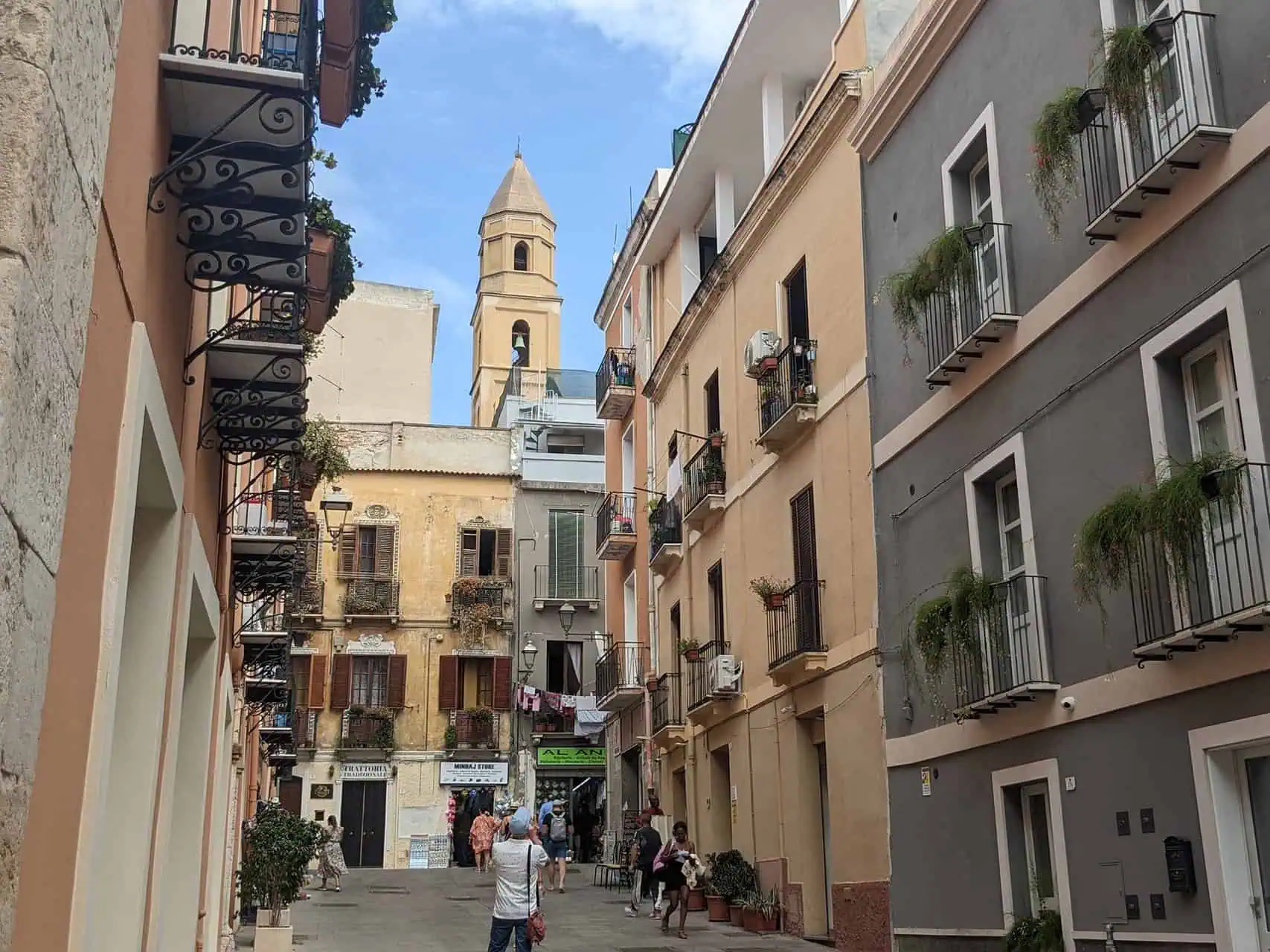
From Rome, you’ll fly a quick 65 minutes into Cagliari, the main city in Sardinia. Because you only have four nights on the island, I think it makes sense to base in Cagliari and do day trips from there.
You can pick up a rental car from the airport or once you’re in town. Not driving? You can join a tour, head out by bus or mostly stick to Cagliari. My mom visited Cagliari in 2023 and loved her time there.
On your first full day in Sardinia, wake up and explore the city. Climb up to the Castello, wander the medieval walled quarter, pop into the Cagliari Cathedral and get your history fix at the Museo Archeologico Nazionale di Cagliari.
The next day, it’s time to cross off that UNESCO Site. Drive out to Su Nuraxi di Barumini (1 hour), get there by transit (2-3 hours by bus) or take a tour from Cagliari. Su Nuraxi is an example of a Bronze Age defensive structure called a nuraghi.
On your final day, you can head out on another day trip around the island. There are lots of beautiful beaches, national parks, caves and grottos to explore. Another extremely popular thing to do is take a boat trip around the La Maddalena Archipelago.
Day 34-50: Tuscany, Umbria & Marche
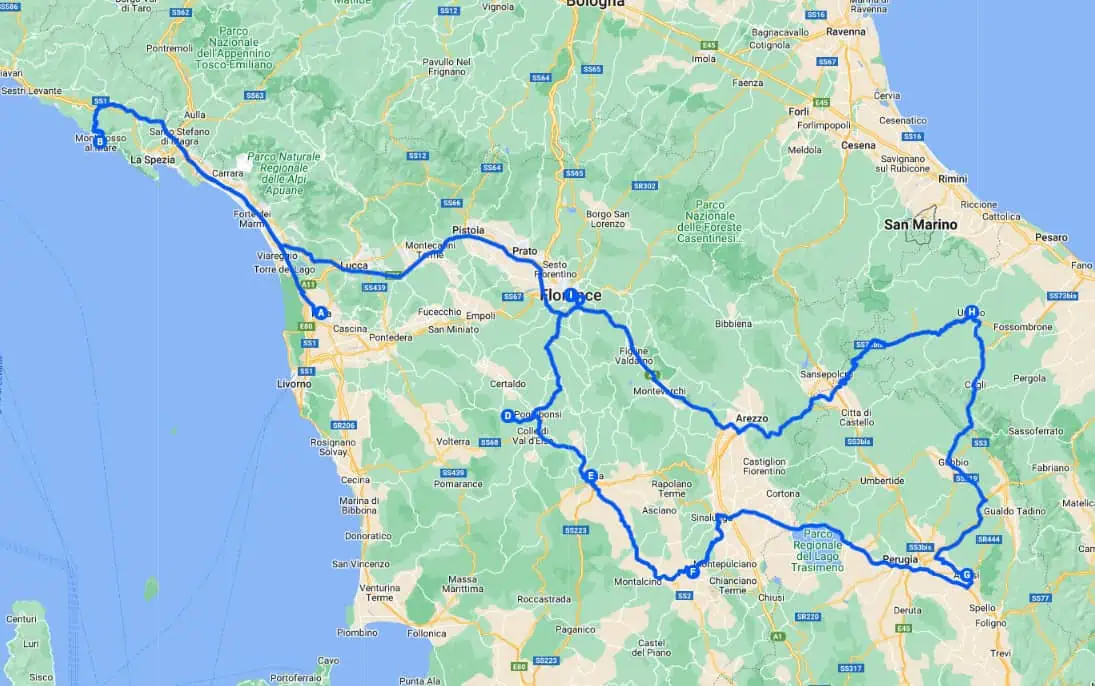
After visiting in 2019, I can definitely say that Tuscany is one of my favourite places in Italy. It’s hard to beat the beautiful rolling hills, charming towns and delicious, fresh produce.
And yet, this region offers even more than that! From the big city of Florence and the coastal views of Cinque Terre to the towns of Umbria, which are often in Tuscany’s shadow, this is the leg of the Italian itinerary I’m most excited for.
I will warn you though, we’re going to be moving quickly through some of these small towns!
Stops in Tuscany, Umbria & Marche:
- Pisa (2 nights)
- Cinque Terre (2 nights)
- Florence (4 nights)
- Siena (2 nights)
- Pienza (2 nights)
- Assisi (2 nights)
- Urbino (2 nights)
- Florence (1 night)
12 UNESCO sites: Piazza del Duomo, Pisa; Portovenere, Cinque Terre, and the Islands (Palmaria, Tino and Tinetto); Historic Centre of Florence; Medici Villas and Gardens in Tuscany; The Great Spa Towns of Europe; Historic Centre of San Gimignano; Historic Centre of Siena; Val d’Orcia; Historic Centre of the City of Pienza; Assisi, the Basilica of San Francesco and Other Franciscan Sites; Historic Centre of Urbino; Ancient and Primeval Beech Forests of the Carpathians and Other Regions of Europe
Pisa (2 nights)
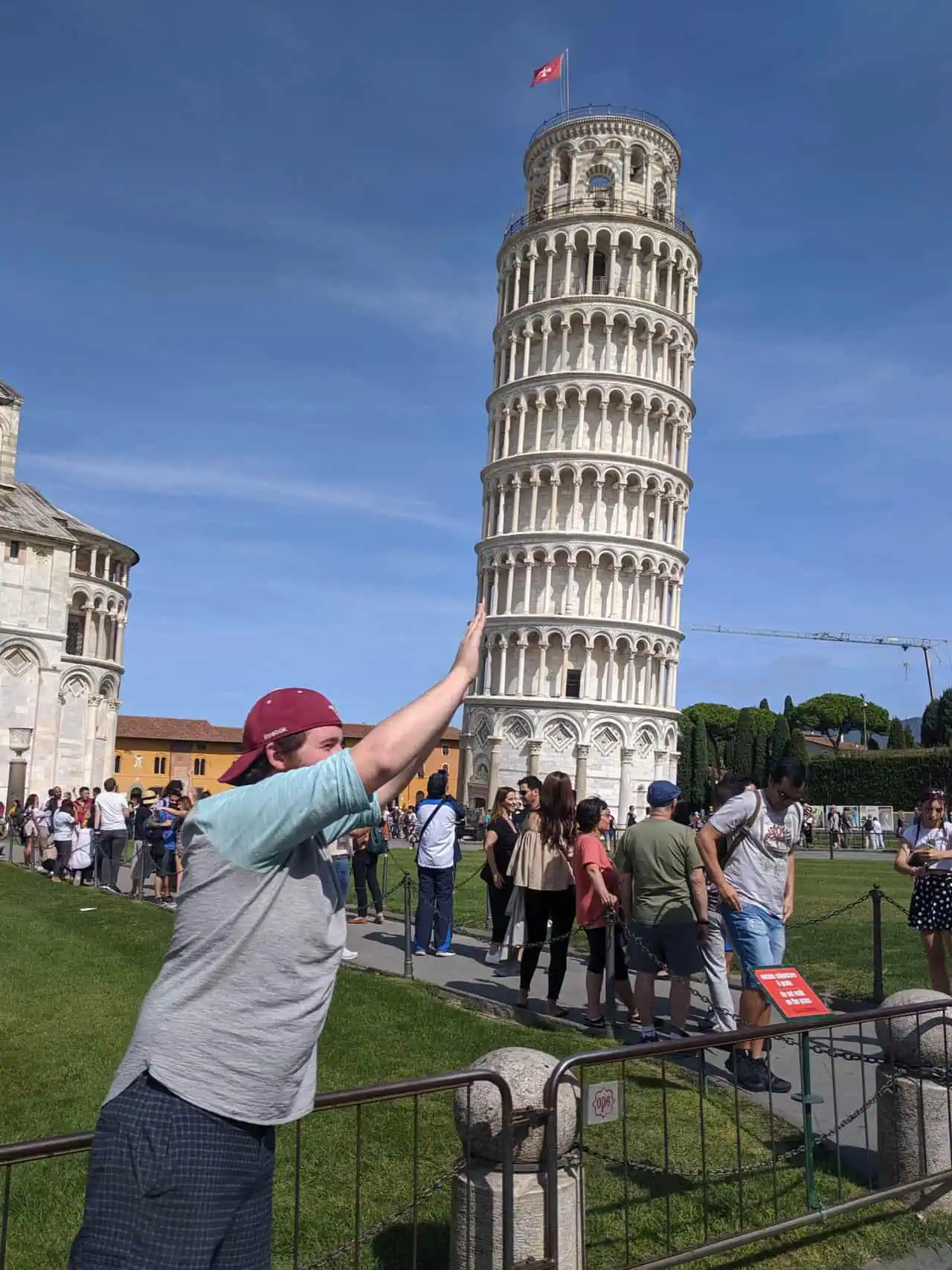
From Cagliari, catch a 70 minute flight to Pisa, home to the world famous Leaning Tower of Pisa. And yes, it is mandatory that you take the cheesy tourist photo with the tower (as my husband is demonstrating above).
Start your exploration of Pisa at the Piazza del Duomo, which hosts four 11th-14th Century monuments: the cathedral, the baptistry, the campanile (the ‘Leaning Tower’) and the cemetery.
Most of Pisa’s visitors hang out by the Leaning Tower but once you’ve explored that area, I encourage you to head away from the Piazza del Duomo and get to know the city a little bit.
Colin and I did this for a few hours when we visited in 2019 and it was actually my favourite part of Pisa. Sure, the tower area may be overrated and overcrowded but wandering down alleys and across bridges, and finding world class gelato, certainly isn’t.
Cinque Terre (2 nights)
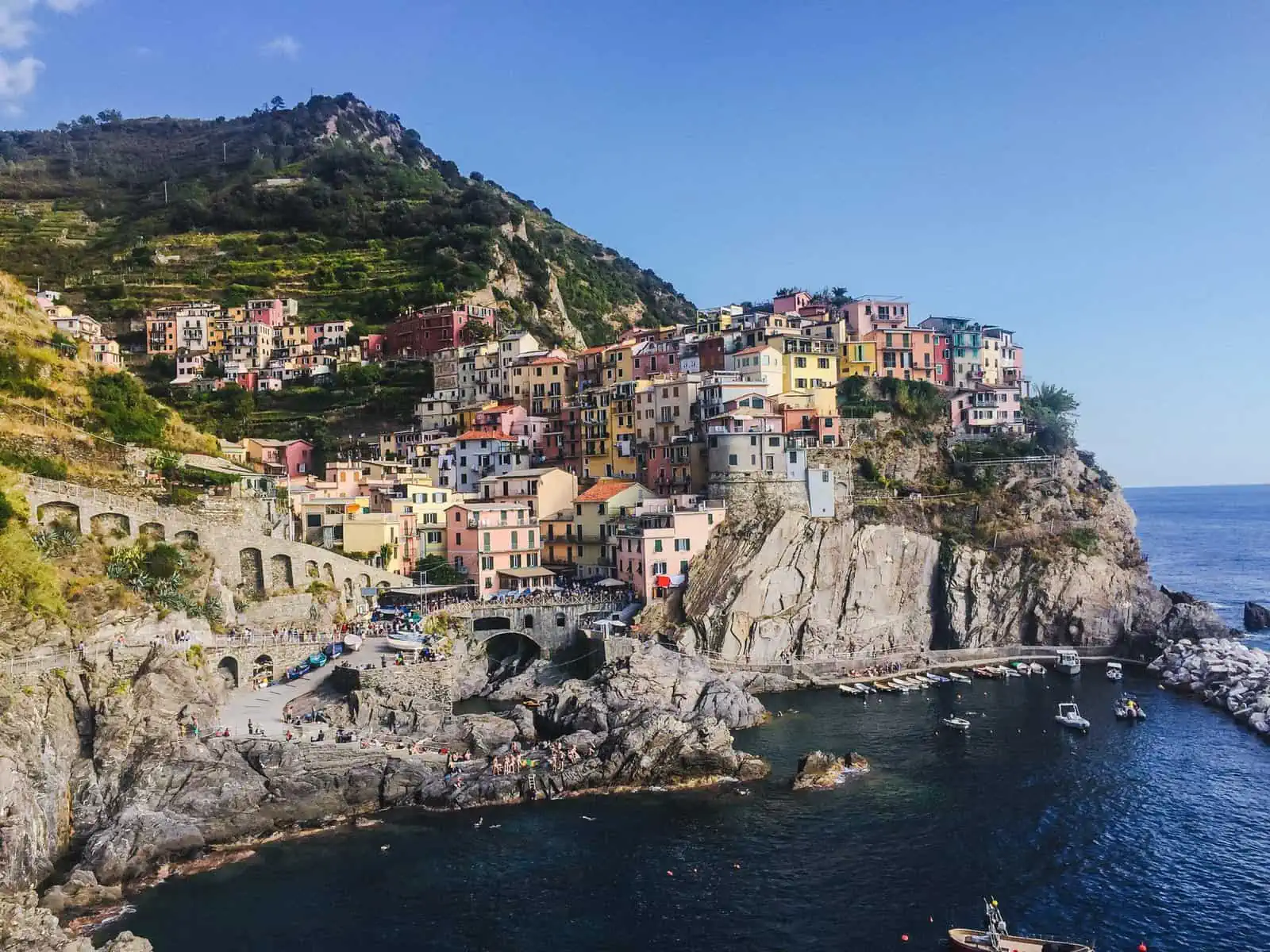
From Pisa, you’ll take the train to one of the five towns that make up Cinque Terre (60-90 mins with one change). Those towns are Riomaggiore, Manarola, Corniglia, Vernazza and Monterosso.
A lot of people just visit Cinque Terre on a day trip but I highly recommend spending a night or two. We stayed two nights when we visited in 2019 and the contrast from day to evening was huge.
The towns clear out in the evenings and have a much more local and quiet vibe. Plus, by staying overnight, you can start your exploring the next day bright and early.
You can travel between the five towns by train, ferry (seasonal) or hiking path (weather-dependent). We went by train and it worked out perfectly.
The best thing to do in Cinque Terre is just pop between the towns and explore. Each one offers unique views and a slightly different vibe. Don’t miss Monterosso (the only one with a sandy beach) and Manarola (the one with the postcard view).
Florence (4 nights)
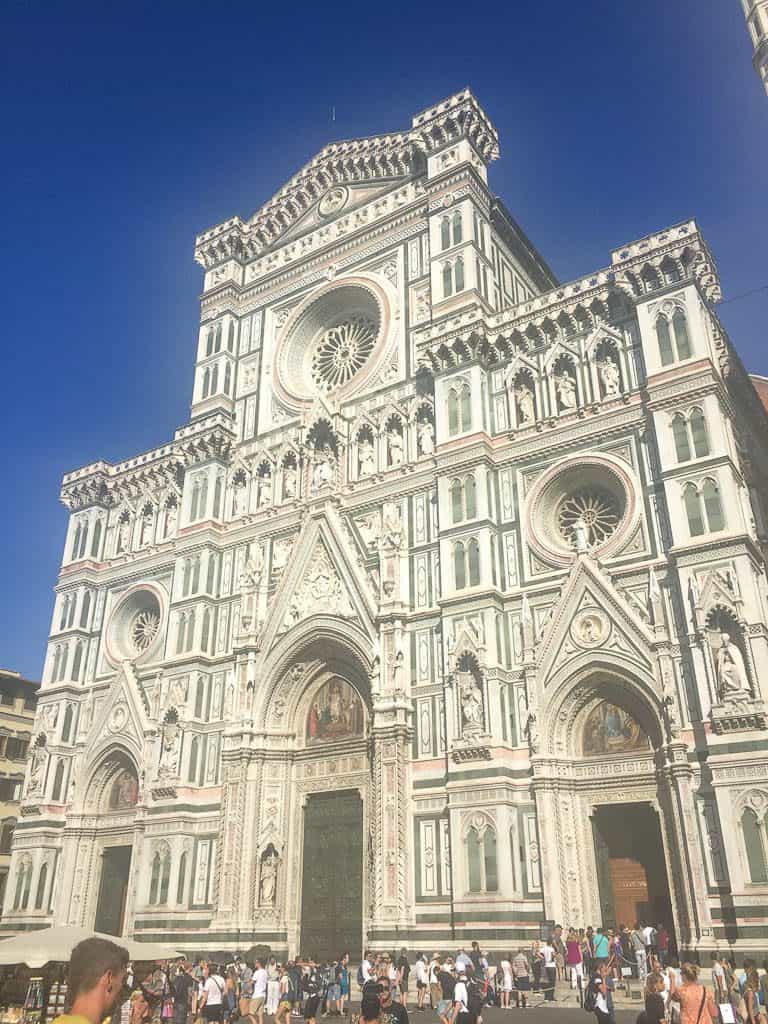
To get to Florence from Cinque Terre will take about 2.5 hours by train, with a change in La Spezia. Once you’ve made it, settle in for the night and get excited for your Florence Italy itinerary.
The next day, set out to explore the Historic Centre of Florence. This UNESCO site includes the Santa Maria del Fiore Cathedral (aka the Duomo), the Church of Santa Croce, the Uffizi and the Pitti Palace.
During this day in Florence, you’ll also want to walk across the famous Ponte Vecchio bridge, stop by Piazza Della Signoria, Piazza San Marco and Piazzale Michelangelo squares, and see David at the Accademia.
I’ve only spent a day in Florence and, sadly, the Accademia was closed so I didn’t get to see David. But I definitely want to come back and catch all the highlights!
On your second full day in Florence, you’re heading out on a day trip to the Medici Villas and Gardens in Tuscany. These 12 villas and two gardens show off the influence of the Medici family and were built in the 15-17th Centuries.
Technically, you can visit the Boboli Garden directly in Florence, as its one of the Medici gardens.
However, if you want to go to one of the villas (and you should, they’re stunning!) La Villa Medicea a Fiesole, Villa di Careggi, Villa di Castello, Villa La Petraia and Villa del Poggio Imperiale are all within 30 minutes of Florence on public transport.
On your final full day in Florence, it’s time for one more day trip. This time we’re visiting one of The Great Spa Towns of Europe, Montecatini Terme (55 mins from Florence by train).
Montecatini Terme is the only UNESCO spa town in Italy and developed around a natural spring. Enjoy treating yourself to a day of relaxation and rejuvenation at the spa!
Siena (2 nights)
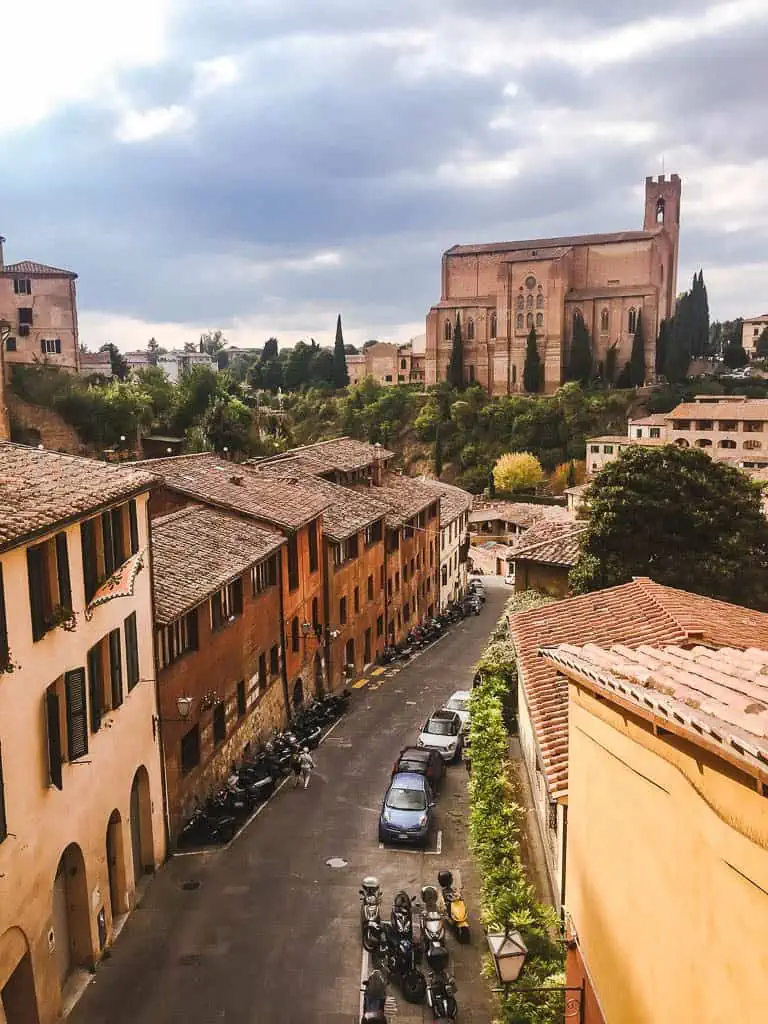
After your four nights in Florence, it’s time to pick up a rental car to explore the small towns of Tuscany and Umbria. When I visited Tuscany, seeing these small towns and driving through the gorgeous hills was a huge highlight of the trip!
From Florence, drive one hour to San Gimignano. Explore the Historic Centre of San Gimignano where you’ll find the remaining 14 tower houses (there were originally 72). You’ll also find incredible gelato here at Dondoli – seriously, I still dream about this stuff!
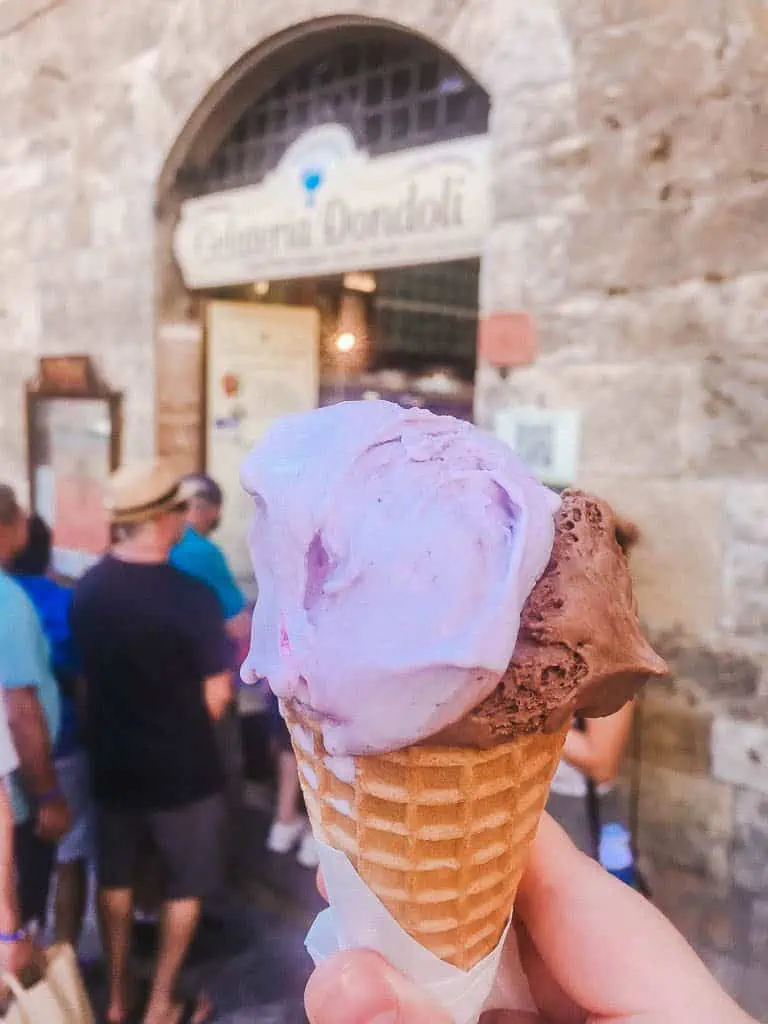
After spending most of the day in San Gimignano, carry onto Siena (40 minute drive) where you’ll stay the night.
The next day, you’ll wake up and explore the Historic Centre of Siena. I loved exploring this medieval city back in 2019, particularly the impressive architecture around Piazza del Campo and the beautiful Duomo di Siena.
Not driving? Siena is 60-90 minutes from Florence by bus or train and San Gimignano is 1.5-2 hours from Florence by connecting buses. If you’d rather not take buses and trains, you could also hop on this day tour from Florence to San Gimignano and Siena.
Pienza (2 nights)
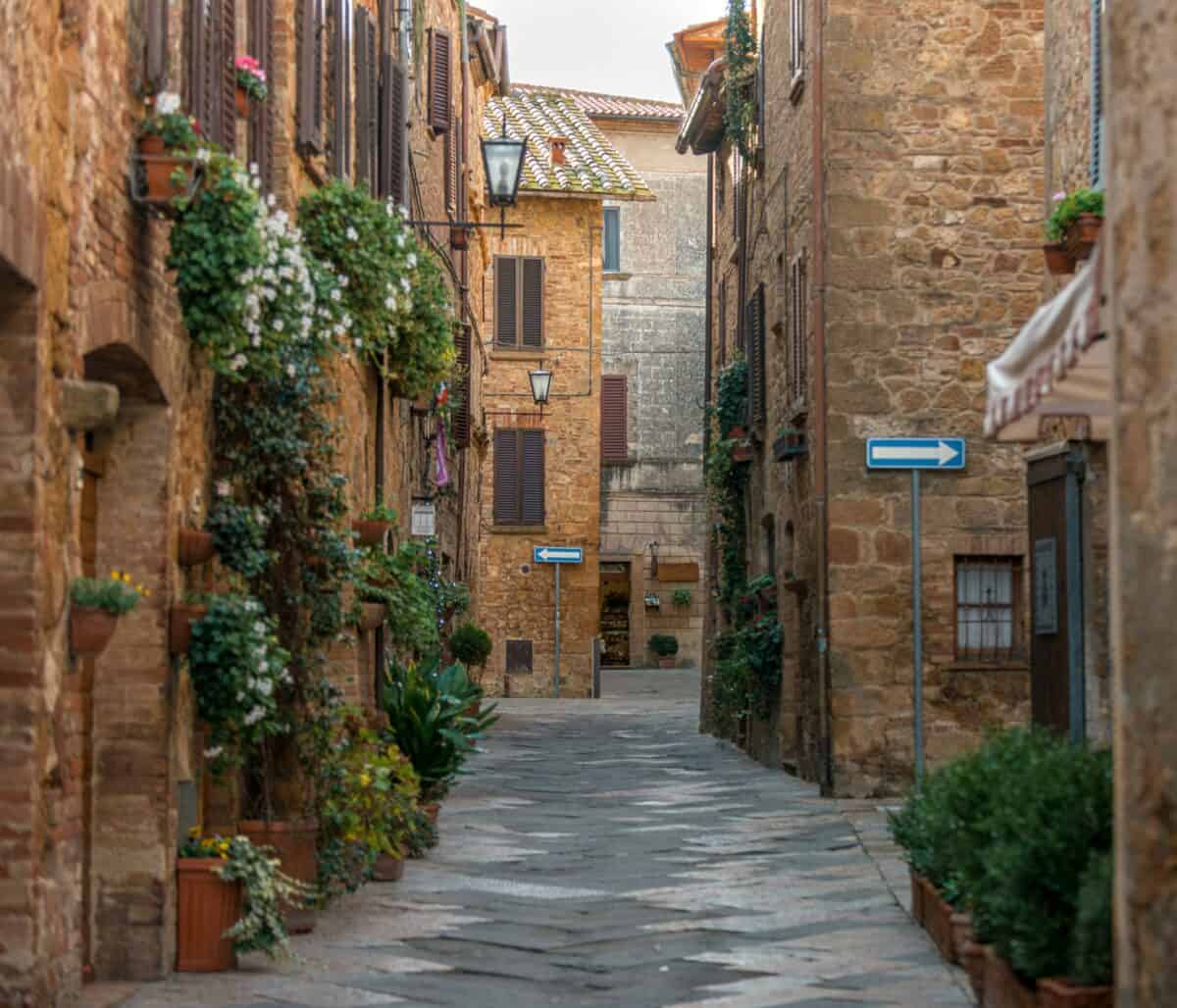
From Siena, you’ll drive about one hour to the town of Pienza. On the way, you’ll pass through the Val d’Orcia, which is a UNESCO site thanks to its unique agricultural landscape.
Take your time driving to Pienza so you can really appreciate the beauty of rural Tuscany. This would also be a great time to stop by a vineyard or farm, go on a tour and taste their fresh produce.
We did this when we were in Tuscany a few years ago. We stayed in a gorgeous Tuscan villa and had a glorious day at Fattoria Poggio Alloro where we toured the farm, ate a multi-course lunch and tasted way too many local wines.
Spend the night in Pienza and then wake up to explore the Historic Centre of the City of Pienza. Pienza is credited as the birthplace of Renaissance town planning.
Stroll through Piazza Pio II, admire the cathedral, and pop into the Piccolomini and Borgia palaces.
Not driving? The fastest way to get to Pienza would be to take a train and bus from Siena (1.5-2 hrs). Alternatively, if you’d rather stay based in Florence, you can take this Pienza and Val d’Orcia wine tasting tour!
Assisi (2 nights)
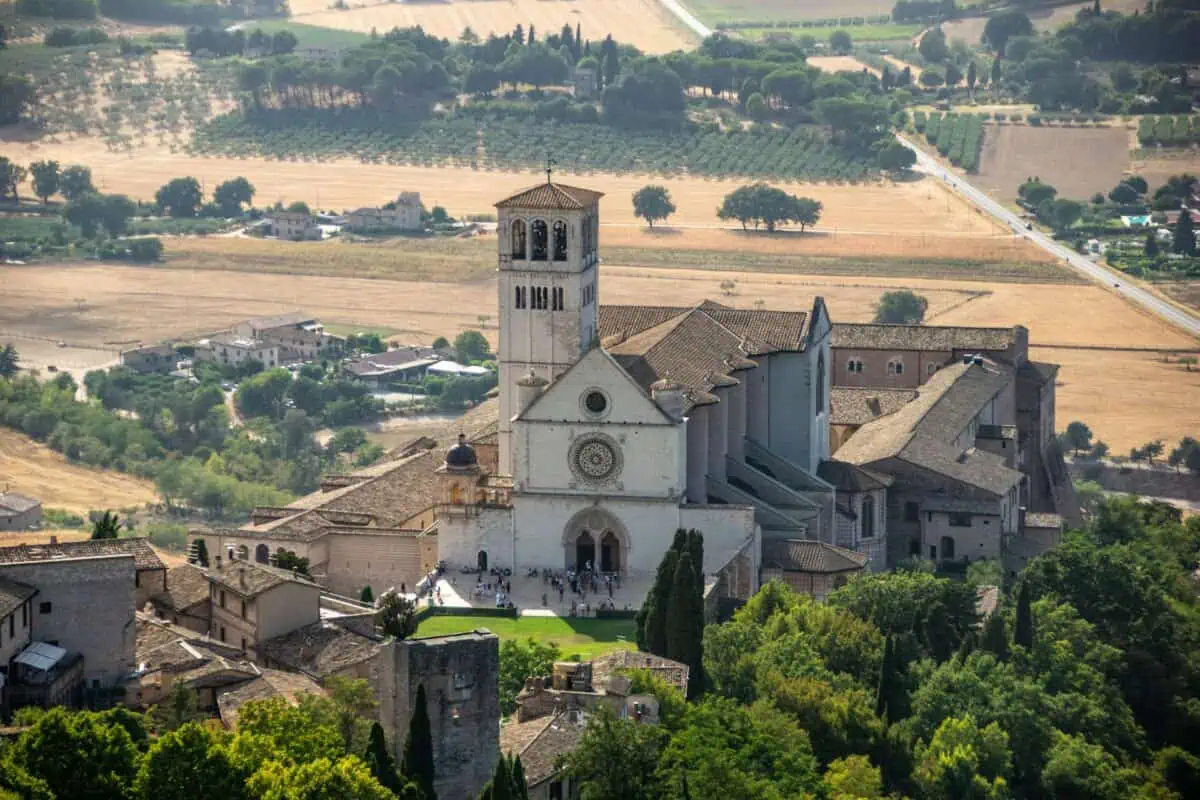
After your two nights in Pienza, continue onto Assisi (90 minute drive). This medieval city is most famous as the birthplace of Saint Francis (aka Saint Francis of Assisi).
Fun fact: My dad and stepmom got married in Saint Francis of Assisi Church! Though their church was in Toronto, not in Italy.
The majority of your time here will be spent exploring Assisi, the Basilica of San Francesco and Other Franciscan Sites. Even if you’re not religious, seeing these important sites and the artwork they hold will be worthwhile.
Not driving? Unfortunately, there are no good public transport routes from Pienza to Assisi; they involve 4+ transfers and take 5-8 hours. If you’re not driving, I’d highly recommend you stay based in Florence and visit Assisi on a day tour.
Urbino (2 nights)
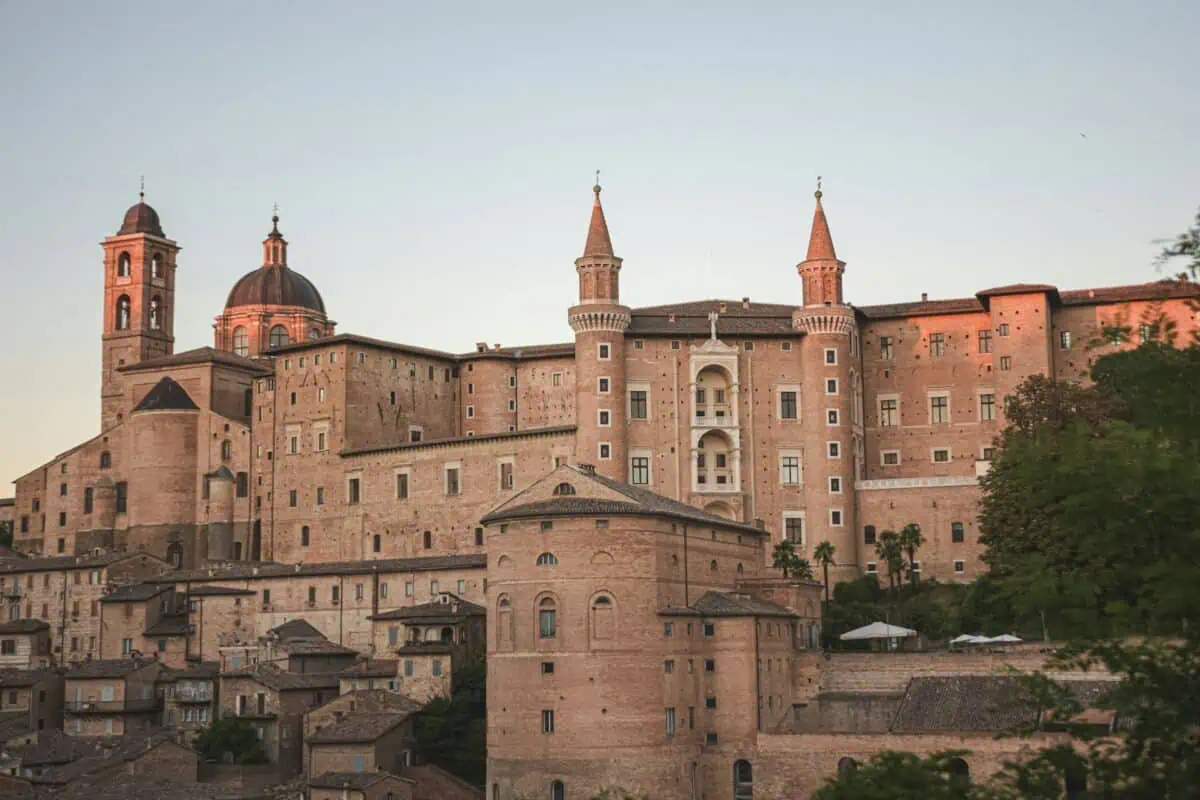
From Assisi, you’ll carry onto the final stop of your Tuscan road trip, Urbino (2 hour drive). Urbino is a small hill town known for its importance during the Renaissance era.
Back when Urbino was in its prime, it used to attract some of the greatest artists, politicians and thinkers of the 15th Century. These men (because, of course, it was only men at the time) were responsible for some of Europe’s greatest cultural and urban projects.
Spend your time here discovering the Historic Centre of Urbino. Check out the almost fully intact city walls and important monuments like Ducal Palace, the cathedral and the Monastery of Santa Chiara.
PS: San Marino is just a one hour drive from Urbino. If you have time to squeeze it in, it might be fun to visit another country while in Italy.
Not driving? The public transit options from Assisi to Urbino or even Florence to Urbino are quite long and complicated. There’s not even a good day tour option.
Your best bet would be to visit Urbino from your next major base, Bologna, as most trains to Urbino from Florence have to route through Bologna anyway.
Florence (1 night)
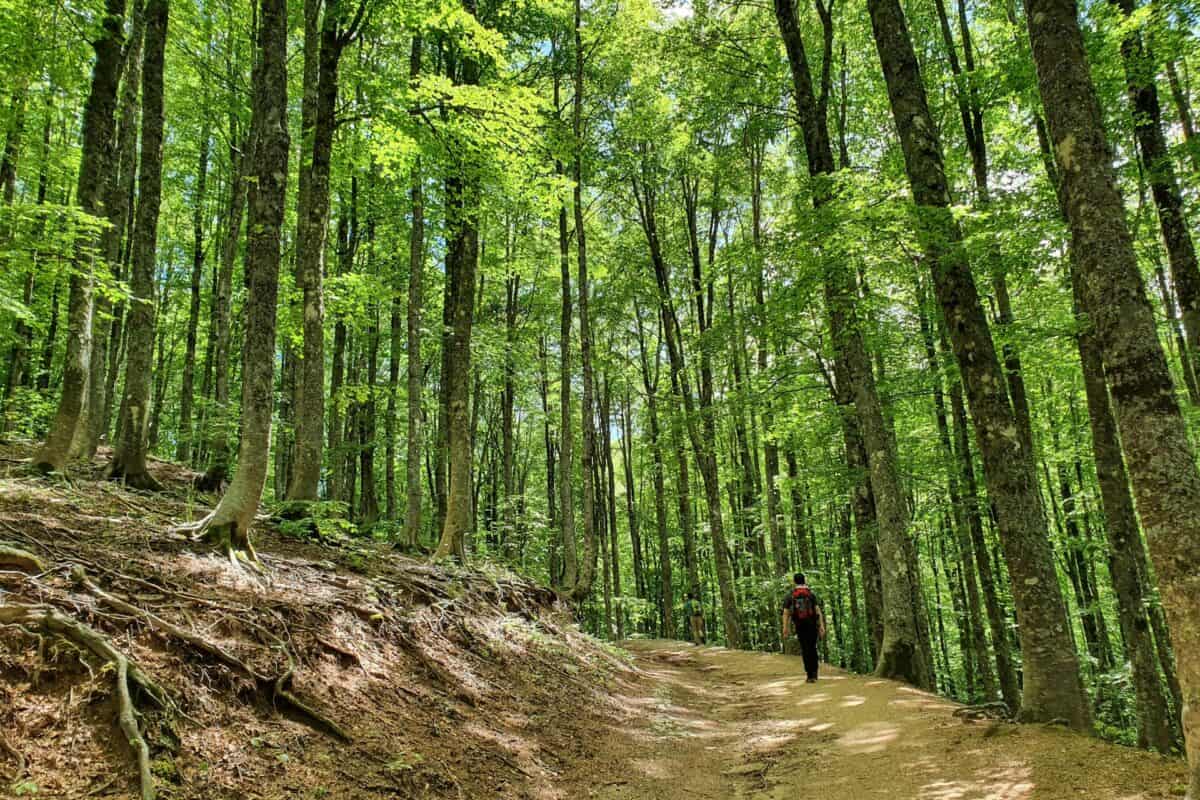
Your Tuscan road trip is almost coming to an end. You just have one more pit stop before you return your car in Florence.
On your way from Urbino to Florence, you’ll stop at Riserva Naturale Sasso Fratino (3 hour drive), one of the Ancient and Primeval Beech Forests of the Carpathians and Other Regions of Europe.
This UNESCO site is shared across 18 countries to mark the isolated beech forests that were able to grow and survive in Europe after the last Ice Age. There are a few of these forests in Italy, but the Sasso Fratino one is the most convenient to visit.
After you’ve enjoyed a few hours in nature walking around the forest, continue onto Florence (2 hour drive). Return your car and rest up after a big day of driving. Tomorrow, we’re heading north!
Not driving? It’s going to be pretty tricky to visit Riserva Naturale Sasso Fratino without a car and, unfortunately, it’s one of the most accessible UNESCO beech forests in Italy.
I would recommend hiring a private driver from Florence for the day in order to check this site off your list.
Day 51-65: Emilia Romagna & Veneto
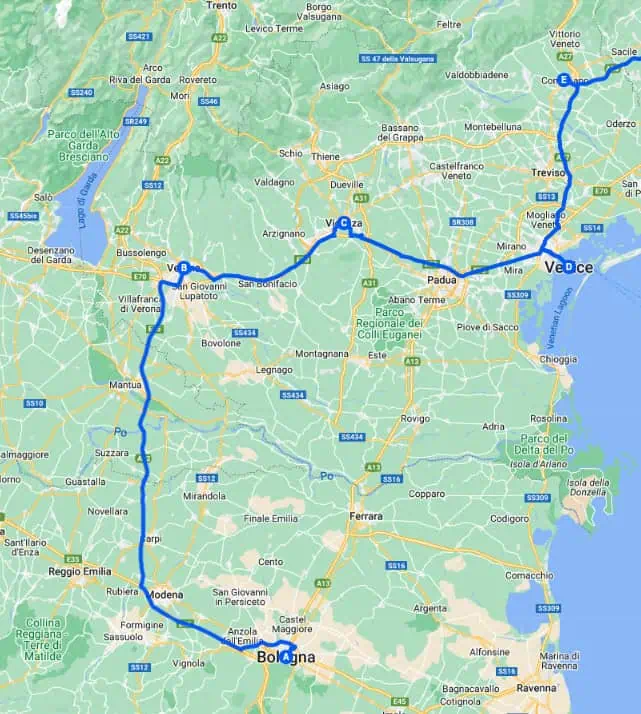
The Emilia Romagna region of Italy is one of the ones I’m most excited to visit. Why? The food!
This is the region that blessed us with Parmigiano Reggiano cheese, Parma ham, balsamic vinegar and tagliatelle pasta. Not to mention the delicious pasta and seafood from the Veneto region next door.
But between meals, this area of Italy is also home to a lot of beautiful UNESCO World Heritage Sites. You’ll check a whopping 14 off your list during your two weeks here.
Stops in Emilia Romagna & Veneto:
- Bologna (5 nights)
- Verona (4 nights)
- Vicenza (2 nights)
- Venice (2 nights)
- Conegliano (2 nights)
14 UNESCO sites: The Porticoes of Bologna; Early Christian Monuments of Ravenna; Evaporitic Karst and Caves of Northern Apennines; Ferrara, City of the Renaissance, and its Po Delta; Cathedral, Torre Civica and Piazza Grande, Modena; City of Verona; Mantua and Sabbioneta; Venetian Works of Defence between the 16th and 17th Centuries: Stato da Terra – Western Stato da Mar; Prehistoric Pile Dwellings around the Alps; City of Vicenza and the Palladian Villas of the Veneto; Padua’s fourteenth-century fresco cycles; Botanical Garden (Orto Botanico), Padua; Venice and its Lagoon; Le Colline del Prosecco di Conegliano e Valdobbiadene
Bologna (5 nights)
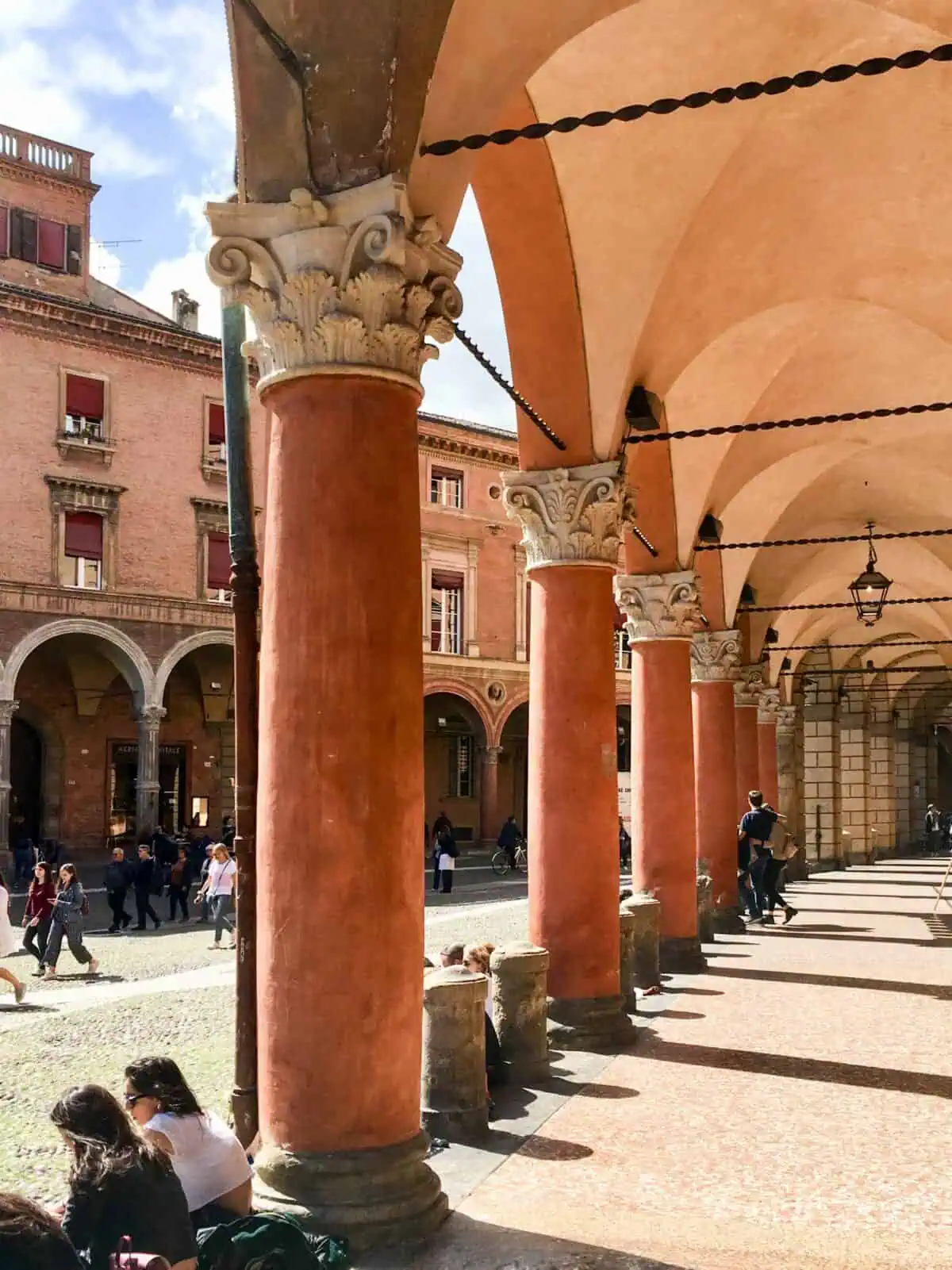
From Florence, it’s just 40 minutes on the fast train to the beautiful city of Bologna where you’ll be based for five days.
On your first day, take a stroll under the Porticoes of Bologna, the arched passageways that line many of Bologna’s sidewalks. Some of these porticoes date back to the 12th Century and there are now 62 km (38.5 mi) of them throughout the city.
After admiring the porticoes you can get to know the city better by climbing up Asinelli Tower, hanging out in Piazza Maggiore, popping into the Santo Stefano churches or going on a secret food tour.
Your next few days in Bologna are going to be dedicated to day trips, as there are a number of UNESCO sites to see nearby.
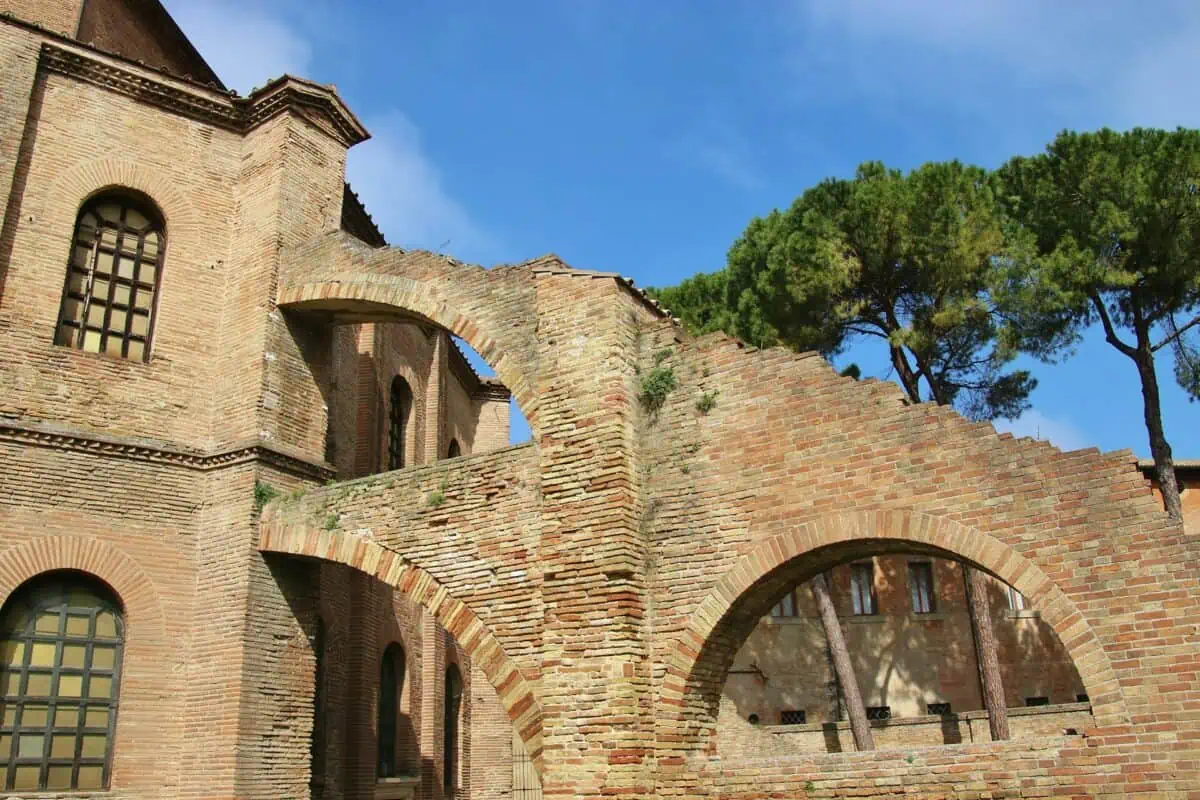
Up first, the Early Christian Monuments of Ravenna. Ravenna is just over an hour from Bologna by train.
Ravenna was a very important city from the 5-8th Century, resulting in a collection of Christian monuments and mosaics in the city’s chapels, mausoleums and basilicas. Spend this day exploring them all!
The next day, you’ll take a 30 minute train from Bologna to see Ferrara, City of the Renaissance, and its Po Delta.
The greatest minds of the Italian Renaissance once met in Ferrara and came up with the concept for the “ideal city” – though you can judge whether or not Ferrara fits that bill.
Another day, another day trip. On day 4, you’re taking a short 20 minute train from Bologna to Modena to see the Cathedral, Torre Civica and Piazza Grande, Modena.
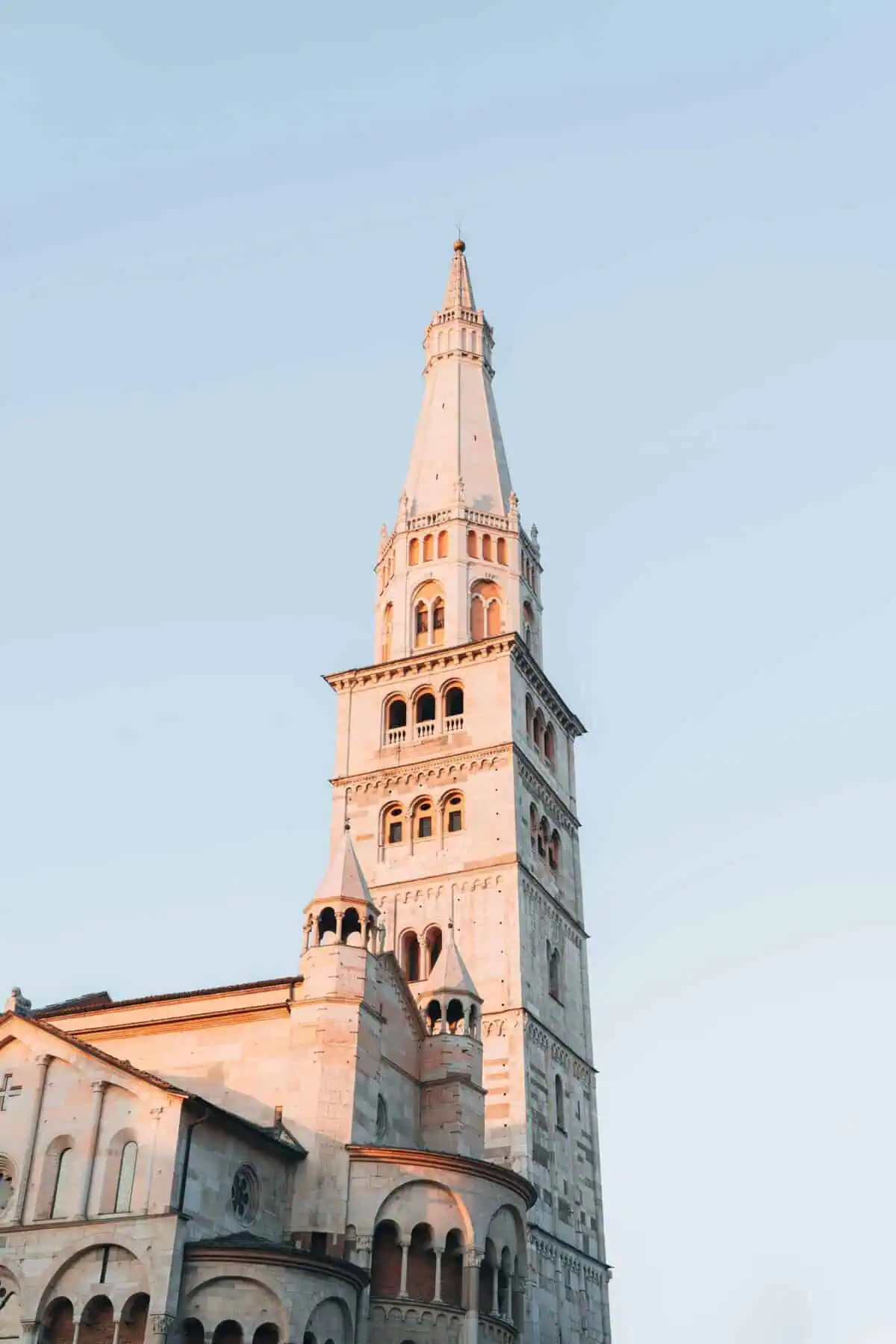
Ooo and ahh over this 12th Century cathedral with its adjoining tower and piazza, all exemplary models of Romanesque art. Then be sure to try some of Modena’s famous balsamic vinegar.
I haven’t been to Modena yet but I did try some Modena balsamic vinegar while I was in Tuscany and it was one of the most delicious things I’ve ever had. I can’t wait to try it at the source someday!
There’s also the Ferrari Museum in Modena, as well as a sister Ferrari Museum in nearby Maranello, that car enthusiasts may want to check out. Snag combo tickets to both museums here.
On your final day in Bologna, you’ll head out on one last day trip. This time, you’re going to Parco dei Gessi Bolognesi, which is part of the Evaporitic Karst and Caves of Northern Apennines.
The best way to reach this park from Bologna will actually be to take a taxi, as the drive is only 25 minutes. Otherwise, you’ll spend way too long on the bus.
Now I didn’t know what an “evaporitic karst” was but after a little research, I understand this area is a series of over 900 gypsum caves in a small area. So happy caving!
Verona (4 nights)
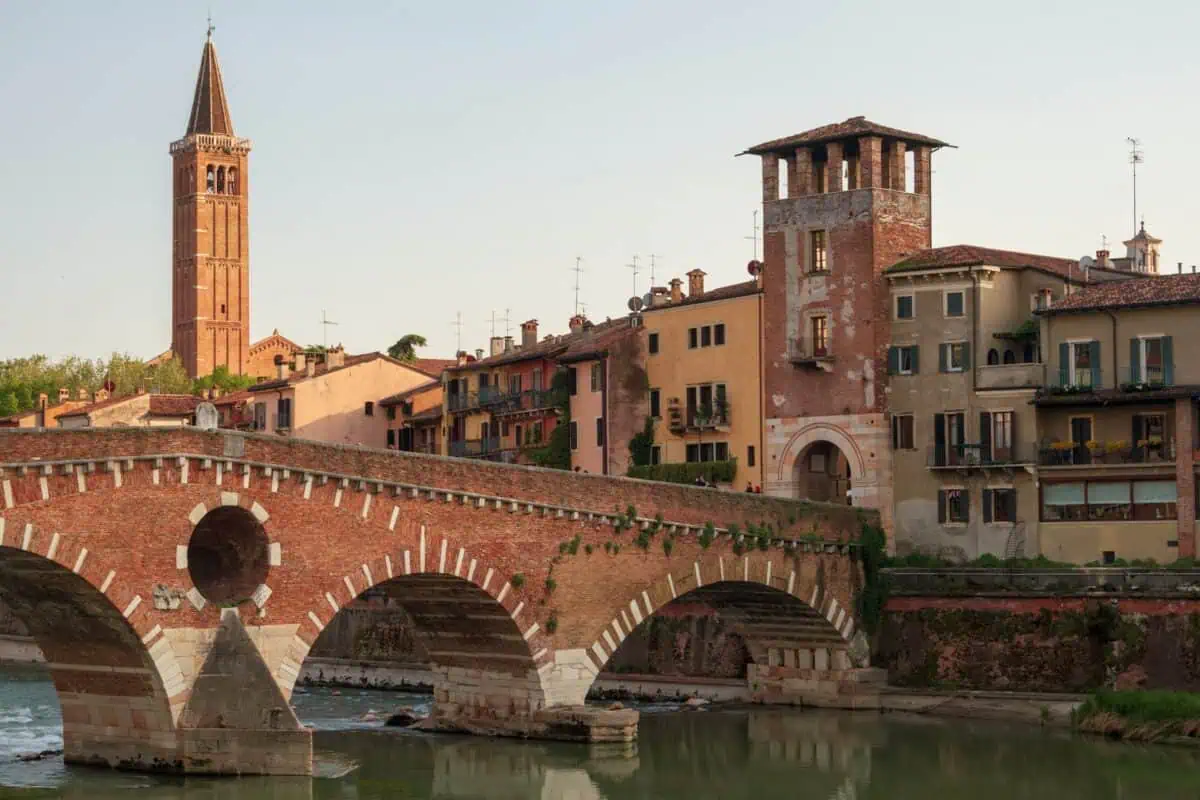
After five nights in Bologna, it’s off to the land of Romeo and Juliet, Verona! Verona seems like such a fairytale city to me. I know it can get crowded in the summer but I’d love to visit in the off season.
From Bologna, you’ll take a one hour direct train to Verona. Because I’m so infatuated with Verona, I’m giving you two nights to just explore and enjoy the City of Verona.
Check out the monuments throughout the city that date back to antiquity, the medieval and Renaissance periods. Catch an opera show at the Verona Arena. And, even though it’s cheesy, you have to go visit Juliet’s balcony.
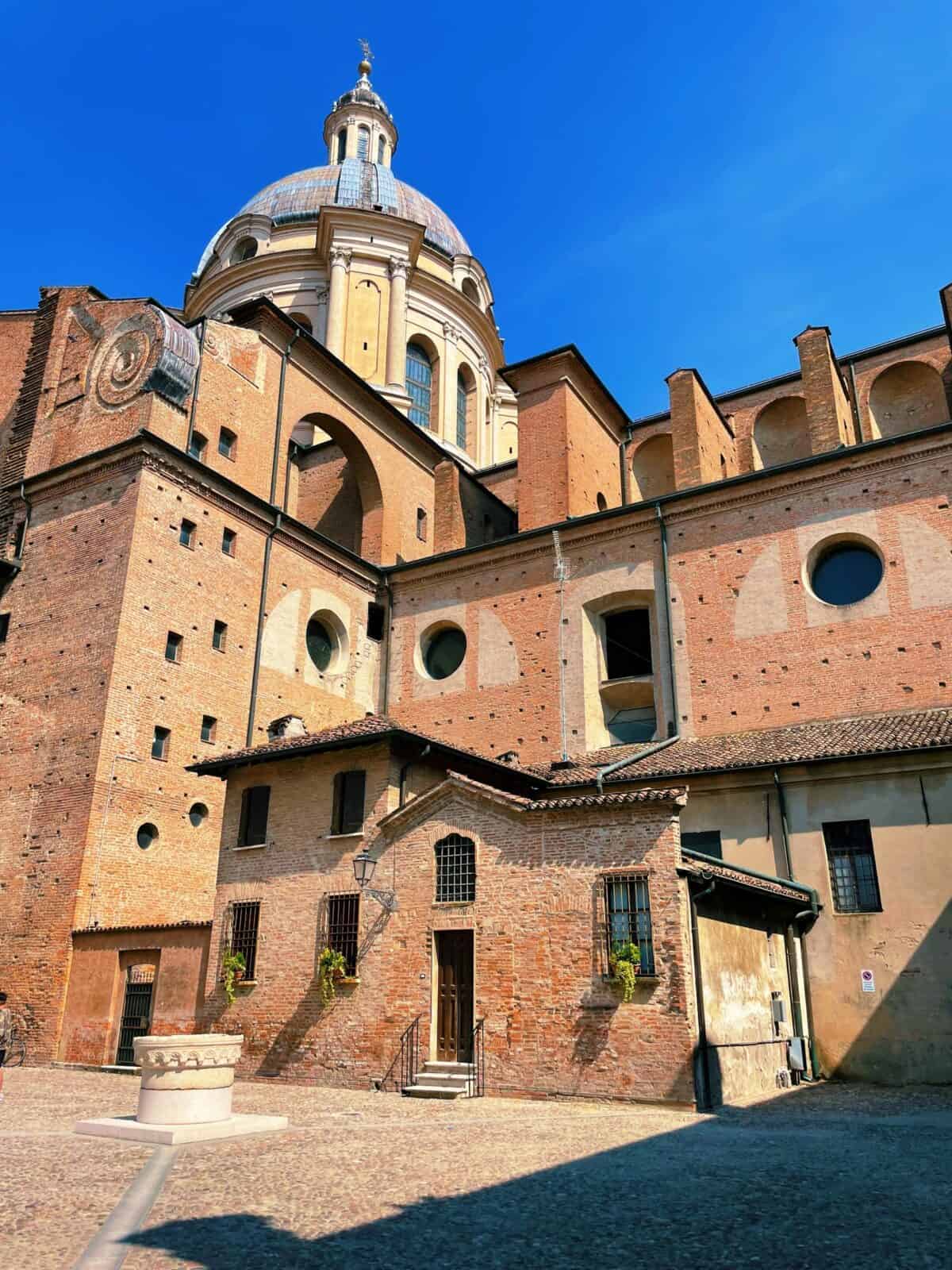
After two days in Verona, it’s time for your first day trip. Take a 45 minute train to Mantua, one half of the Mantua and Sabbioneta UNESCO site. (We’ll skip Sabbioneta, since it’s much harder to reach by train).
Mantua became a UNESCO site because it shows off “the renewal and extension of an existing city” under Renaissance town planning. The best way to experience this is to spend your day walking around the town and checking out its historical buildings.
On your final day in Verona, you’ll be taking on one more day trip to Peschiera del Garda, just a 15 minute train ride away.
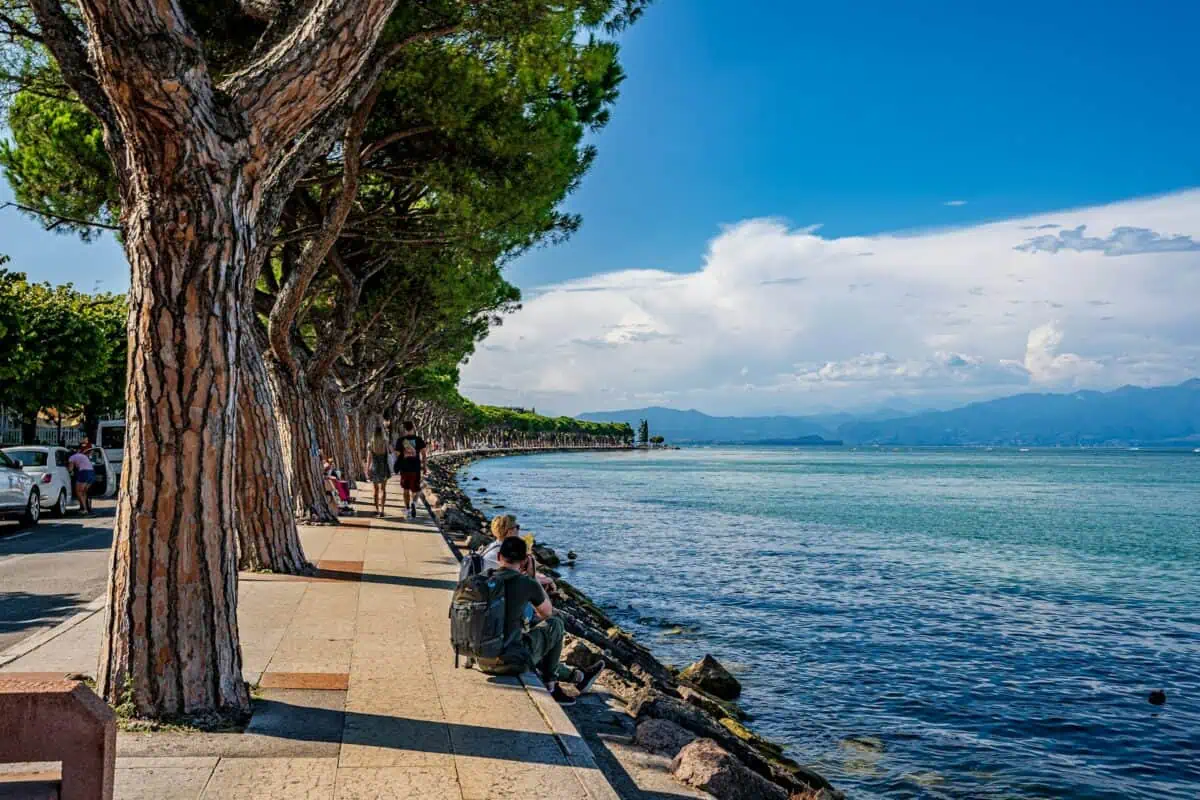
Peschiera del Garda is an example of a Venetian Work of Defence between the 16th and 17th Centuries. The Fortified city of Peschiera del Garda was once used to protect the Republic of Venice, but today you can just enjoy a stroll by Lake Garda.
From the city centre of Peschiera del Garda, you’ll actually be able to walk to your next UNESCO Site. Frassino, just a 15 minute walk away, is one of the Prehistoric Pile Dwellings around the Alps.
These prehistoric dwellings are stilt house settlements that were built on the banks of waterways from 5000 to 500 BC. They’re found throughout Europe with 19 in Italy.
Vicenza (2 nights)
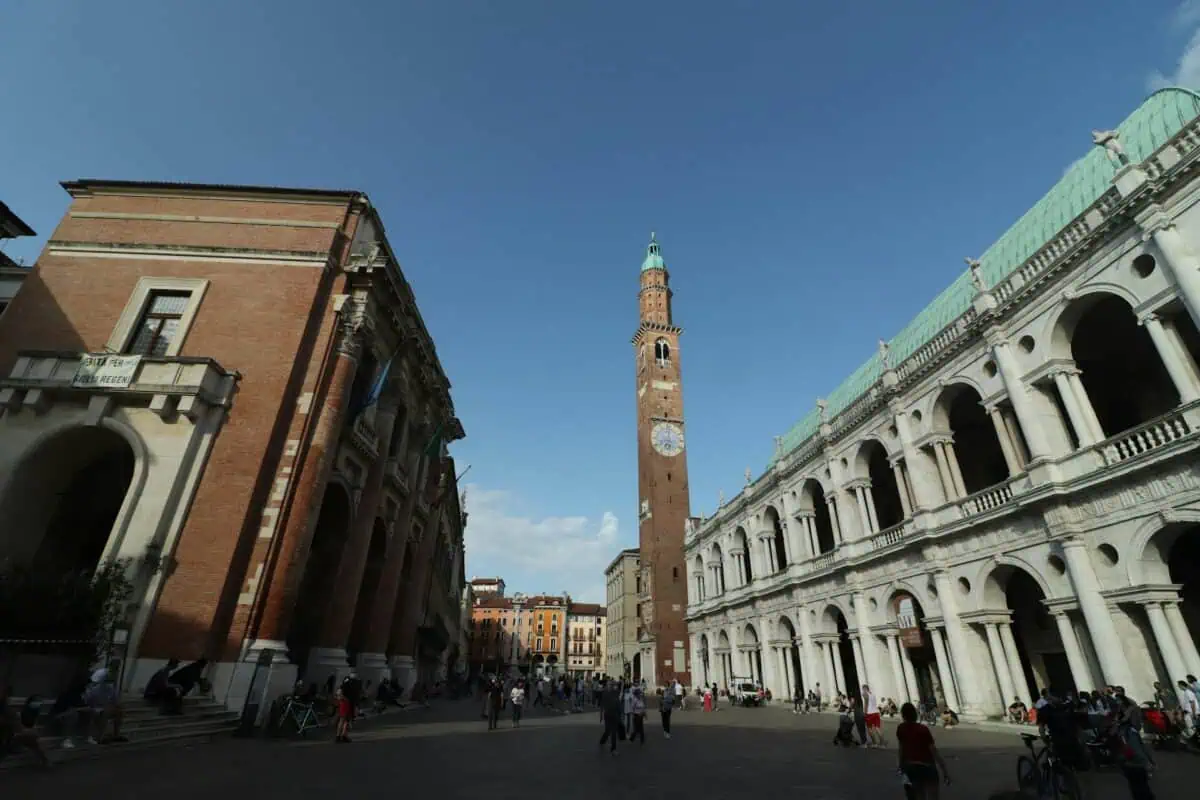
Hop on a train from Verona to Vicenza (25 mins), where you’ll spend the next two nights on your Italy itinerary.
Your first day is all about the City of Vicenza and the Palladian Villas of the Veneto. Vicenza was founded in the 2nd Century and is home to 23 buildings constructed by Palladio, which are examples of classical Roman architecture.
After enjoying the city’s unique look on your first day, your second day will see you off to nearby Padua (15 minute train ride).
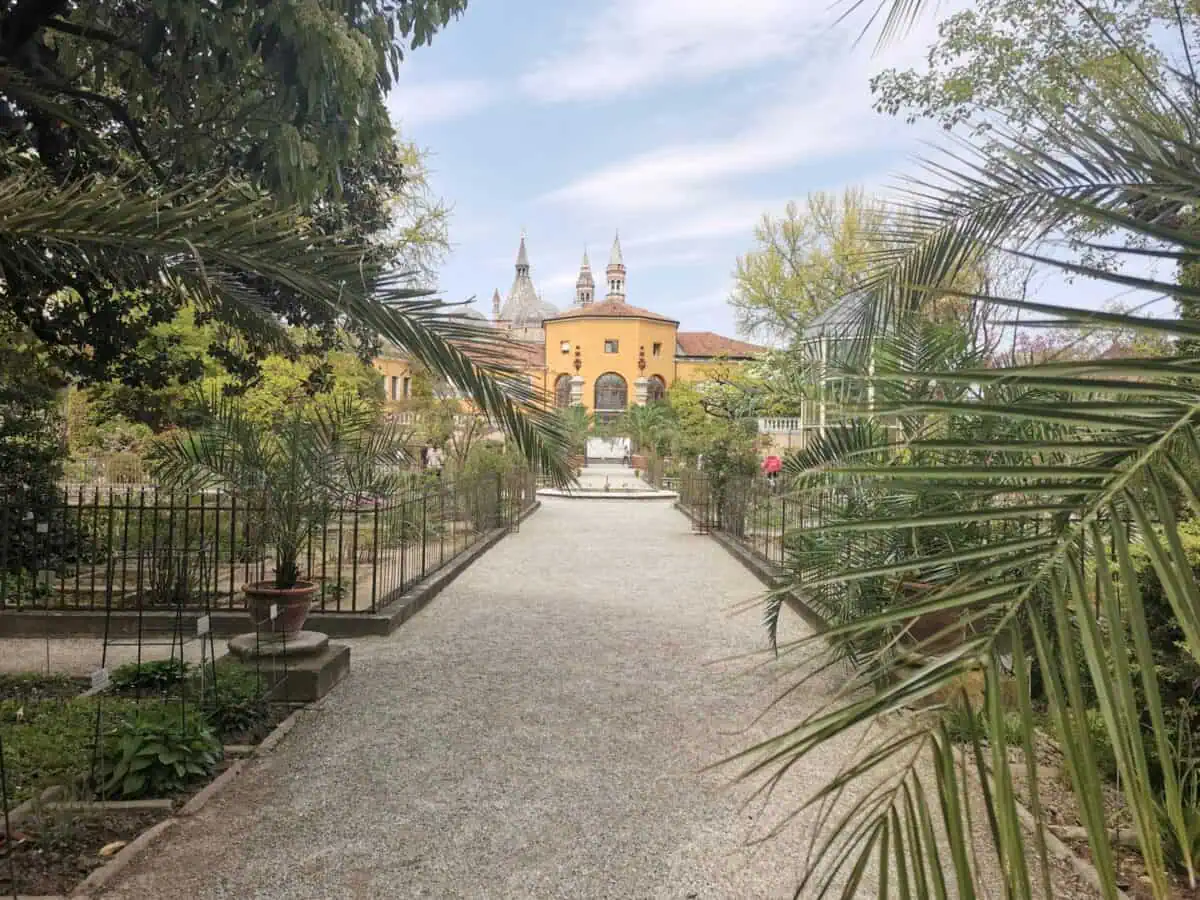
In Padua you’ll actually get to cross two UNESCO sites off your list: Padua’s fourteenth-century fresco cycles and the Botanical Garden (Orto Botanico) of Padua.
Padua’s famous frescoes can be seen in eight buildings around the walled city. The most famous is Giotto’s Scrovegni Chapel fresco cycle, which revolutionized mural painting.
Padua’s Botanical Garden was actually the first botanical garden in the world, created in 1545. I always love strolling through a botanical garden on my travels, so love the idea of seeing the OG!
Venice (2 nights)
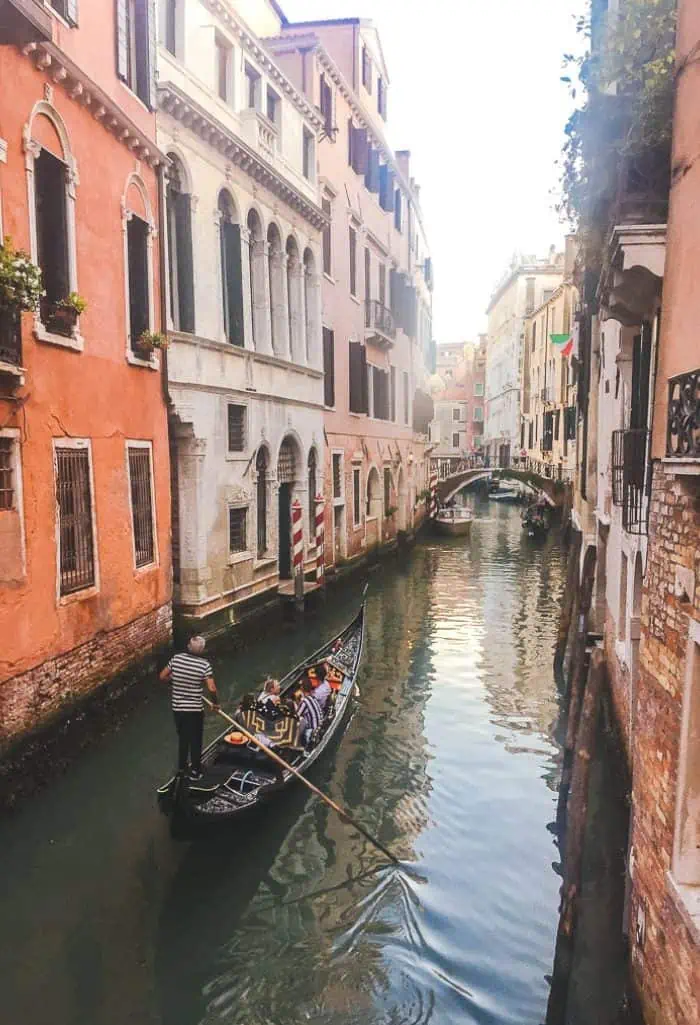
After two nights in Vicenza, you’ll travel to one of the most popular cities in all of Italy, Venice (45 minutes by train).
It’s no surprise that Venice and its Lagoon are considered a UNESCO World Heritage Site and a must on most people’s Italy bucket list.
But Venice can be polarizing. For every romantic gondola ride down the Grand Canal there’s overcrowded water buses, tourists galore in St Mark’s Square and next to no breathing space on the bridges.
I think the trick to Venice is to stay overnight – or in the case of this itinerary, two nights. Once the day trippers and cruise shippers leave, the city becomes a lot more pleasant.
It’s also a lot more pleasant off the main drag. Yes, you want to see Doge’s Palace, St. Mark’s Basilica and the Rialto Bridge but my favourite part of Venice was just turning down random hidden alleys and enjoying getting lost.
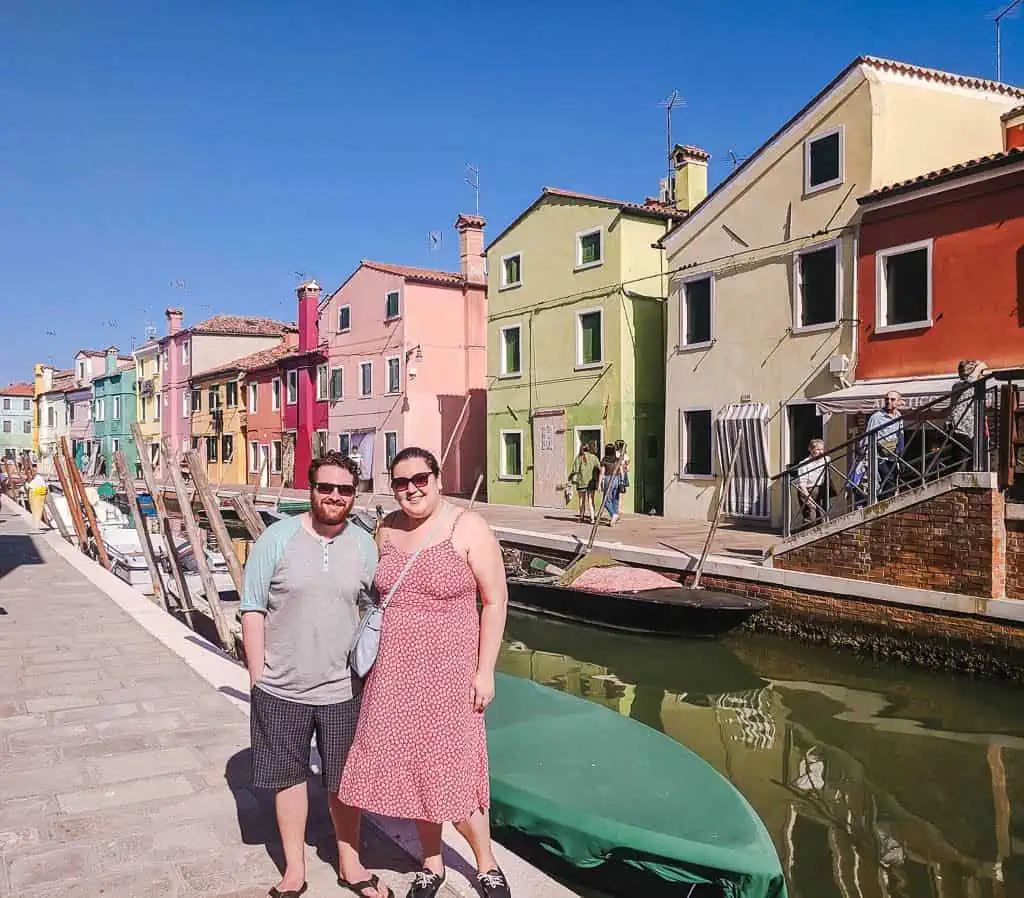
With two nights in Venice, you’ll also have time for a day trip to nearby islands of Murano and Burano. Here you can check out the colourful houses, glass blowing and lace making.
I highly recommend visiting these on a tour. We did it via public water bus and ended up waiting hours, stuck in the middle of a giant crowd in the late summer heat, as boat after boat passed us.
Conegliano (2 nights)
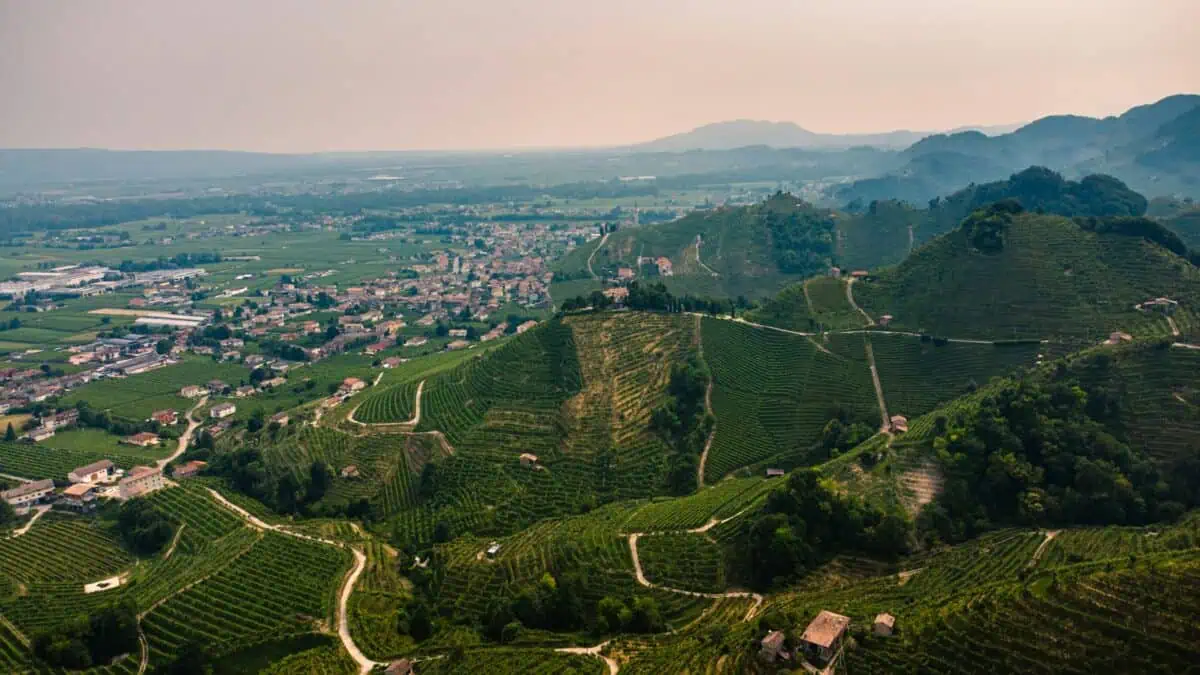
Your final stop in this region of Italy is Conegliano, just 50 minutes on the train from Venice.
In Conegliano it’s all about Le Colline del Prosecco di Conegliano e Valdobbiadene – aka the Prosecco hills! Photos of these hills remind me of the rice terraces in Bali or Vietnam, but of course with an Italian spin.
The best way to appreciate the Prosecco hills will be on a day tour from Conegliano. That way you can get out into the beautiful scenery and sample some of the good stuff for yourself.
I recommend going on a guided tour for this – such as this Prosecco Hills and Vineyards Tour from Conegliano – so you can leave the driving and guiding to someone else. If you want to drink some of the famous Prosecco, you don’t also want to be the designated driver.
PS: Since the Prosecco hills are actually in between Conegliano and Venice, you can actually visit them from Venice and stay based there. Check out this Prosecco Wine Tasting Tour from Venice!
Day 66-73: Northeast Italy
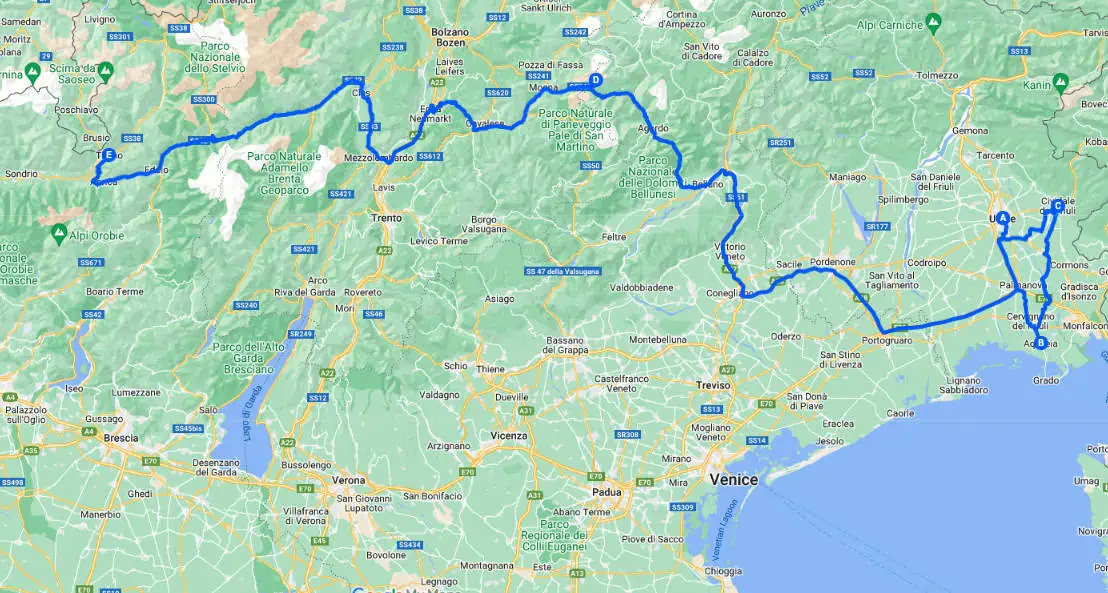
From Conegliano we’re pushing northeast to check a few more UNESCO sites off your Italian bucket list. At this point, the sites become a bit more spread out and a car may be more useful.
This is a region of Italy I haven’t discovered yet, but have long been fascinated by. The Dolomites in particular look absolutely beautiful.
Compared to the crowds of Venice, I’m sure you’ll find this Northern Italy itinerary much more peaceful and low-key.
Stops in Northeast Italy:
- Udine (3 nights)
- Dolomites (3 nights)
- Tirano (2 nights)
4 UNESCO sites: Longobards in Italy, Places of the Power (568-774 A.D.); Archaeological Area and the Patriarchal Basilica of Aquileia; The Dolomites; Rhaetian Railway in the Albula / Bernina Landscapes
Udine (3 nights)
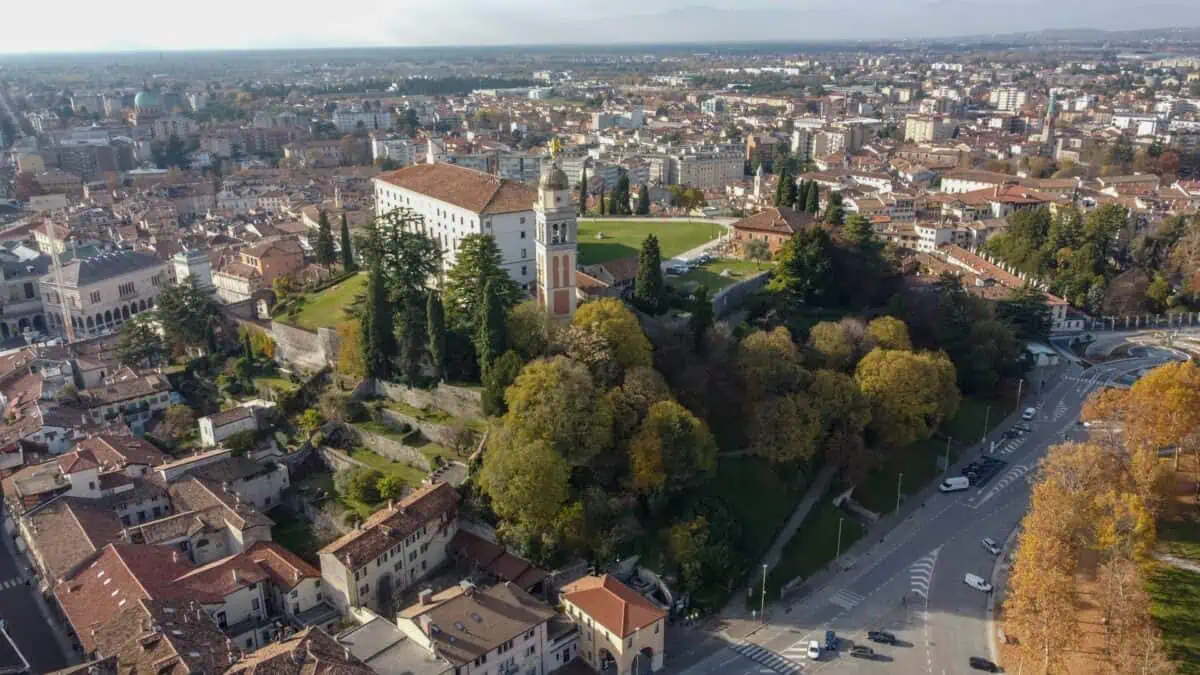
After your few nights in Conegliano, you’ll take a one hour train to Udine, which will be your base for the next couple of days. If you chose to stay in Venice instead of Conegliano, it’s an apx two hour train journey.
Use your first day to explore Udine. Climb up to Udine Castle to check out the museums and view over the city, relax in Piazza della Libertà, and see the baroque stylings of the Udine Cathedral.
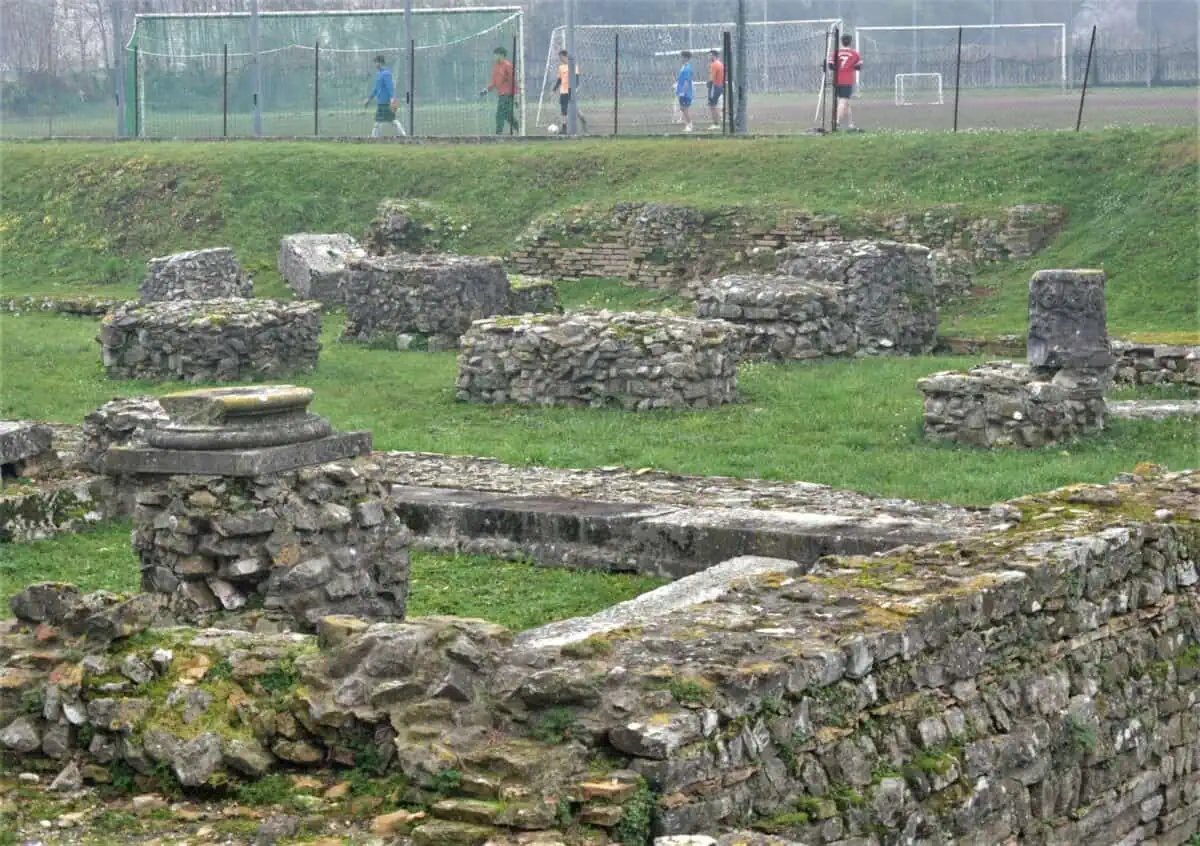
The next day, you’re off on your first day trip to see the Archaeological Area and the Patriarchal Basilica of Aquileia. You can get to Aquileia from Udine by bus (1 hour).
Aquileia used to be one of the largest and wealthiest cities of the Roman Empire until it was destroyed in the 5th Century. Now you can discover its ruins in Aquileia’s archeological reserve and basilica.
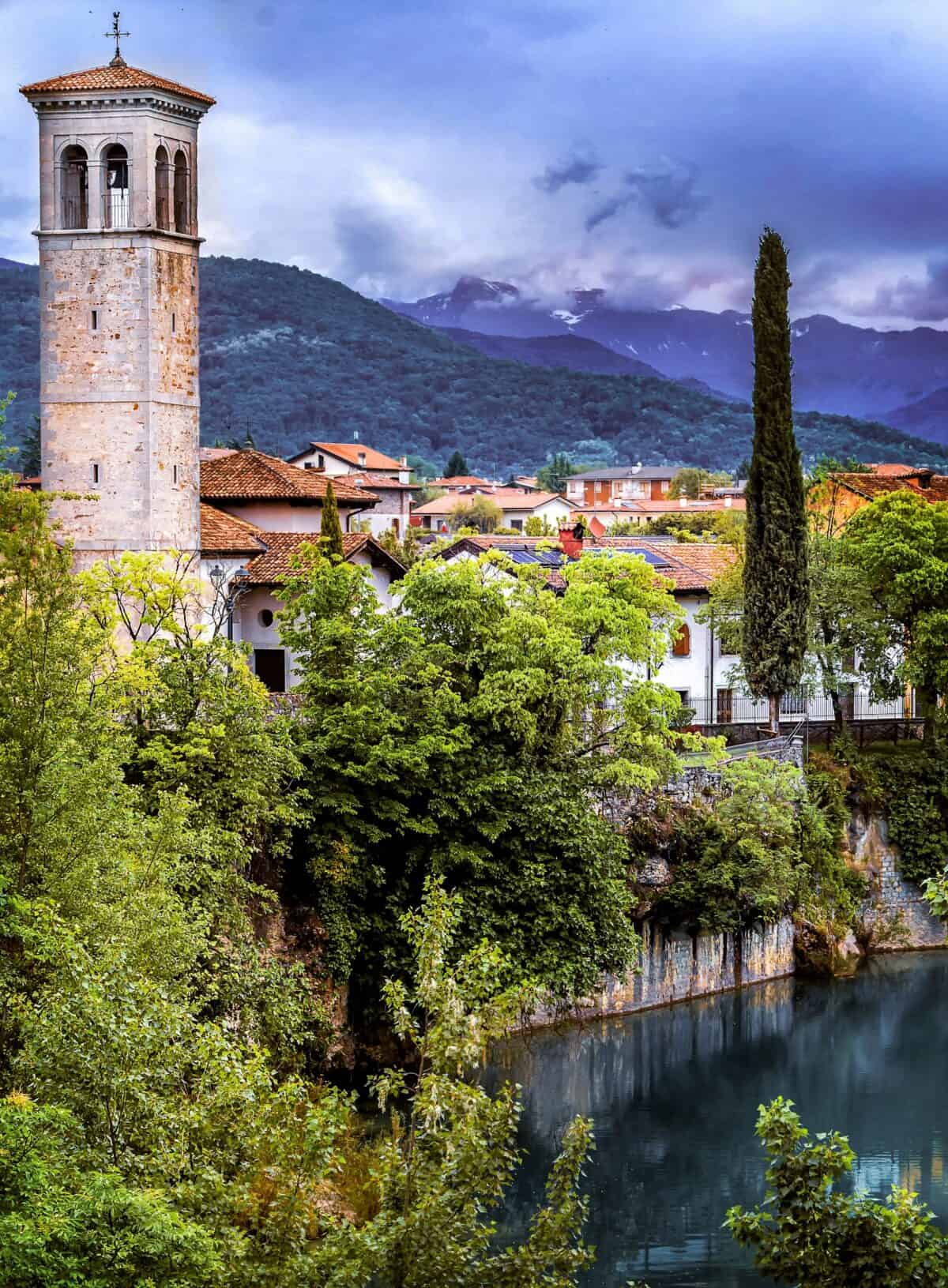
On your final day in Udine, take a 45 minute bus to Cividale del Friuli, one of the Longobards in Italy, Places of the Power (568-774 AD).
These longobard buildings “testify to the high achievement of the Lombards, who developed their own specific culture in Italy where they ruled over vast territories in the 6th to 8th Centuries.”
The Cividale del Friuli complex includes a small temple, remains of a palace, basilica and bapistry. Plus, the backdrop is quite picturesque!
Dolomites (3 nights)
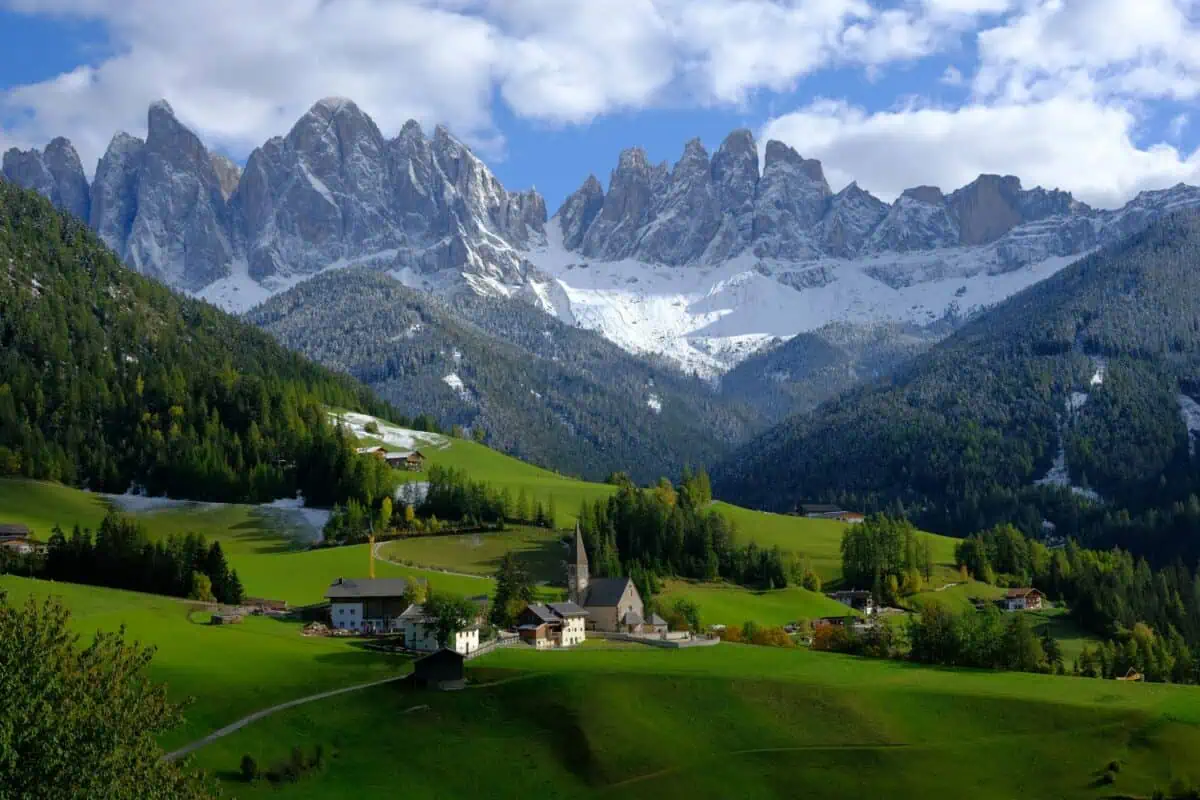
Pick up a rental car from Udine and drive onto the Dolomites (apx 3 hours). You’ll spend your next three nights here enjoying the natural beauty of Italy’s most famous moutains.
The scenery in the Dolomites looks incredible. You won’t run out of gorgeous landscapes to drive, hike, bike or ski through.
There are also great restaurants, shops and museums in some of the bigger towns, so you don’t have to spend all of your time in nature. Though with the gorgeous mountain backdrop, I don’t know how you’ll stay away.
Not driving? From Udine you can take an apx 5 hour train journey to Bolzano (transferring in Verona) or a 5 hour train journey to Cortina d’Ampezzo (transferring in Venice). Alternatively, you could stay based in Venice and go on this day tour to the Dolomites.
Tirano (2 nights)
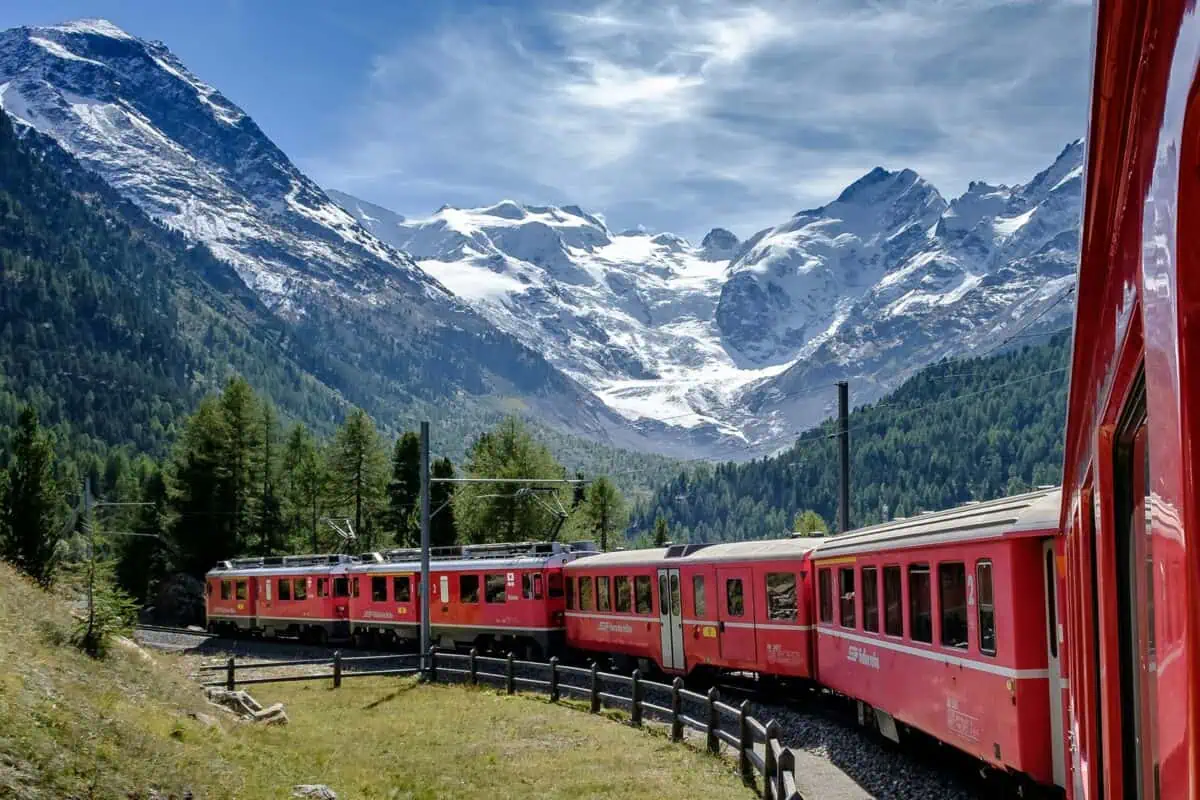
After your few days in the Dolomites, it’s time for one last stop in this region of Italy. We’re heading to Tirano to see the Rhaetian Railway in the Albula / Bernina Landscapes.
The Rhaetian Railway is where two railway lines intersect to cross through the Swiss Alps. This helped to bring small towns around the alps out of isolation in the 20th Century.
While most of the Rhaetian Railway is in Switzerland, part of it crosses over into Italy, which is why it’s counted as one of Italy’s UNESCO sites. The train station in Tirano, Italy is part of the Rhaetian Railway, so that’s where we’re headed.
Depending on where you’re based in the Dolomites, it should take you about four hours to drive to Tirano. Since you have two nights here and only need to see the railway station, you can take your time.
In fact, you could use part of your two nights to cross into Switzerland, since you’ll be right across the border!
Not driving? Your best bet is to return to Venice or Verona from the Dolomites where you’ll take a four hour (from Verona) or five hour (from Venice) train journey to Tirano (connecting in Milan).
Day 74-79: Lombardy
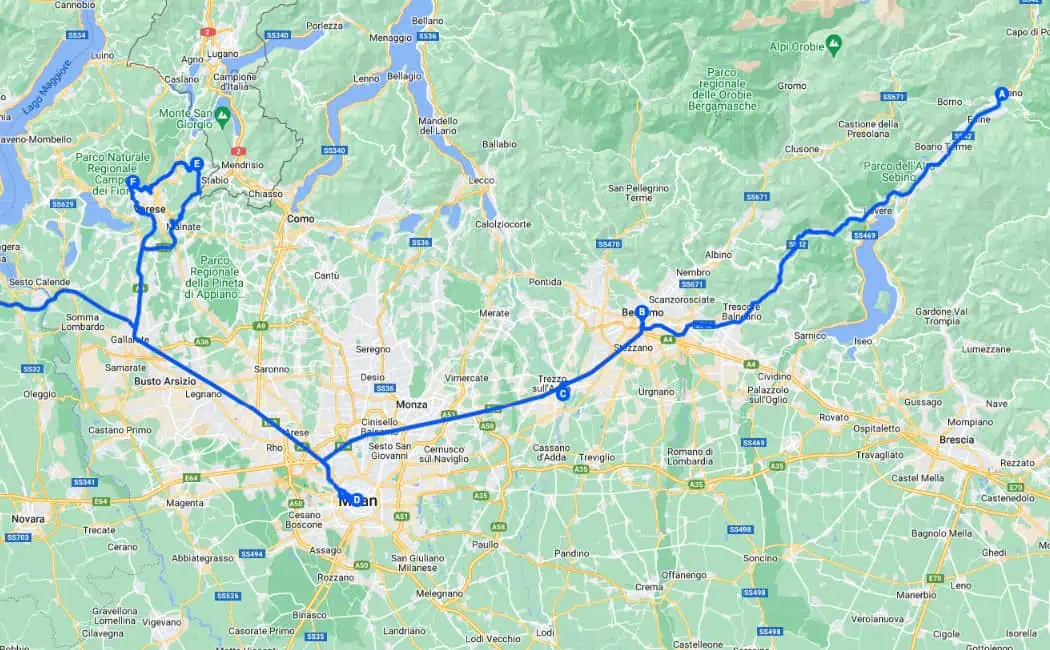
We’ve tackled the northeast and now we’re moving back west as we near the end of this monster Italian itinerary.
Your Lombardy itinerary is short and sweet – only two stops – but we’re packing in five UNESCO sites. From petroglyphs to religious paintings, this should be a fun exploration of a more affluent section of Italy.
Stops in Lombardy:
- Bergamo (2 nights)
- Milan (4 nights)
5 UNESCO sites: Rock Drawings in Valcamonica; Crespi d’Adda; Church and Dominican Convent of Santa Maria delle Grazie with “The Last Supper” by Leonardo da Vinci; Monte San Giorgio; Sacri Monti of Piedmont and Lombardy
Bergamo (2 nights)
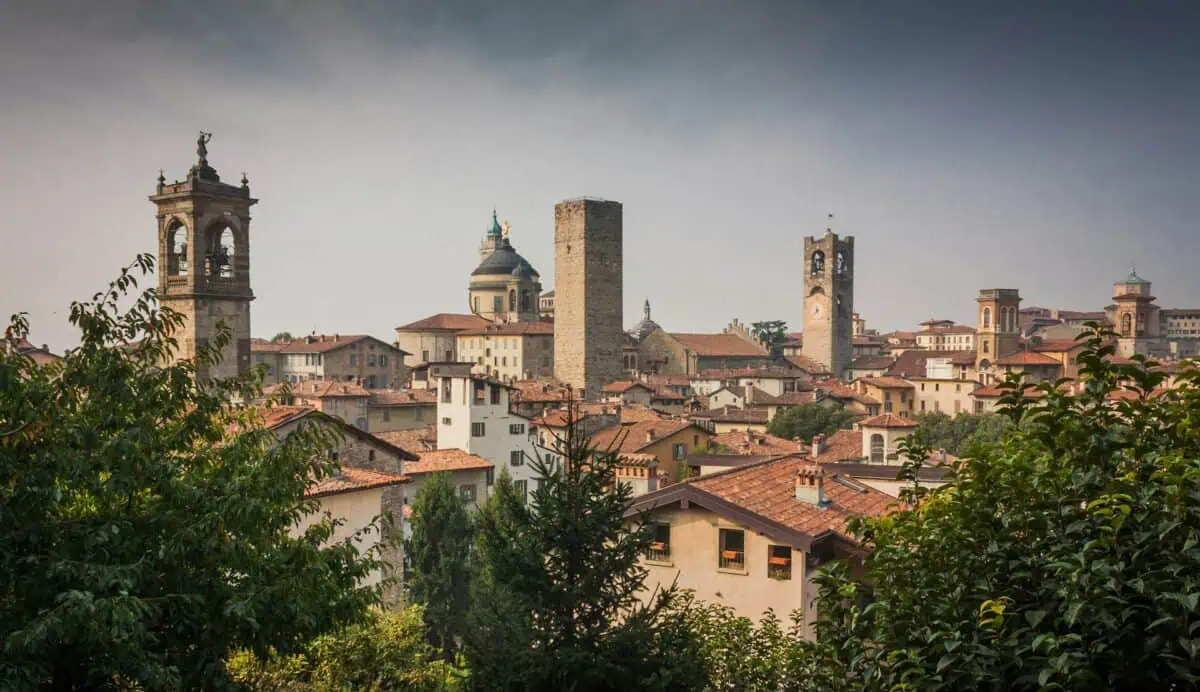
From Tirano you’ll drive about an hour to see “one of the world’s greatest collections of prehistoric petroglyphs.” The Rock Drawings in Valcamonica consist of over 140,000 symbols and figures throughout the Lombardy plain.
I would never have guessed Italy would be the place to see ancient rock carvings – how cool!
After checking out the prehistoric drawings, continue driving onto Bergamo (apx 1.5 hrs). You’ll have two nights here to explore and enjoy the city.
Technically there is a UNESCO site in Bergamo, the Mura Veneziane-Patrimonio or the Venetian Walls of Bergamo. But it’s part of the same Venetian defence sites you saw at Lake Garda, so won’t count as a new UNESCO site.
However, Bergamo’s Venetian Walls and the entire old town of Città Alta look well worth exploring. Walking the walls is one of the top things to do in Bergamo, so you might as well check this bonus UNESCO site off your list!
Not driving? The easiest rock drawing area to get to from Tirano is Cemmo National Archaeological Park (2 hrs by bus and train). From there it’s another apx 3.5 hours on buses and trains to Bergamo or Milan.
Alternatively, you could take a taxi or private driver from Tirano to Parco Pluritematico and back (55 mins each way), then train directly to Milan from Tirano (2.5 hrs), skipping Bergamo.
Milan (4 nights)
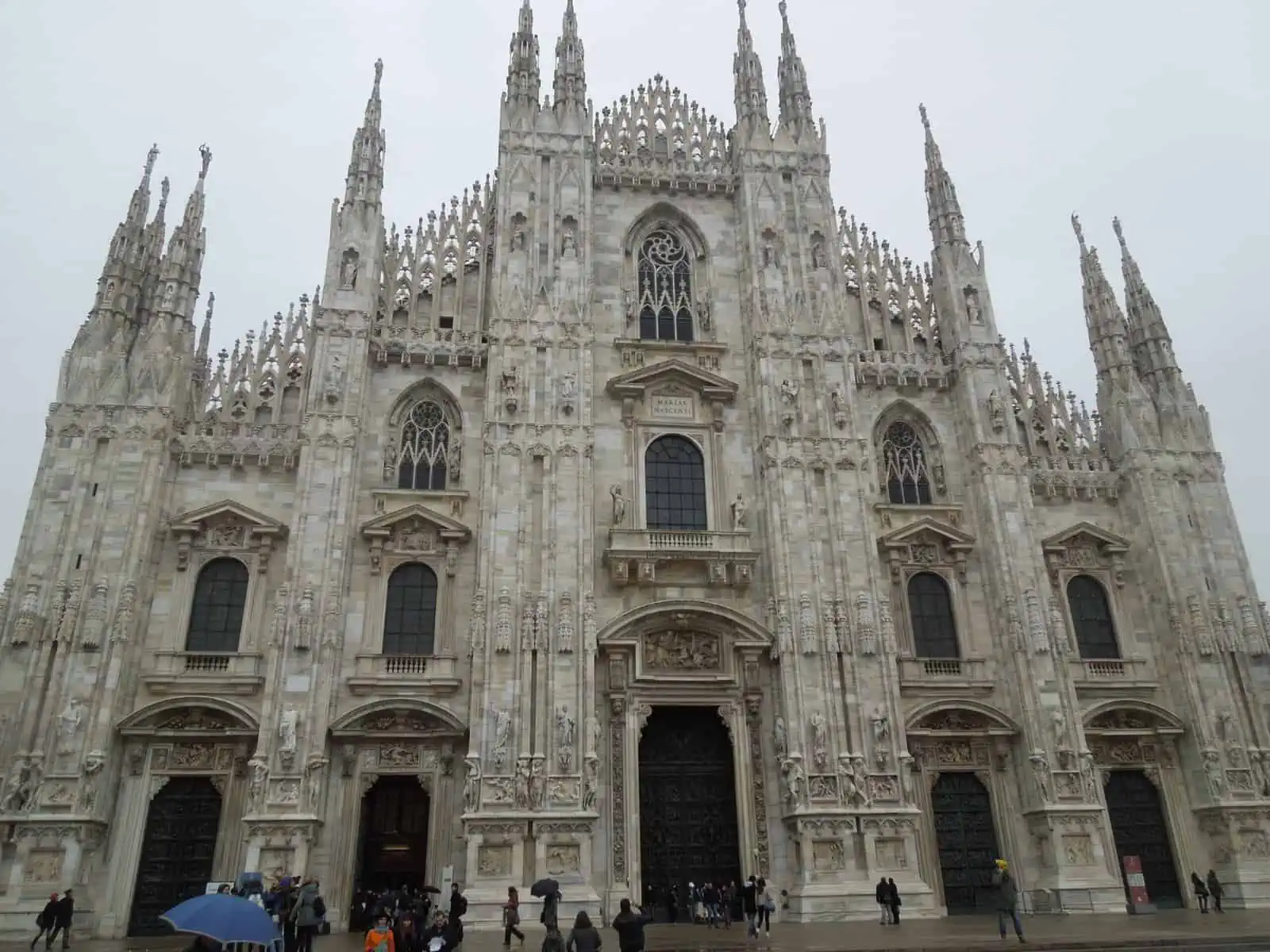
Today you’ll move onto your next base, Milan. As you head out from Bergamo to Milan, you’ll make a stop at Crespi d’Adda (20 min drive).
Crespi d’Adda was a workers’ town, built in the 1920’s to supply a steady workforce to the nearby textile factory. It was declared a UNESCO site because it’s an ideal example of the “company town” that became popular in the 19th and 20th Centuries.
This is one of the more fascinating UNESCO sites in Italy to me as it’s not as historic as a Renaissance town square or prehistoric cave drawing. It’s interesting to see the more modern additions to the UNESCO list too.
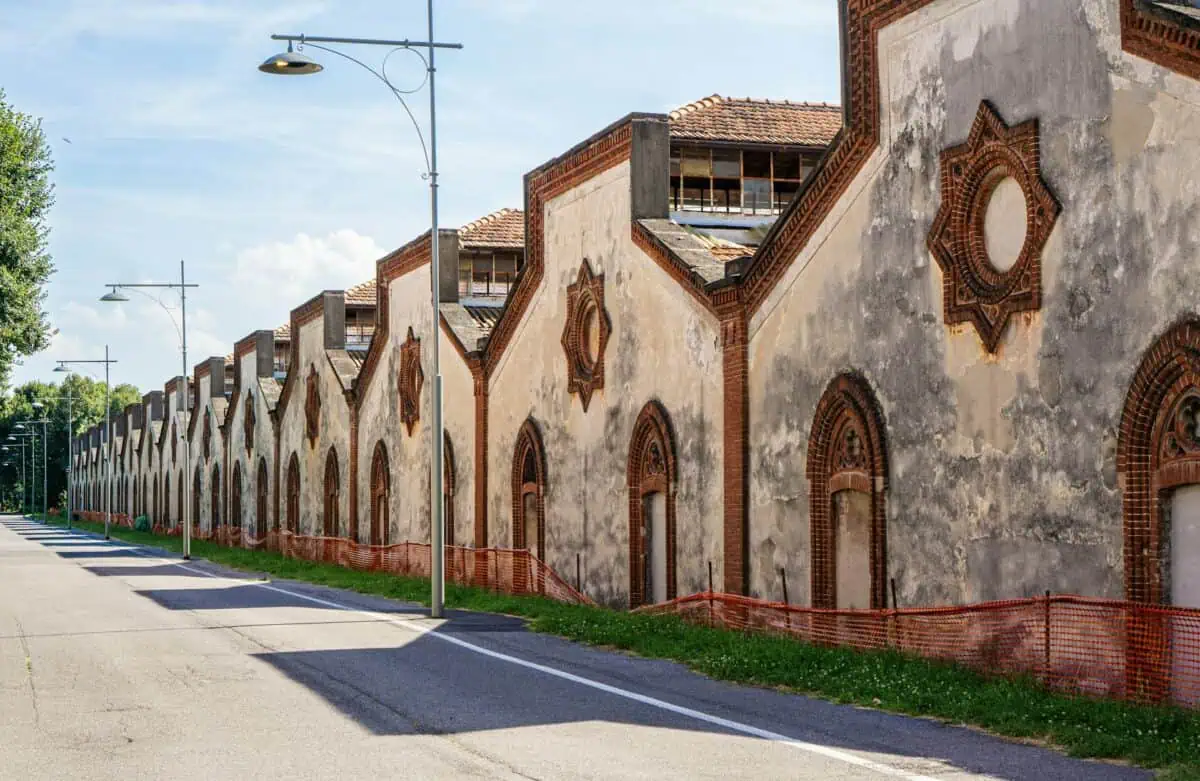
From Crespi d’Adda, you’ll continue onto Milan (40 minutes) and return your car. Enjoy your first night in Milan by tucking into a famous bowl of Milanese risotto.
Not driving? From Bergamo it’s a one hour bus ride to Crespi d’Adda. Then it’s a 1.5-2 hour bus/train ride into Milan. After that, you won’t need a car!
On your first full day in Milan, you have to see to the famous Church and Dominican Convent of Santa Maria delle Grazie with “The Last Supper” by Leonardo da Vinci.
Even for those not trying to tick off every UNESCO site in Italy, seeing The Last Supper in Milan is a must-do. I saw it when I visited Milan in 2014 and was pretty impressed. They also take their security very seriously – you’ll go through an airlock chamber before entering!
It is essential that you buy your tickets to The Last Supper in advance. These tickets sell out fast as only a few small groups are permitted to see the painting each day. Buy your Last Supper tickets with a guide here!
Spend the rest of your day in Milan admiring the Cathedral, Duomo and Galleria Vittorio Emanuele II, visiting the Sforza Castle, learning about da Vinci’s inventions at the Leonardo da Vinci Museum of Science and Technology, or shopping until you drop in Italy’s fashion capital!
The next day, you’re off on a day trip to Viggiu (1.5 hour train) to see Monte San Giorgio. Monte San Giorgio is a wooded mountain that holds the “best fossil record of marine life from the Triassic Period.” Unleash your inner archeologist!
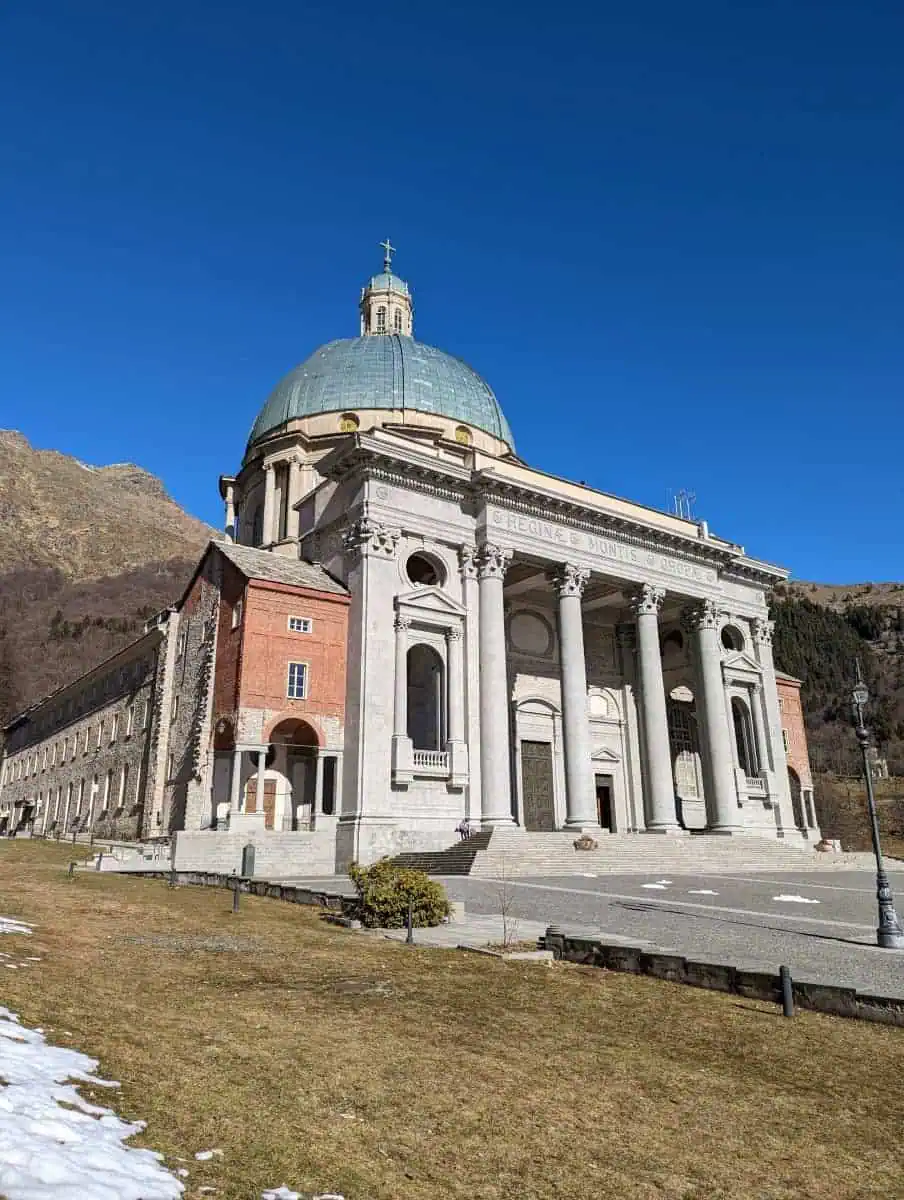
After a day of fossil finding, your last day in Milan is dedicated to another day trip. This time you’ll travel to Sacro Monte di Varese (90 min by train & bus), one of the Sacri Monti of Piedmont and Lombardy.
Sacri Monti (Sacred Mountains) are Christian faith monuments built into the mountains of northern Italy in the 16th and 17th Centuries. They’re renowned for their spiritual meaning and for how well they integrate into the nature around them.
Day 80-87: Piedmont & Liguria
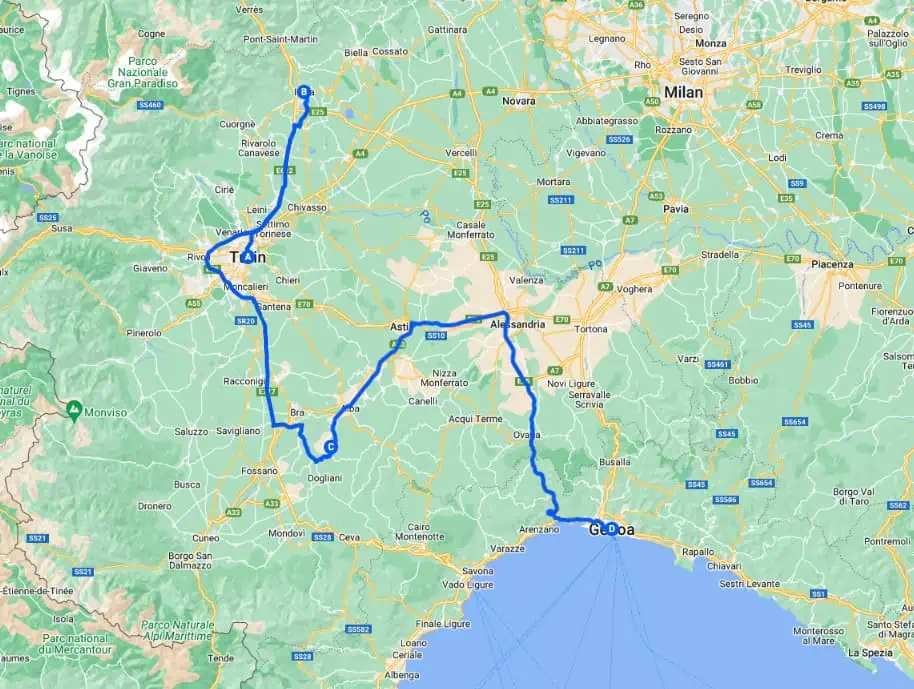
Sadly, your itinerary through all of Italy’s UNESCO sites is nearing an end.
You have one final week and four UNESCO World Heritage Sites to tick off before you head home, accomplished yet tired, having experienced the best of Italy’s nature and culture.
For this final week, we’re hanging out in Piedmont and Liguria, on the northwest side of Italy. We’ll see some cities, some nature and end our time on the coast!
Stops in Piedmont & Liguria:
- Turin (4 nights)
- Genoa (4 nights)
4 UNESCO sites: Residences of the Royal House of Savoy; Ivrea, industrial city of the 20th century; Vineyard Landscape of Piedmont: Langhe-Roero and Monferrato; Genoa: Le Strade Nuove and the system of the Palazzi dei Rolli
Turin (4 nights)
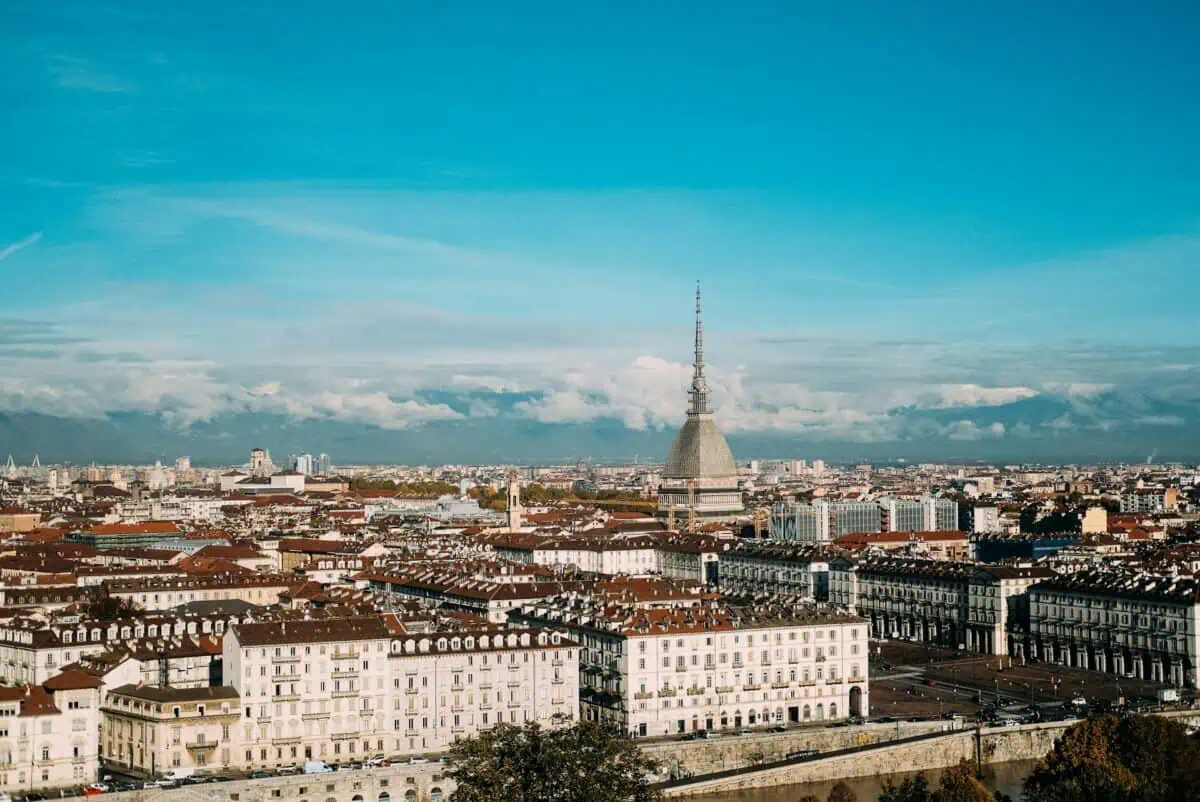
From Milan, you’ll take a one hour direct train to your next base, Turin. Use this day to explore the capital of Piedmont at your own pace.
You may want to climb the Mole Antonelliana for a view over the city, see mummies at the Museo Egizio, admire the Duomo di San Giovanni, and enjoy an aperitivo, which was invented in Turin.
The next day, head to the Palazzo Reale, one of the Residences of the Royal House of Savoy. The Palazzo Reale, as well as a number of other buildings in and around Turin, were created by the Duke of Savoy when he moved his capital to Turin in 1562. Be amazed by the royal splendour!
Get your skip-the-line tickets to the Palazzo Reale here
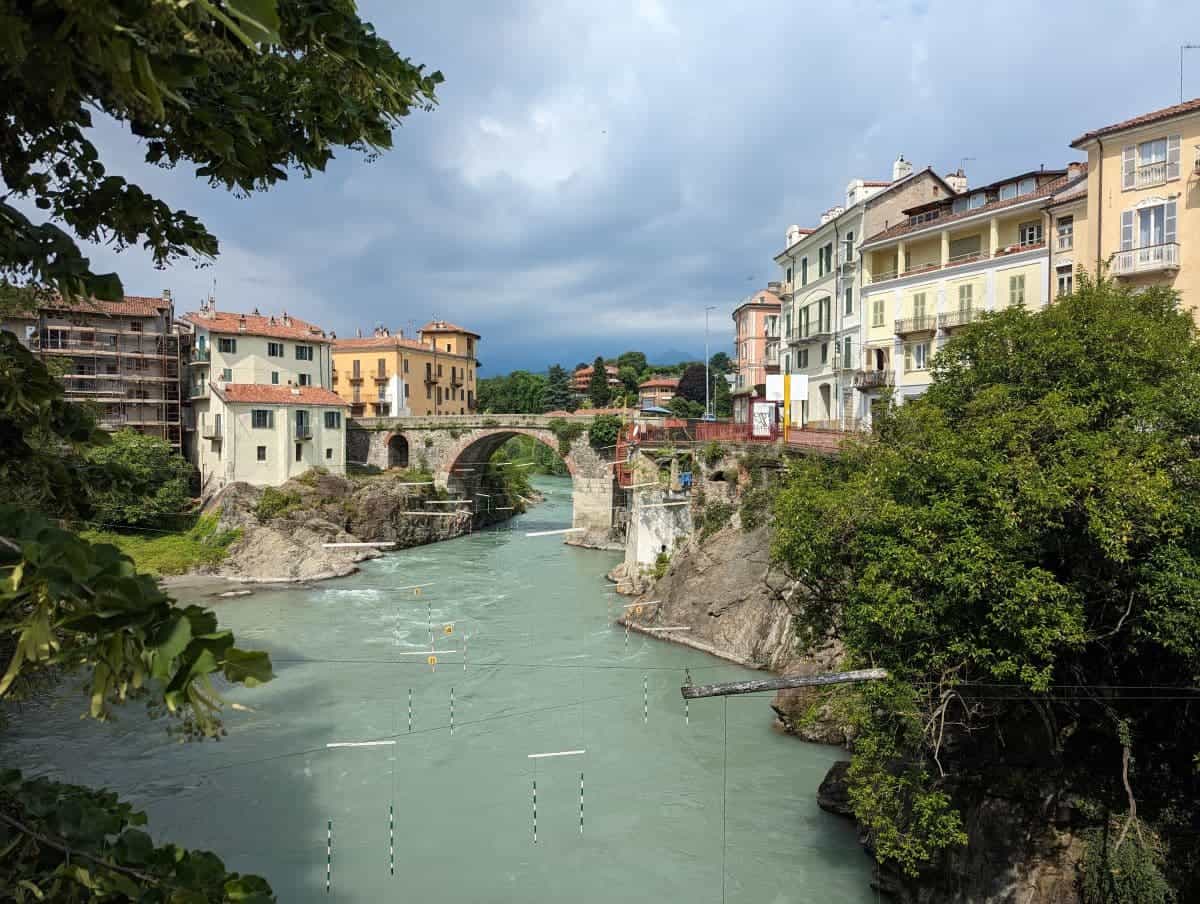
Day three in Turin and it’s time for a day trip. Take a 75 minute train to Ivrea, industrial city of the 20th Century. Ivrea was created under the Community Movement from the 1930’s to 1960’s and built up around the town’s factory.
Ivrea is meant to be a “modern vision of the relationship between industrial production and architecture.” Go see for yourself if you think they struck the right balance!
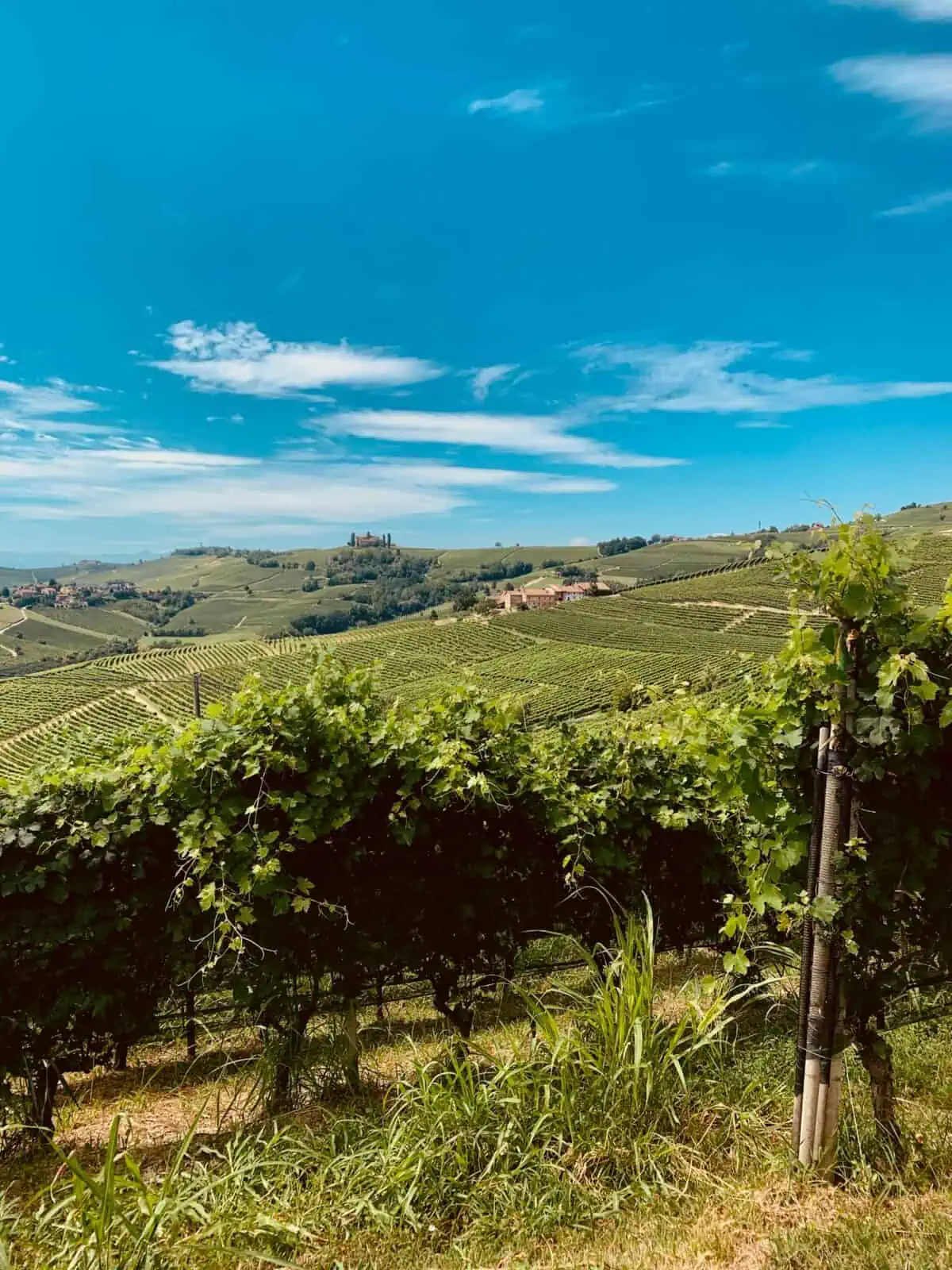
On your final day in Turin, you’re off on one more day trip. This one should be a lot of fun because you’re visiting the Vineyard Landscape of Piedmont: Langhe-Roero and Monferrato.
For this trip into Piedmont’s wine country you can rent a car for the day, take transit or join a day tour. If you rent a car, you can drive apx one hour into the Piedmont countryside and go on a Truffle Hunting and Winery Tour with Tasting.
By transit, you can take a 1.5-2 hour bus/train journey to a local winery and go on a Vineyard Tour and Wine Tasting. Or you can sit back and enjoy a private day tour from Turin, such as this Langhe Wine Tour with Private Transfers and Lunch.
Genoa (4 nights)
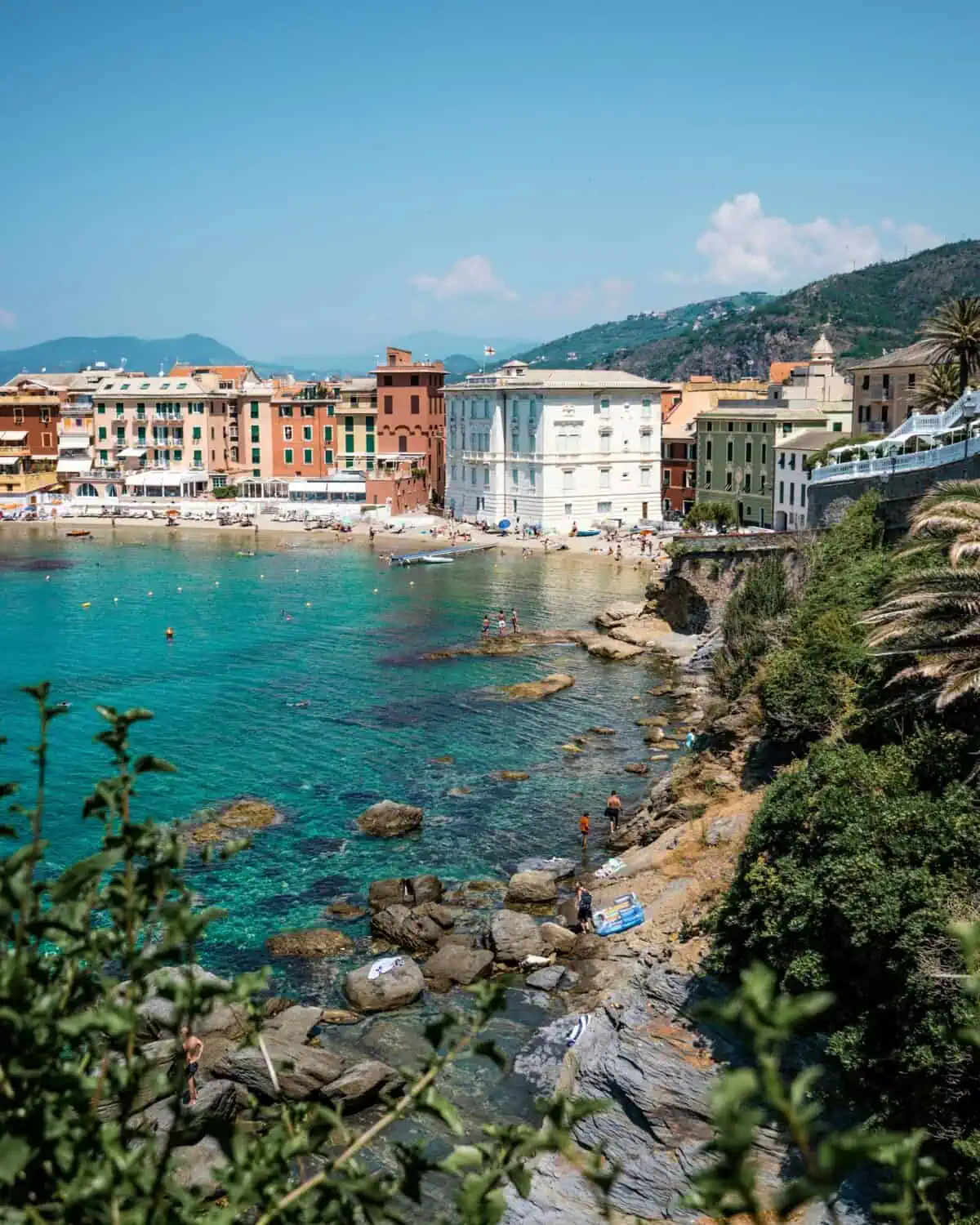
The last stop on your Italy itinerary is the seaside town of Genoa. From Turin, you’ll take a two hour direct train to Genoa.
There’s only one UNESCO site in Genoa for you to cross off your list, but I’m giving you four nights here because I can’t think of a better way of ending your time in Italy than relaxing by the coast.
You’ll definitely want to make sure you see Genoa’s Le Strade Nuove and the system of the Palazzi dei Rolli. These streets are located in Genoa’s historic centre and are an example of the type of urban development that was happening in Europe in the 16th Century.
Check out the Renaissance and Baroque palaces on the new streets, such as the Palazzi dei Rolli, and sneak a peek at the private residences nearby meant to host state visits.
While you’re in Genoa you can also admire the Cathedral Of San Lorenzo, stroll along the Old Port, people watch in Piazza De Ferrari, tour the Palazzo Reale and walk the town walls.
Get lost among the winding alleyways, eat fresh seafood and if the weather is nice, hit the beach! You can also use Genoa as a base to visit more small towns along the Italian Riviera.
Day 88-90: Head home!
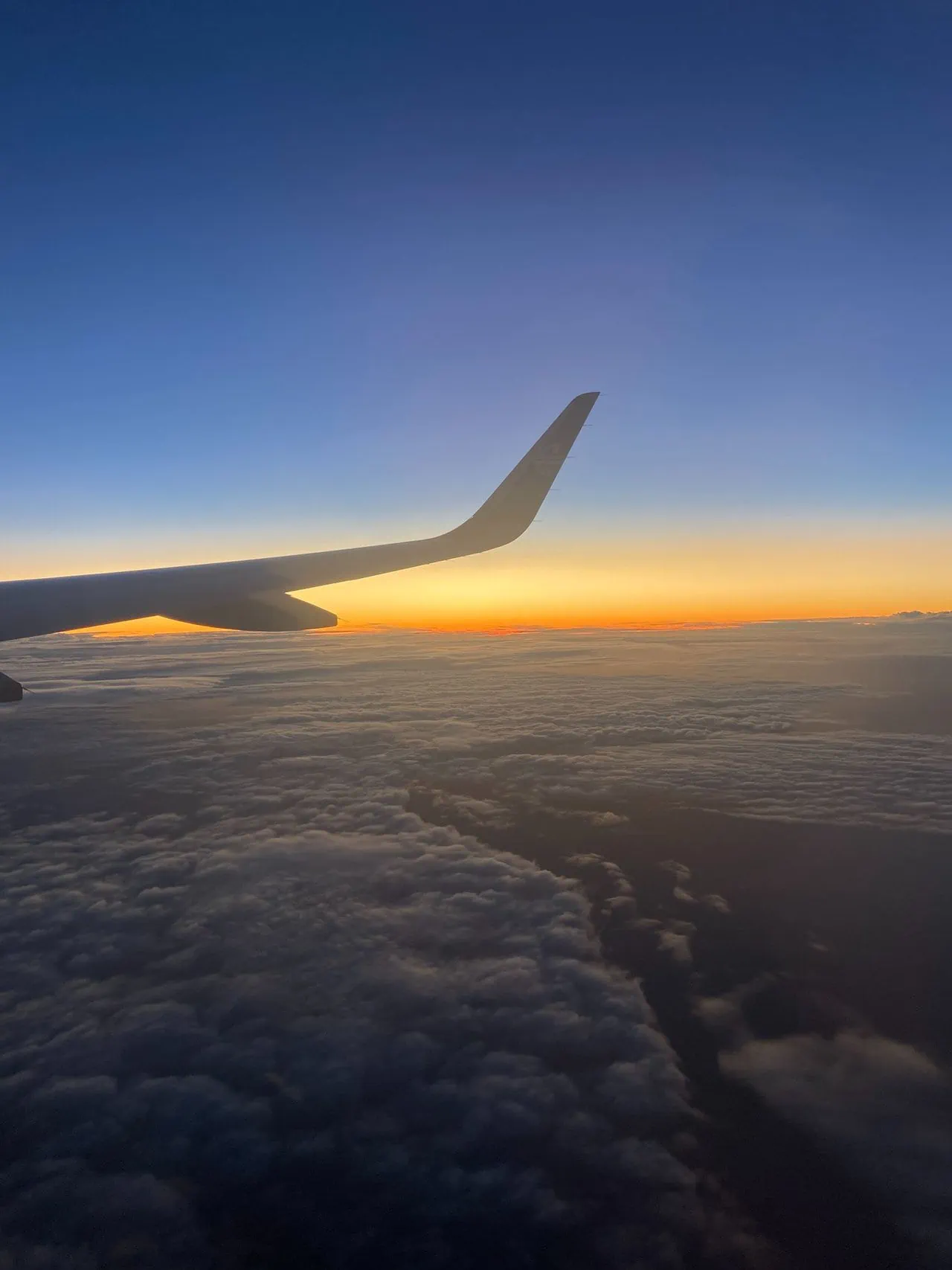
And with that, your Italy UNESCO itinerary is complete and it’s time to head home. You can fly directly from Genoa’s airport or you can take a fast train to Turin, Milan or Rome and fly from there.
But why are you leaving Italy on Day 88 when this is a 90 day itinerary?
I purposefully designed this itinerary so it would be a little under 90 days. That’s because I strongly believe in having a buffer.
If you’re a non EU citizen, you may only be allowed to spend 90 says in the Schengen Zone (of which Italy is a part). Rather than risking your legal ability to stay in the zone by pushing this itinerary to the full 90 days, I’m giving you 2-3 buffer days.
Use these days to start heading home. You may not be able to fly home directly from Genoa, so you may need a day or two to actually exit the Schengen Zone. Or what if your flight leaving is delayed or you miss a train?
Play it safe and plan to head out of Italy by day 88!
Italy itinerary FAQs

How many days are enough for Italy?
7-10 days is a great amount of time for a trip to Italy. This would allow you to explore a few bases in one region, such as Rome (3-4 days), Naples (2-3 days) and the Amalfi Coast (2-3 days).
Another great one week in Italy itinerary could be Florence (2 days), Siena or another Tuscan town (3 days) and Cinque Terre (2 days).
Of course, if you want to complete my entire Italian UNESCO itinerary above, I recommend taking a full 90 days. You could probably shave a week or two off, but travel burnout is real, so I wouldn’t try to rush through all 59 sites across the entire country.
In what order should I visit Italy?
Start with what’s important to you and then with what makes sense geographically. For example, if Rome is on your bucket list, start there.
From Rome, you can move north or south very easily by train. Italy has a great train network, so take advantage of it. If possible, try to move in one direction so you’re not backtracking.
I also recommend breaking up your big cities with stops in nature.
As tempting as it can be to try and see everything in Italy, I wouldn’t suggest it unless you have a lot of time. If you only have a week or two, don’t try to cover everything from Sicily to Venice.
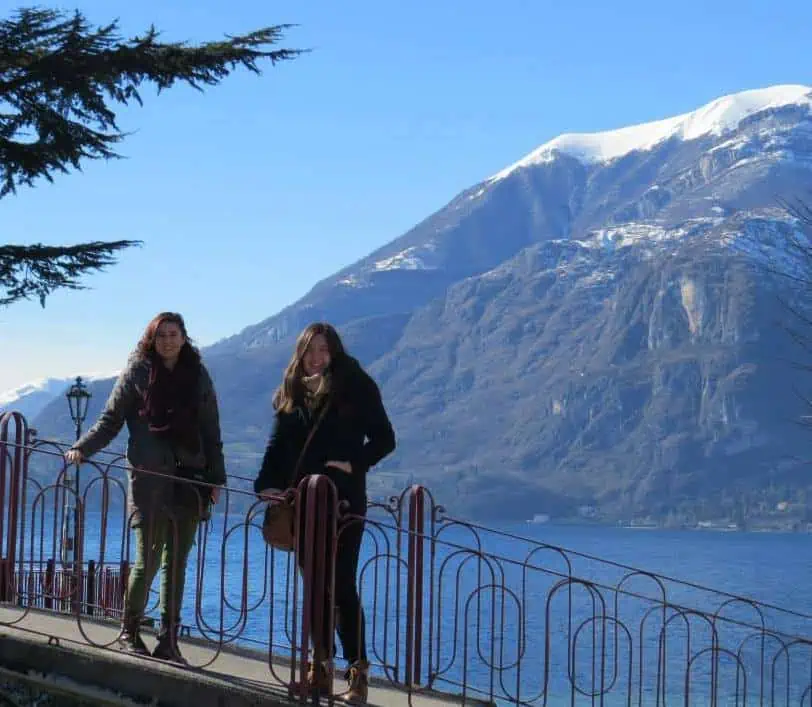
Where should I go for my first time in Italy?
I just so happen to have a post that will help you plan your first Italy visit! In that post, I break down some great options for a first time visit and where you should go based on your interests.
Not knowing your specific interests, my general suggestion for someone’s first time in Italy would be Rome, Naples and the Amalfi Coast.
I suggest these three bases because they’re close to each other (no wasted hours on planes or long bus rides) and yet all offer something completely different.
In Rome, you’ll find the Italy you know from the photos. Dive deep into history and art, checking places like the Colosseum and Sistine Chapel off your bucket list.
In Naples, you’ll be introduced to a slightly grittier version of Italy that’s a little more down to earth. There will still be beautiful monuments and some of the best food you’ve ever tasted.
Lastly, end your trip on the Amalfi Coast. You’ve seen the cities, so now it’s time to escape to a bit of beautiful nature and enjoy some luxury. Take in the views, hike or shop, and enjoy a little too much limoncello.
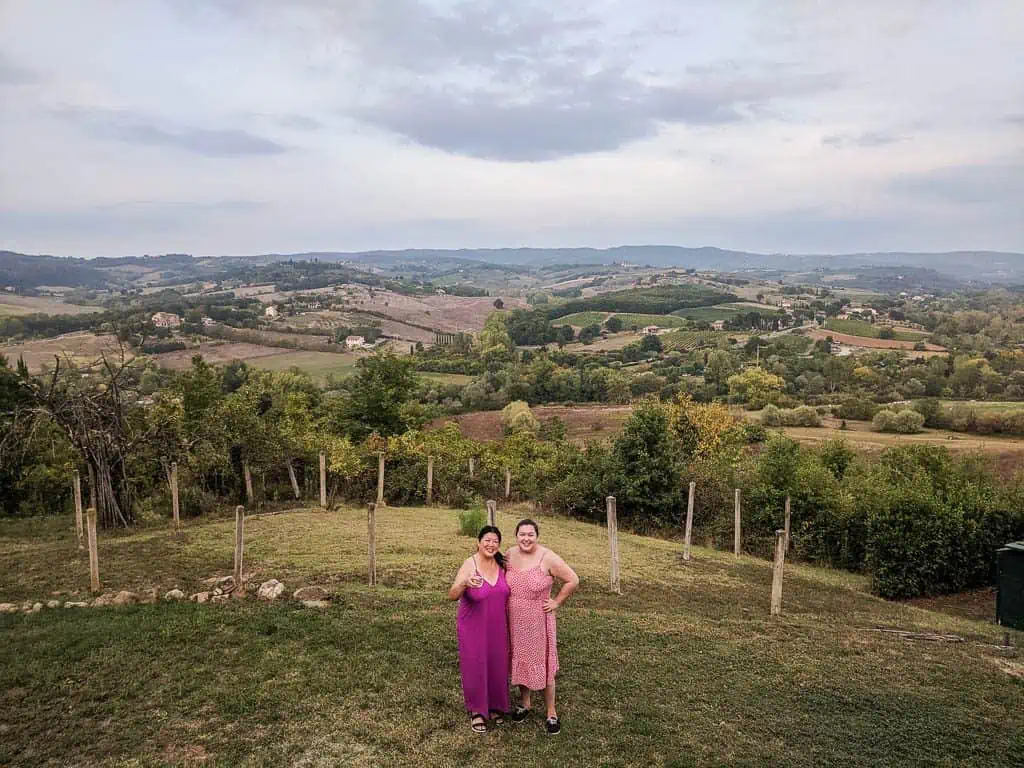
Do I need a rental car for when visiting Italy?
Generally speaking, you do not need to rent a car when visiting Italy. The country is very well connected by fast trains, making day trips and onward travel very easy.
In many cases, train travel is faster than driving – for example, Rome to Florence by car is 3 hours and 10 minutes but only 90 minutes by train.
Plus there are many places – like Rome and Florence – where you wouldn’t want a car. Driving in a busy city with daredevil local Italian drivers is not a good idea. Plus, who needs a car when you have trains, public transport and your own two feet?
That being said, there are some parts of Italy where having a car would be handy. Driving around the island of Sardinia or hilltop towns of Tuscany is much easier by car – and very long or impossible by public transport.
However, if you don’t want to rent a car, you can still enjoy a visit to these parts of Italy. As I share in my itinerary above, there are bus and train connections. You can also head out on day tours from major cities and leave the logistics to someone else.
Wrapping up your itinerary through Italy’s UNESCO sites
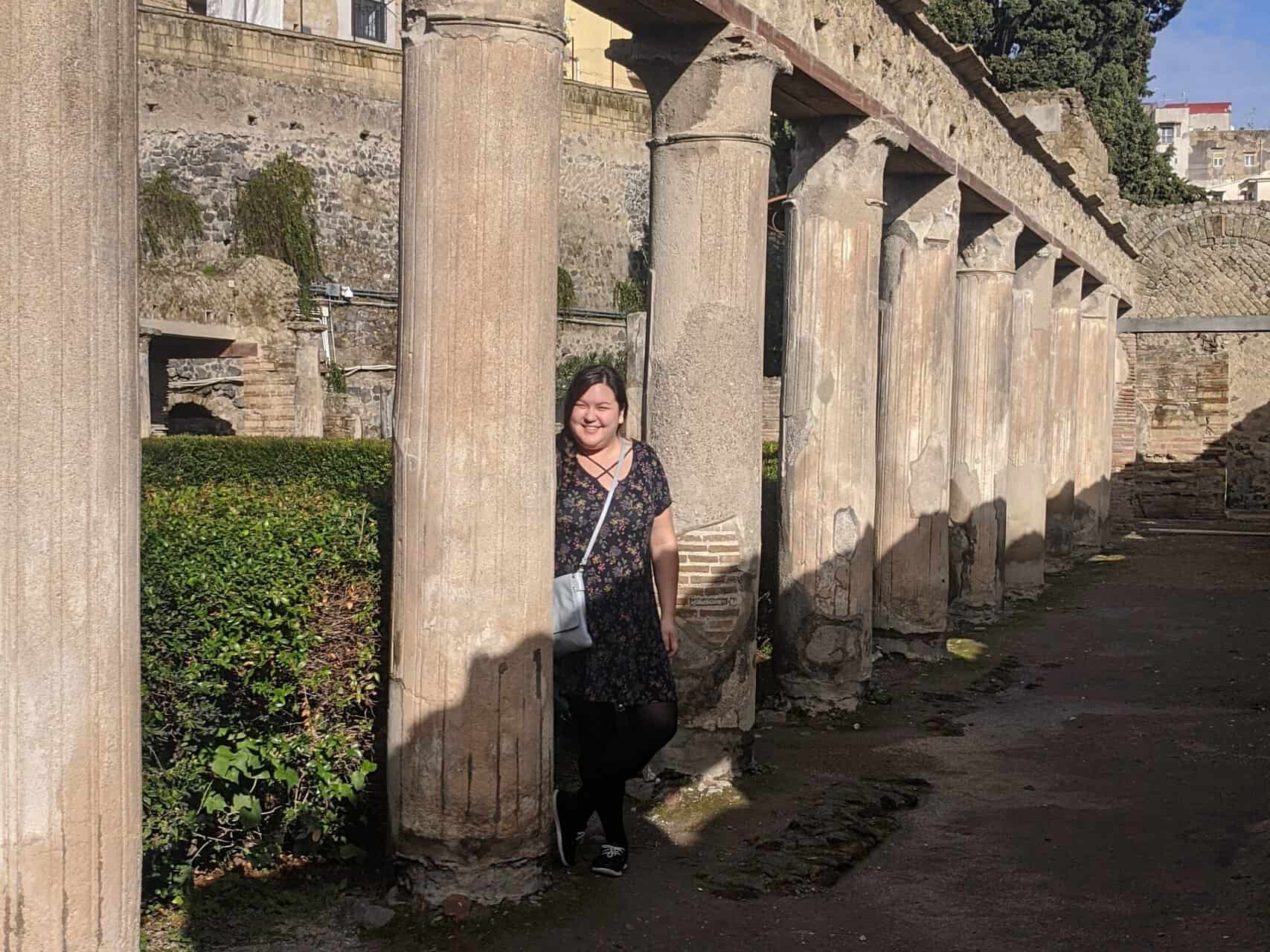
I have been lucky enough to travel to Italy four times and cross 11 UNESCO sites off my bucket list – so only 48 to go!
But I would love to do this full trip one day, seeing all of Italy’s 59 UNESCO World Heritage Sites on one long trek across the country.
In fact, I’ve actually extended this itinerary out to a nine month version and it’s now my new dream for how I’d want to spend a year-ish abroad!
I’m usually not one for checking things off a list just for the sake of checking them off or rushing around to see everything you’re “supposed” to see.
But there’s something fun about designing a trip around a challenge. Seeing all of Italy’s UNESCO sites is a really cool way to outline a trip and motivate you to keep exploring.
While it would technically be crossing things off a list, I think it would also mean a really immersive 90+ days in Italy exploring all parts of the country.
So whether you get to all 59 sites in one trip, visit them over a series of trips, or maybe don’t ever get to all of them, I hope this Italy itinerary has inspired you to check out a new part of the country.
I’d love to know: Which one of Italy’s UNESCO sites are you most excited to see?



